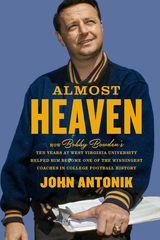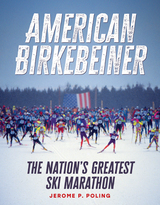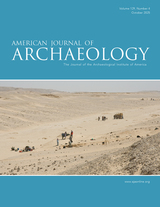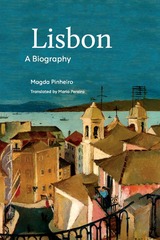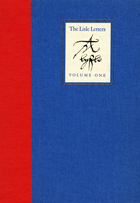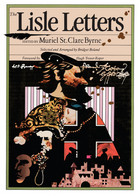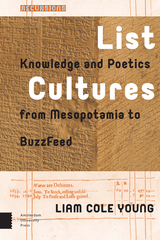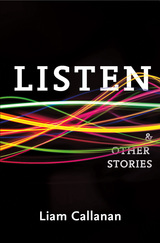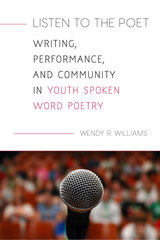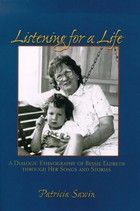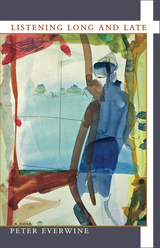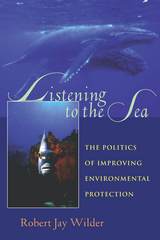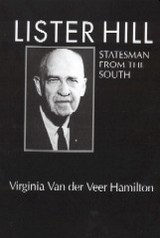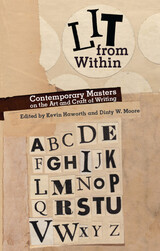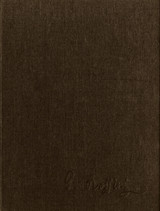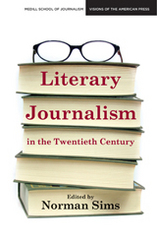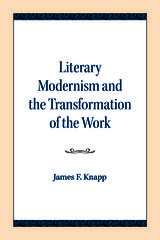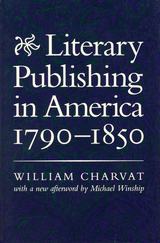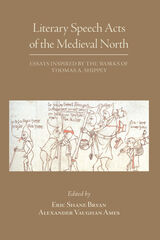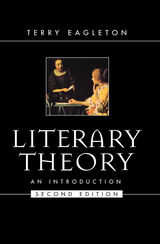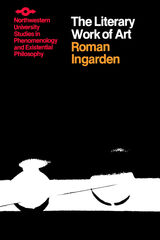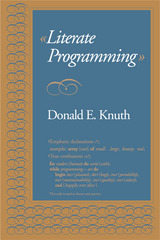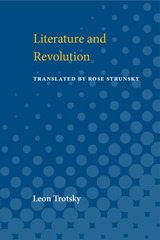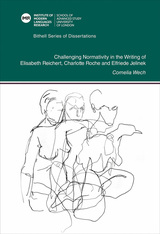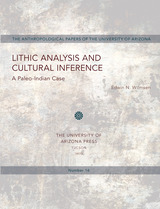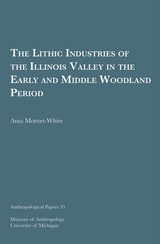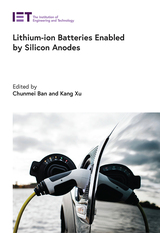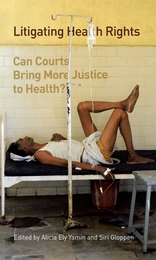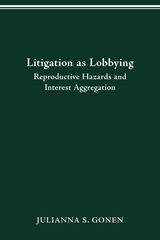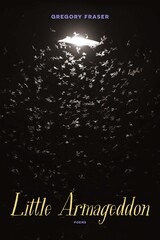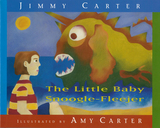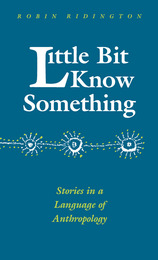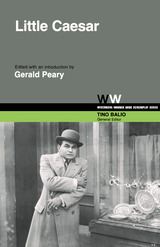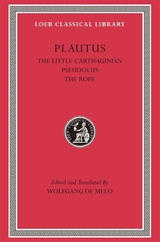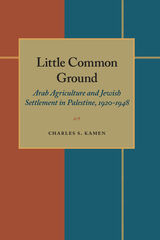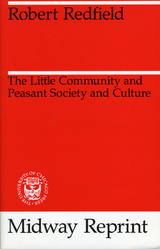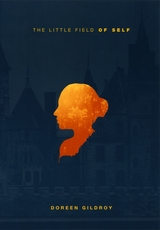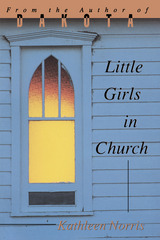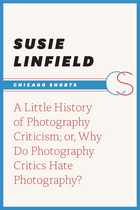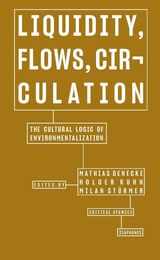 Liquidity, Flows, Circulation: The Cultural Logic of Environmentalization
Edited by Mathias Denecke, Holger Kuhn, and Milan Stürmer
Diaphanes, 2022 Interdisciplinary studies that combine the current of materialist thinking with discussions of ecologies and environmentalization.
Placed at the intersection of art, media, and cultural studies as well as economic theory, Liquidity, Flows, Circulation investigates the cultural logic of environmentalization. As flows, circulations, and liquidity resurface in all aspects of recent culture and contemporary art, this volume investigates the hypothesis of a genuine cultural logic of environmentalization through these three concepts.
It thus brings together two areas of research that have been largely separate. On the one hand, this volume takes up discussions about ecologies with and without nature and environmentalization as a contemporary form of power and capital. On the other hand, it takes its cue from Fredric Jameson’s notion that each stage of capitalism is accompanied by a genuine cultural logic. The volume introduces this current of materialist thinking into the ongoing discussions of ecologies and environmentalization. By analyzing contemporary art, architecture, theater, films, and literature, the fifteen contributions by scholars and artists explore different fields where liquid forms, semantics flow, or processes of circulation emerge as a contemporary cultural logic.
 Liquor and Labor in Southern Africa
Jonathan Crush
Ohio University Press, 1992 In June 1976 political demonstrations in the black township of Soweto exploded into an insurrection that would continue sporadically and spread to urban areas across South Africa. In their assault on apartheid the youths who spearheaded the rebellion attacked and often destroyed the state institutions that they linked to their oppression: police stations, government offices, schools, and state-owned liquor outlets. In Soweto alone during the first days of the revolt protestors smashed and burned eighteen beerhalls and a similar number of bottle stores; as the rebellion spread more were destroyed. This study sets out to demonstrate that liquor outlets were not simply convenient symbols of oppression. The anger that launched gasoline bombs into beerhalls across South Africa had specific origins in deep and complicated struggles over the control of alcohol production and consumption in South Africa. Conflict over alcohol has continuously intruded upon the lives of the black residents of southern African towns, cities, and labor compounds and upon the rural communities to which these people traced their origins. Yet the subject has received little systematic scholarly attention until now. In Liquor and Labor in Southern Africa scholars explore the complex relationship between alcohol use and the emergence of the modern urban-industrial system. In examining the role of alcohol in social control and the state, they also reveal the vibrant subcultures nurtured in beerhalls and underground shebeens and expose the bitter conflicts over alcohol that run along the fault lines of age, gender, class, and ethnicity.
Liquor Store Theatre
Maya Stovall
Duke University Press, 2020 For six years Maya Stovall staged Liquor Store Theatre, a conceptual art and anthropology video project---included in the Whitney Biennial in 2017---in which she danced near the liquor stores in her Detroit neighborhood as a way to start conversations with her neighbors. In this book of the same name, Stovall uses the project as a point of departure for understanding everyday life in Detroit and the possibilities for ethnographic research, art, and knowledge creation. Her conversations with her neighbors—which touch on everything from economics, aesthetics, and sex to the political and economic racism that undergirds Detroit's history—bring to light rarely acknowledged experiences of longtime Detroiters. In these exchanges, Stovall enacts an innovative form of ethnographic engagement that offers new modes of integrating the social sciences with the arts in ways that exceed what either approach can achieve alone.
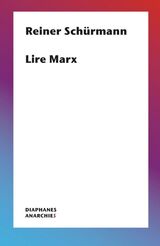 Lire Marx
Reiner Schürmann
Diaphanes, 2020 Le titre est, bien entendu, inspiré par Althusser (“Lire Le Capital”) – mais de façon polémique. Par “lire Marx” j'entends lire Marx et non pas Engels, Mao, Gramsci, Lukács, Marcuse, Althusser et ainsi de suite. En d'autres termes : le but de ce cours est, avant tout, de délibérément désintriquer la pensée de Marx de la pensée marxiste. Une polémique avec certains marxistes sera ainsi menée en sous-main, par des allusions ponctuelles. Un tel programme véhicule trois implications majeures : Qu'il y a effectivement une différence de pensée entre Marx et le marxisme. Ce premier point sera établi à travers une lecture philosophique de Marx : l'hypothèse étant que ce qui se trouve de plus original dans Marx, ce n'est ni sa pensée politique, ni sa pensée sociologique ou économique, mais bien sa charpente philosophique. Cette charpente philosophique détermine et situe ses autres théories. La seconde implication, c'est qu'un clivage entre Marx et les marxistes existe comme tel, qu'il peut être défini par certaines caractéristiques générales, et que ces caractéristiques générales différent de la pensée originale de Marx ou la restreignent. Il s'agit là d'un sujet passablement complexe, voire compliqué ; mais on peut résumer ce clivage en disant que le marxisme a surtout retenu de Marx les éléments utiles à l'action politique dans une situation donnée, urgente. Une théorie de la “praxis révolutionnaire” a donc pris la place de la philosophie. La troisième implication est la précompréhension qui préside à l'approche du texte. Un texte est quelque chose d'imprimé : il représente comme tel un objet clos, constitué, fini. Mais nous n'en obtiendrons de réponses décisives que si nous le soumettons à des questions décisives. Et la question décisive que soulèvent les marxistes, c'est l'urgence d'une situation révolutionnaire (qu'elle existe de fait ou doive être réalisée). Leur question est donc généralement homothétique à celle de Lénine : “Que faire ?” C'est la question de ceux qu'Althusser appelle les “intellectuels militants” (pour Marx 24), et qui participent directement aux luttes de la classe ouvrière. Une telle “ lecture” de Marx est stratégique. Or, je tiens que la lecture stratégique ne peut que rester aveugle, de par sa nature même, au questionnement philosophique. Notre précompréhension des textes de Marx n'a, par conséquent, rien de stratégique ; elle est bien plutôt qu'ils proposent une réponse à la plus ancienne question de la philosophie occidentale : ti to on, savoir : qu'est-ce que l'être ? ou : qu'est-ce que la réalité, ainsi que son corollaire : qu'est-ce que la vérité ? Donc : Marx versus marxisme ; le concept de “praxis” comme étant le concept différenciant Marx du marxisme ; une double théorie des textes. Développons plus avant ces trois points
Lisbon: A Biography
Magda Pinheiro
Tagus Press, 2019
Winner of the Máximo Special Jury Prize (2012)
Throughout the pages of this highly original and meticulously researched book, we follow the rich and fascinating history of Lisbon—European capital city and cosmopolitan metropolis—from its legendary founding by Ulysses to the present day, covering the most remarkable moments of the city, such as the conquest of Lisbon, the period of discoveries, the great earthquake of 1755, the departure of the royal court for Brazil, the Liberal revolts, the Estado Novo, Carnation Revolution, and Expo '98. Abounding with episodes that shaped the history of this vibrant port city, accounts of everyday life, and tales about traditional neighborhoods and the innumerable streets where we can still discover traces of the past, this amply illustrated and engaging book makes the seductively enchanting city of Lisbon come to life.
The Lisle Letters
Edited by Muriel St. Clare Byrne
University of Chicago Press, 1981 The Lisle Letters consist of the personal, official, and business correspondence of the household of Arthur Plantagenet, Viscount Lisle, the illegitimate but acknowledged son of Edward IV, during the years 1533 to 1540 when he was Lord Deputy of Calais. These seven critical years in English history were marked by the rise, ascendency, and fall of Thomas Cromwell and the letters reflect the mixture of passion, terror, and politics that was the court of Henry VIII. They also present the everyday concerns of the Lisle household. No other source provides such an abundance of detail about daily life - marriage, child rearing, education, clothing, food, and furnishing. The Lisle Letters are the Tudor world in microcosm.
The Lisle Letters: An Abridgement
Edited by Muriel St. Clare Byrne
University of Chicago Press, 1983 In a one-volume abridgement, these sixteenth-century letters paint a magnificent portrait of family life amidst the intrigue, terror, and politics of the court of Henry VIII. The culmination of Lord Lisle's imprisonment in the Tower of London.
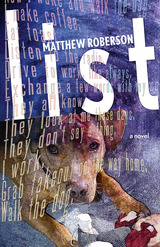 List: A Novel
Matthew Roberson
University of Alabama Press, 2014 Vignettes of a middle-class American family told through lists, each reflecting their obsessions, their complaints, their desires, and their humanity.
A suburban family of four—a man, woman, boy, and girl—struggle through claustrophobic days crowded with home improvement projects, conflicts at work and school, a job loss, illnesses, separation, and the wearying confrontation with aging. The accoutrements of modern life—electronic devices and vehicles—have ceased to be tools that support them and have become instead the central fulcrums around which their lives wheel as they chase “cleanliness” and other high virtues of middle American life.
In Matthew Roberson’s hands, the family’s list-making transcends the simple goal of planning. Their lists reveal the aspirations and anxieties that lie beneath the superficial clatter of everyday activities. Fearing the aimless chaos of unplanned days, the family compulsively compiles lists as maps to steer them away from uncertainty and failure, and yet at what point does a list stop being a map and become the final destination? The family creates an illusory cloud of meaningful activity but cannot stave off the mortal entropies that mark the suburban middle class.
List Cultures: Knowledge and Poetics from Mesopotamia to BuzzFeed
Liam Cole Young
Amsterdam University Press, 2017 We live in an age of lists, from magazine features to online clickbait. This book situates the list in a long tradition, asking key questions about the list as a cultural and communicative form. What, Liam Cole Young asks, can this seemingly innocuous form tell us about historical and contemporary media environments and logistical networks? Connecting German theories of cultural techniques to Anglo-American approaches that address similar issues, List Cultures makes a major contribution to debates about New Materialism and the post-human turn.
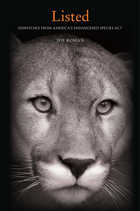 Listed: Dispatches from America’s Endangered Species Act
Joe Roman
Harvard University Press, 2011 The first listed species to make headlines after the Endangered Species Act was passed in 1973 was the snail darter, a three-inch fish that stood in the way of a massive dam on the Little Tennessee River. When the Supreme Court sided with the darter, Congress changed the rules. The dam was built, the river stopped flowing, and the snail darter went extinct on the Little Tennessee, though it survived in other waterways. A young Al Gore voted for the dam; freshman congressman Newt Gingrich voted for the fish.
A lot has changed since the 1970s, and Joe Roman helps us understand why we should all be happy that this sweeping law is alive and well today. More than a general history of endangered species protection, Listed is a tale of threatened species in the wild—from the whooping crane and North Atlantic right whale to the purple bankclimber, a freshwater mussel tangled up in a water war with Atlanta—and the people working to save them.
Employing methods from the new field of ecological economics, Roman challenges the widely held belief that protecting biodiversity is too costly. And with engaging directness, he explains how preserving biodiversity can help economies and communities thrive. Above all, he shows why the extinction of species matters to us personally—to our health and safety, our prosperity, and our joy in nature.
Listen & Other Stories
Liam Callanan
Four Way Books, 2015 Listen is a book where characters ask readers to do just that: listen to their stories, especially because many aren’t the type of people who often get listened to—even though they should. These characters’ trials, missed connections, and sundry challenges are full of surprises—some good, some bad, some funny, some wise, and some all this at once. Perhaps most surprising of all, there’s tenderness here and a lot of heart—which often gets the collection’s characters into a lot of trouble.
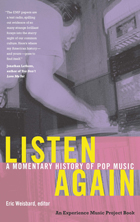 Listen Again: A Momentary History of Pop Music
Eric Weisbard, ed.
Duke University Press, 2007 Arguing that pop music turns on moments rather than movements, the essays in Listen Again pinpoint magic moments from a century of pop eclecticism, looking at artists who fall between genre lines, songs that sponge up influences from everywhere, and studio accidents with unforeseen consequences. Listen Again collects some of the finest presentations from the celebrated Experience Music Project Pop Conference, where journalists, musicians, academics, and other culturemongers come together once each year to stretch the boundaries of pop music culture, criticism, and scholarship. Building a history of pop music out of unexpected instances, critics and musicians delve into topics from the early-twentieth-century black performer Bert Williams’s use of blackface, to the invention of the Delta blues category by a forgotten record collector named James McKune, to an ER cast member’s performance as the Germs’ front man Darby Crash at a Germs reunion show. Cuban music historian Ned Sublette zeroes in on the signature riff of the garage-band staple “Louie, Louie.” David Thomas of the pioneering punk band Pere Ubu honors one of his forebears: Ghoulardi, a late-night monster-movie host on Cleveland-area TV in the 1960s. Benjamin Melendez discusses playing in a band, the Ghetto Brothers, that Latinized the Beatles, while leading a South Bronx gang, also called the Ghetto Brothers. Michaelangelo Matos traces the lineage of the hip-hop sample “Apache” to a Burt Lancaster film. Whether reflecting on the ringing freedom of an E chord or the significance of Bill Tate, who performed once in 1981 as Buddy Holocaust and was never heard from again, the essays reveal why Robert Christgau, a founder of rock criticism, has called the EMP Pop Conference “the best thing that’s ever happened to serious consideration of pop music.” Contributors. David Brackett, Franklin Bruno, Daphne Carr, Henry Chalfant, Jeff Chang, Drew Daniel, Robert Fink, Holly George-Warren, Lavinia Greenlaw, Marybeth Hamilton, Jason King, Josh Kun, W. T. Lhamon, Jr., Greil Marcus, Michaelangelo Matos, Benjamin Melendez, Mark Anthony Neal, Ned Sublette, David Thomas, Steve Waksman, Eric Weisbard
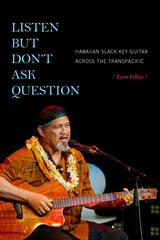 Listen but Don't Ask Question: Hawaiian Slack Key Guitar across the TransPacific
Kevin Fellezs
Duke University Press, 2019 Performed on an acoustic steel-string guitar with open tunings and a finger-picking technique, Hawaiian slack key guitar music emerged in the mid-nineteenth century. Though performed on a non-Hawaiian instrument, it is widely considered to be an authentic Hawaiian tradition grounded in Hawaiian aesthetics and cultural values. In Listen But Don’t Ask Question Kevin Fellezs listens to Kanaka Maoli (Native Hawaiian) and non-Hawaiian slack key guitarists in Hawai‘i, California, and Japan, attentive to the ways in which notions of Kanaka Maoli belonging and authenticity are negotiated and articulated in all three locations. In Hawai‘i, slack key guitar functions as a sign of Kanaka Maoli cultural renewal, resilience, and resistance in the face of appropriation and occupation, while in Japan it nurtures a merged Japanese-Hawaiian artistic and cultural sensibility. For diasporic Hawaiians in California, it provides a way to claim Hawaiian identity. By demonstrating how slack key guitar is a site for the articulation of Hawaiian values, Fellezs illuminates how slack key guitarists are reconfiguring notions of Hawaiian belonging, aesthetics, and politics throughout the transPacific.
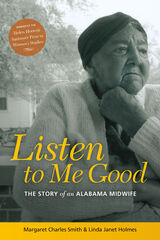 Listen to Me Good: The Story of an Alabama Midwife
Margaret Charles Smith and Linda Janet Holmes
Ohio State University Press, 1996 Margaret Charles Smith, a ninety-one-year-old Alabama midwife, has thousands of birthing stories to tell. Sifting through nearly five decades of providing care for women in rural Greene County, she relates the tales that capture the life-and-death struggle of the birthing experience and the traditions, pharmacopeia, and spiritual attitudes that influenced her practice. She debunks images of the complacent southern “granny” midwife and honors the determination, talent, and complexity of midwifery.
Fascinating to read, this book is part of the new genre of writing that recognizes the credibility of midwives who have emerged from their own communities and were educated through apprenticeship and personal experience. Past descriptions of southern black midwives have tended to denigrate their work in comparison with professional established medicine. Believed to be the oldest living (though retired) traditional African American midwife in Alabama, Smith is one of the few who can recount old-time birthing ways. Despite claims that midwives contributed to high infant mortality rates, Smith’s story emphasizes midwives' successes in facing medical challenges and emergencies.
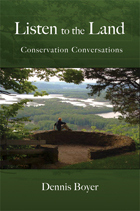 Listen to the Land: Conservation Conversations
Dennis Boyer
University of Wisconsin Press, 2009 Inspired by years of talking with farmers, foragers, loggers, tribal activists, seed savers, fishers, railroaders, and nature lovers of all stripes, Dennis Boyer has created in Listen to the Land a fascinating communal conversation that invites readers to ponder their own roles in grassroots environmentalism. The nearly fifty voices that Boyer recreates here cross genders, generations, and geography. They include an Ojibwe leader contemplating nuclear waste, a houseboat dweller, a woman sharing her skills in gathering edible plants, a caboose-tender, a Milwaukeean fighting urban blight—even a recluse who shoots out streetlights.
Each of the extraordinarily varied perspectives that Boyer recreates here considers the question, How do I interact with the Earth? Each has something important to say that expands our understanding of conservation and environmentalism. Listen to the Land encourages you to read a conversation or two and then go outside and start one of your own.
Listen to the Poet: Writing, Performance, and Community in Youth Spoken Word Poetry
Wendy R. Williams
University of Massachusetts Press, 2019 Youth spoken word poetry groups are on the rise in the United States, offering safe spaces for young people to write and perform. These diverse groups encourage members to share their lived experiences, decry injustices, and imagine a better future. At a time when students may find writing in school alienating and formulaic, composing in these poetry groups can be refreshingly relevant and exciting.
Listen to the Poet investigates two Arizona spoken word poetry groups—a community group and a high school club—that are both part of the same youth organization. Exploring the writing lives and poetry of several members, Wendy R. Williams takes readers inside a writing workshop and poetry slam and reveals that schools have much to learn about writing, performance, community, and authorship from groups like these and from youth writers themselves.
Listen to Your Work: Job-Active Advice from a Battle-Scarred Mentor
Collins Andrews
Parkhurst Brothers, Inc., 2009 This is an easy-to-read guide for mentors, mentees, professors of business, and business graduates is a must-read for all professionals written by a retired senior manager. Although intended for a business audience, the advice in this book is appropriate for employers and employees from any discipline. With chapter headings like Teaming and Trust, Communication, Humanity in Business, and The Bottom Line; Work Hard, Do Right, and Have Fun, it is apparent that this man understands what motivates people to do their best work and how to communicate his ideas to employers and employees alike.
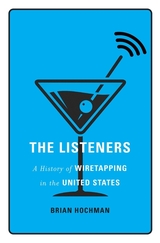 The Listeners: A History of Wiretapping in the United States
Brian Hochman
Harvard University Press, 2022 They’ve been listening for longer than you think. A new history reveals how—and why.
Wiretapping is nearly as old as electronic communications. Telegraph operators intercepted enemy messages during the Civil War. Law enforcement agencies were listening to private telephone calls as early as 1895. Communications firms have assisted government eavesdropping programs since the early twentieth century—and they have spied on their own customers too. Such breaches of privacy once provoked outrage, but today most Americans have resigned themselves to constant electronic monitoring. How did we get from there to here?
In The Listeners, Brian Hochman shows how the wiretap evolved from a specialized intelligence-gathering tool to a mundane fact of life. He explores the origins of wiretapping in military campaigns and criminal confidence games and tracks the use of telephone taps in the US government’s wars on alcohol, communism, terrorism, and crime. While high-profile eavesdropping scandals fueled public debates about national security, crime control, and the rights and liberties of individuals, wiretapping became a routine surveillance tactic for private businesses and police agencies alike.
From wayward lovers to foreign spies, from private detectives to public officials, and from the silver screen to the Supreme Court, The Listeners traces the long and surprising history of wiretapping and electronic eavesdropping in the United States. Along the way, Brian Hochman considers how earlier generations of Americans confronted threats to privacy that now seem more urgent than ever.
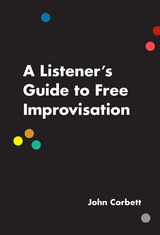 A Listener's Guide to Free Improvisation
John Corbett
University of Chicago Press, 2016 Improvisation rattles some listeners. Maybe they’re even suspicious of it. John Coltrane’s saxophonic flights of fancy, Jimi Hendrix’s feedback drenched guitar solos, Ravi Shankar’s sitar extrapolations—all these sounds seem like so much noodling or jamming, indulgent self-expression. “Just” improvising, as is sometimes said. For these music fans, it seems natural that music is meant to be composed. In the first book of its kind, John Corbett’s A Listener’s Guide to Free Improvisation provides a how-to manual for the most extreme example of spontaneous improvising: music with no pre-planned material at all. Drawing on over three decades of writing about, presenting, playing, teaching, and studying freely improvised music, Corbett offers an enriching set of tools that show any curious listener how to really listen, and he encourages them to enjoy the human impulse— found all around the world— to make up music on the spot.
Corbett equips his reader for a journey into a difficult musical landscape, where there is no steady beat, no pre-ordained format, no overarching melodic or harmonic framework, and where tones can ring with the sharpest of burrs. In “Fundamentals,” he explores key areas of interest, such as how the musicians interact, the malleability of time, overcoming impatience, and watching out for changes and transitions; he grounds these observations in concrete listening exercises, a veritable training regime for musical attentiveness. Then he takes readers deeper in “Advanced Techniques,” plumbing the philosophical conundrums at the heart of free improvisation, including topics such as the influence of the audience and the counterintuitive challenge of listening while asleep. Scattered throughout are helpful and accessible lists of essential resources—recordings, books, videos— and a registry of major practicing free improvisors from Noël Akchoté to John Zorn, particularly essential because this music is best experienced live.
The result is a concise, humorous, and inspiring guide, a unique book that will help transform one of the world’s most notoriously unapproachable artforms into a rewarding and enjoyable experience.
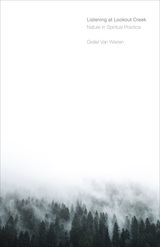 Listening at Lookout Creek: Nature in Spiritual Practice
Gretel Van Wieren
Oregon State University Press, 2019 Gretel Van Wieren’s family cabin, the Cedar Shack, in northwest Michigan’s Manistee National Forest, is where she learned to fish and wade in rivers, build fires, send smoke signals, and distinguish false from true morels. It’s where she came to love the water and woods, and where she is now trying to teach her children to do the same. But decades of moving from place to place—from Eastern Africa to New England—have made trips back to the Cedar Shack scarce and short-lived. Even after moving back to Michigan, she and her husband’s obligations as university professors and parents of three overscheduled teenagers have made forest time rare and brief.
It wasn’t always like this. For years, Van Wieren studied and attempted to emulate the lives of the mystics. As a pastor in rural, dairy-farming New York, she walked the fields and woods behind the parsonage daily. Remembering that time in her life, Van Wieren concludes that she is out of practice, and she goes to the H. J. Andrews Experimental Forest in Oregon’s western Cascade Mountains to conduct a spiritual experiment: Is it possible to rediscover a deep sense of connection with the natural world, and can it be done, with children, in today’s high-tech, hyper-busy world?
Listening at Lookout Creek weaves philosophical and spiritual interpretations of the natural world with personal, hands-on experiences of particular landed places. It will be of interest to students of environmental ethics, religion, and nature, conservation practitioners, hunting and fishing enthusiasts, and all those who work to connect children with nature.
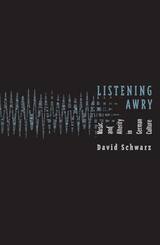 Listening Awry: Music And Alterity In German Culture
David Schwarz
University of Minnesota Press, 2006 In his first book, Listening Subjects, David Schwarz succeeded in fusing post-Lacanian psychoanalytic, musical-theoretical, and musical-historical perspectives. In Listening Awry, he expands his project to “tell a story of historical modernism writ large”—how German music spanning two centuries refracts changes in society and culture, as well as the impacts of concepts introduced by psychoanalysis.Schwarz shows how post-Lacanian psychoanalysis can be applied to ideological interpellation that connects psychoanalysis to culture and how music theory can ground these considerations in precise details of musical textuality. He “listens awry” in several ways: by understanding musical meaning in both objective and socially structured ways, by embracing historical and also aesthetic approaches, by addressing high art as well as popular music, and by listening “around” conventional forms of musical meaning to reach toward that which evades signification.Structured around four themes—trauma, the other/Other, the look/gaze binary, and Judaism—Listening Awry explores five key moments in post-Enlightenment music: the rise of the singular orchestral conductor and the emergence of a new form of alterity, the Art Song and “the sublime of the delicate” (a correlate of the Kantian mathematical and dynamical sublime), the birth of psychoanalysis and the twentieth-century turn toward atonality, German war songs and the subversion of German music by the Nazis, and two different versions of Wagner’s Parsifal that were performed one hundred years apart and in radically different contexts.This highly original work, filled with imaginative readings and disquieting observations, links trauma with the culture and history of modernity and German music, deftly tying the experience of the body to the sounds it hears: how it reaches us slowly, penetrates the skin, and resonates.David Schwarz is assistant professor of music at the University of North Texas. He is the author of Listening Subjects: Music, Psychoanalysis, Culture.
The Listening Chamber: Poems
William Aberg
University of Arkansas Press, 1997 Winner of the seventh annual Arkansas Poetry Award, William Aberg presents in The Listening Chamber a gallery of poetic forms, from short free-verse lyrics and crafted prose poems to original forms skillfully matched with their subjects. He writes comfortably of cats or derringers, the idylls of childhood, or of patients in mental hospitals. Throughout his poetry there runs a proletarian strain of dissatisfaction, an unrest coupled with dexterous wit and a remarkable sense of wonder. Convincingly, he populates these poems with farm workers, romantics, fugitives, lovers, beeches, elms, and constellations. With influences as wide ranging as William Stafford, Miklos Radnoti, and René Magritte, Aberg has fashioned a first collection in which every poem is a unique and haunting experience.
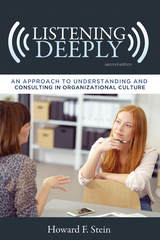 Listening Deeply: An Approach to Understanding and Consulting in Organizational Culture, Second Edition
Howard F. Stein
University of Missouri Press, 2017 Listening deeply is the foundation of all effective organizational management, research, and consulting. This book explores the many aspects of attentive listening through storytelling and includes examples of organizational case studies. In Stein’s practice, listening deeply is an attitude evoked by the psychoanalytic concept of hovering attention—a careful attending to the person or group one is trying to help and an equally careful attending to how one is hearing these others. The listener’s own feelings are as crucially diagnostic as what the consultant observes in other people.
This new edition of Listening Deeply updates historical context, theory, method, and organizational stories. A psychodynamic orientation informs much of the book and the language Stein uses is direct. His lessons are useful to the manager in any kind of organization, as well as practitioners of psychology, sociology, business management, medicine, and education.
Listening For A Life: A Dialogic Ethnography of Bessie Eldreth through Her Songs and Stories
Patricia Sawin
Utah State University Press, 2004 In one sense a folklorist's portrayal of a notable folk artist's life and art, Listening for a Life is equally a rethinking of the processes involved in such work, not only in how the folklorist conveys her subject but in how her subject constitutes and performs herself into being through dialogue with others: those present, those once present, those imagined and anticipated. Drawing on Bahktinian and feminist theory, Sawin pushes forward our understanding of the interactive roles of ethnographer and subject and in the process gives us a deeper understanding of folk singer and storyteller Bessie Eldreth and her greatest art, herself.
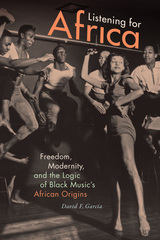 Listening for Africa: Freedom, Modernity, and the Logic of Black Music's African Origins
David F. Garcia
Duke University Press, 2017 In Listening for Africa David F. Garcia explores how a diverse group of musicians, dancers, academics, and activists engaged with the idea of black music and dance’s African origins between the 1930s and 1950s. Garcia examines the work of figures ranging from Melville J. Herskovits, Katherine Dunham, and Asadata Dafora to Duke Ellington, Dámaso Pérez Prado, and others who believed that linking black music and dance with Africa and nature would help realize modernity’s promises of freedom in the face of fascism and racism in Europe and the Americas, colonialism in Africa, and the nuclear threat at the start of the Cold War. In analyzing their work, Garcia traces how such attempts to link black music and dance to Africa unintentionally reinforced the binary relationships between the West and Africa, white and black, the modern and the primitive, science and magic, and rural and urban. It was, Garcia demonstrates, modernity’s determinations of unraced, heteronormative, and productive bodies, and of scientific truth that helped defer the realization of individual and political freedom in the world.
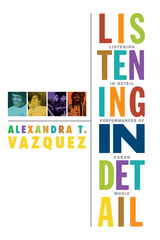 Listening in Detail: Performances of Cuban Music
Alexandra T. Vazquez
Duke University Press, 2013 Listening in Detail is an original and impassioned take on the intellectual and sensory bounty of Cuban music as it circulates between the island, the United States, and other locations. It is also a powerful critique of efforts to define "Cuban music" for ethnographic examination or market consumption. Contending that the music is not a knowable entity but a spectrum of dynamic practices that elude definition, Alexandra T. Vazquez models a new way of writing about music and the meanings assigned to it. "Listening in detail" is a method invested in opening up, rather than pinning down, experiences of Cuban music. Critiques of imperialism, nationalism, race, and gender emerge in fragments and moments, and in gestures and sounds through Vazquez's engagement with Alfredo Rodríguez's album Cuba Linda (1996), the seventy-year career of the vocalist Graciela Pérez, the signature grunt of the "Mambo King" Dámaso Pérez Prado, Cuban music documentaries of the 1960s, and late-twentieth-century concert ephemera.
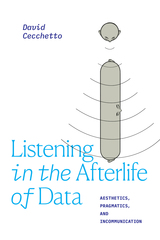 Listening in the Afterlife of Data: Aesthetics, Pragmatics, and Incommunication
David Cecchetto
Duke University Press, 2022 In Listening in the Afterlife of Data, David Cecchetto theorizes sound, communication, and data by analyzing them in the contexts of the practical workings of specific technologies, situations, and artworks. In a time he calls the afterlife of data—the cultural context in which data’s hegemony persists even in the absence of any belief in its validity—Cecchetto shows how data is repositioned as the latest in a long line of concepts that are at once constitutive of communication and suggestive of its limits. Cecchetto points to the failures and excesses of communication by focusing on the power of listening—whether through wearable technology, internet-based artwork, or the ways in which computers process sound—to pragmatically comprehend the representational excesses that data produces. Writing at a cultural moment in which data has never been more ubiquitous or less convincing, Cecchetto elucidates the paradoxes that are constitutive of computation and communication more broadly, demonstrating that data is never quite what it seems.
Listening Long and Late
Peter Everwine
University of Pittsburgh Press, 2013 “What a rich array of music lies within <I>Listening Long and Late.</I> With refreshing authenticity, Everwine weds playfulness to practice, lyricism to narrative, pathos to the ordinary. Indeed, he has listened ‘long and late’ to the music of such venerable masters as Tu Fu, the hidden genius on the street, and the anonymous Aztec poets of the fourteenth and fifteenth centuries. Everwine writes with the same ‘deified heart’ that divines the mystery of his quotidian subjects in a language that is at once plain and poetic. His own work seamlessly segues into his translations from the Hebrew and Nahuatl, as if all the poems belonged to the same poet, which they in fact do, as the glorious multitudes of Peter Everwine, one of the masters of our age.”—Chard deNiord
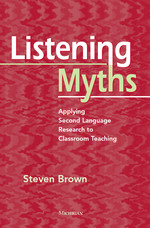 Listening Myths: Applying Second Language Research to Classroom Teaching
Steven Brown
University of Michigan Press, 2011 This volume was conceived as a "best practices" resource for teachers of ESL listening courses in the way that Vocabulary Myths by Keith S. Folse (and Writing Myths by Joy Reid) is one for reading and vocabulary teachers. It was written to help ensure that teachers of listening are not perpetuating the myths of teaching listening. Both the research and pedagogy in this book are based on the newest research in the field of second language acquisition. Steven Brown is the author of the Active Listening textbook series and is a teacher trainer. The myths debunked in this book are: § Listening is the same as reading. § Listening is passive. § Listening equals comprehension. § Because L1 language ability is effortlessly acquired, L2 listening ability is too. § Listening means listening to conversations. § Listening is an individual, inside-the-head process. § Students should only listen to authentic materials. § Listening can’t be taught
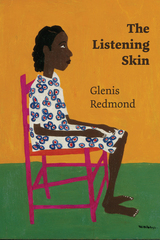 The Listening Skin
Glenis Redmond
Four Way Books, 2022 Hewing close to the bone, the incendiary poems in The Listening Skin explore how an artist dares to dance and create through a pain-riddled body. Corporeal and spiritual, immediately personal and deeply historical, Redmond's latest collection details how generational cycles of poverty, mental and physical illness, and systemic racism impact the self, the family, and the greater African-American collective. Examining the connection between adverse childhood experiences and adult chronic conditions, Redmond's poems arise from her deepest listening, beyond the skin, rooted in the marrow. They speak to the hardship of enduring fibromyalgia and the ongoing challenges of multiple myeloma while rejoicing in survival and the grace of existence itself. Yes, The Listening Skin affirms life and demands the dignity its speaker deserves: "I am full of this past present heat / I carry. / I come to the shore, / but I vacate nothing." This consummate work honors embodied knowledge, all that's heard at the boundary between flesh and air, vacating nothing, determinedly and brilliantly whole.
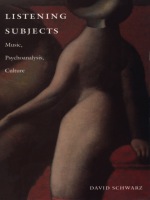 Listening Subjects: Music, Psychoanalysis, Culture
David Schwarz
Duke University Press, 1997 In Listening Subjects, David Schwarz uses psychoanalytic techniques to probe the visceral experiences of music listeners. Using classical, popular, and avant-garde music as texts, Schwarz addresses intriguing questions: why do bodies develop goose bumps when listening to music and why does music sound so good when heard "all around?" By concentrating on music as cultural artifact, Listening Subjects shows how the historical conditions under which music is created affect the listening experience.
Schwarz applies the ideas of post-Lacanian psychoanalytic theorists Slavoj Zizek, Julia Kristeva, and Kaja Silverman to an analysis of diverse works. In a discussion of John Adams’s opera Nixon in China, he presents music listening as a fantasy of being enclosed in a second skin of enveloping sound. He looks at the song cycles of Franz Schubert as an examination and expression of epistemological doubts at the advent of modernism, and traverses fantasy "space" in his exploration of the white noise at the end of the Beatles’ "I Want You (She’s So Heavy)." Schwarz also considers the psychosexual undercurrent in Peter Gabriel’s "Intruder" and the textual and ideological structures of German Oi Musik. Concluding with a reading of two compositions by Diamanda Galás, he reveals how some performances can simultaneously produce terror and awe, abjection and rage, pleasure and displeasure. This multilayered study transcends other interventions in the field of musicology, particularly in its groundbreaking application of literary theory to popular and classical music.
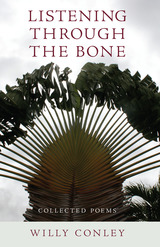 Listening through the Bone: Collected Poems
Willy Conley
Gallaudet University Press, 2018 I don’t write "with the ear" as most poets do, but with the eye. As Deaf people are apt to do, we become attuned to our world through tactile means, listening through the bone for vibrations, sensing shifts in air currents, recognizing wafting odors, observing fluctuations and reflections of light and movements in the water. In Listening through the Bone, Willy Conley bears witness to life’s moments and renders them into poems that are at once irreverent and tender. His poetry examines life cycles, the natural world, and his experiences as a Deaf individual. It is presented in five parts: - Inaudibles
- Existentials
- Quizzicals
- Irrevocables
- Environmentals
Conley’s thoughts on the banal and the bizarre include translations of poetry from American Sign Language to English. His identity as a Deaf poet lends a strong visual aspect to his work. This collection is accompanied by the author’s photographs, including “watergraphs” that reveal inverted images reflected in pools of water.
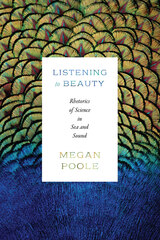 Listening to Beauty: Rhetorics of Science in Sea and Sound
Megan Poole
University of Chicago Press, 2025 A moving study of how encounters with beauty advance scientific discovery.
Our attempts to understand the world are always more than simply rational. Our bodies learn through lived experience, our natural environments challenge what we think we know, and we take lessons from our nonhuman kin. Even scientists, often considered paragons of rationality, frequently describe their findings in the language of beauty. For rhetorician Megan Poole, beauty is integral to how scientific research works.
Drawing on interviews with leading biologists, Poole explores what happens when scientists set aside objectivity and listen for beauty around them. The wonder we feel at the plumage of birds, the melodies of whales, or the caretaking of elephants may not help us (on its own) to isolate a given fact, but such encounters may teach us to open ourselves to a different way of knowing entirely. Through stories about researchers’ encounters with wonder, Listening to Beauty reveals how scientific discovery happens sometimes unsystematically, sometimes incoherently, often beautifully.
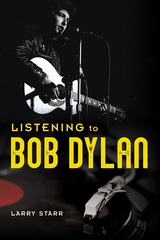 Listening to Bob Dylan
Larry Starr
University of Illinois Press, 2021 Venerated for his lyrics, Bob Dylan in fact is a songwriting musician with a unique mastery of merging his words with music and performance. Larry Starr cuts through pretention and myth to provide a refreshingly holistic appreciation of Dylan's music. Ranging from celebrated classics to less familiar compositions, Starr invites readers to reinvigorate their listening experiences by sharing his own—sometimes approaching a song from a fresh perspective, sometimes reeling in surprise at discoveries found in well-known favorites. Starr breaks down often-overlooked aspects of the works, from Dylan's many vocal styles to his evocative harmonica playing to his choices as a composer. The result is a guide that allows listeners to follow their own passionate love of music into hearing these songs—and personal favorites—in new ways. Reader-friendly and revealing, Listening to Bob Dylan encourages hardcore fans and Dylan-curious seekers alike to rediscover the music legend.
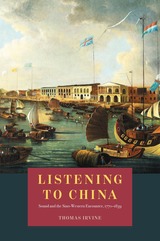 Listening to China: Sound and the Sino-Western Encounter, 1770-1839
Thomas Irvine
University of Chicago Press, 2020 From bell ringing to fireworks, gongs to cannon salutes, a dazzling variety of sounds and soundscapes marked the China encountered by the West around 1800. These sounds were gathered by diplomats, trade officials, missionaries, and other travelers and transmitted back to Europe, where they were reconstructed in the imaginations of writers, philosophers, and music historians such as Jean-Philippe Rameau, Johann Nikolaus Forkel, and Charles Burney. Thomas Irvine gathers these stories in Listening to China, exploring how the sonic encounter with China shaped perceptions of Europe’s own musical development.
Through these stories, Irvine not only investigates how the Sino-Western encounter sounded, but also traces the West’s shifting response to China. As the trading relationships between China and the West broke down, travelers and music theorists abandoned the vision of shared musical approaches, focusing instead on China’s noisiness and sonic disorder and finding less to like in its music. At the same time, Irvine reconsiders the idea of a specifically Western music history, revealing that it was comparison with China, the great “other,” that helped this idea emerge. Ultimately, Irvine draws attention to the ways Western ears were implicated in the colonial and imperial project in China, as well as to China’s importance to the construction of musical knowledge during and after the European Enlightenment. Timely and original, Listening to China is a must-read for music scholars and historians of China alike.
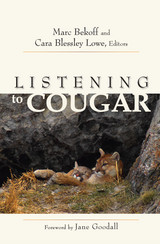 Listening to Cougar
Marc Bekoff
University Press of Colorado, 2007 This spellbinding tribute to Puma concolor honors the big cat's presence on the land and in our psyches. In some essays, the puma appears front and center: a lion leaps over Rick Bass's feet, hurtles off a cliff in front of J. Frank Dobie, gazes at Julia Corbett when she opens her eyes after an outdoor meditation, emerges from the fog close enough for poet Gary Gildner to touch. Marc Bekoff opens his car door for a dog that turns out to be a lion. Other works evoke lions indirectly. Biologists describe aspects of cougar ecology, such as its rugged habitat and how males struggle to claim territory. Conservationists relate the political history of America's greatest cat. Short stories and essays consider lions' significance to people, reflecting on accidental encounters, dreams, Navajo beliefs, guided hunts, and how vital mountain lions are to people as symbols of power and wildness. Contributors include: Rick Bass, Marc Bekoff, Janay Brun, Julia B. Corbett, Deanna Dawn, J. Frank Dobie, Suzanne Duarte, Steve Edwards, Joan Fox, Gary Gildner, Wendy Keefover-Ring, Ted Kerasote, Christina Kohlruss, Barry Lopez, BK Loren, Cara Blessley Lowe, Steve Pavlik, David Stoner, and Linda Sweanor. Marc Bekoff has published twenty books, including The Emotional Lives of Animals, and is a professor emeritus of ecology and evolutionary biology at the University of Colorado at Boulder. Writer and photographer Cara Blessley Lowe is author of Spirit of the Rockies and co-founder of The Cougar Fund. BK Loren, in Listening to Cougar: "If the lion, in all its dark, nocturnal otherness, in all its light, internal sameness, does not exist for future generations, if we destroy its habitat, or call open season on it, what could we possibly find to replace it? It is precisely because we fear large predators that we need them. They hold within them so many things that we have lost, or are on the verge of losing, personally and collectively, permanently and forever. If we sacrifice the fear, we also sacrifice the strength, the wildness, the beauty, the awe." Foreword by Jane Goodall
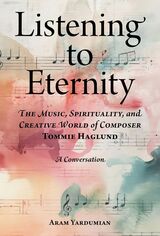 Listening to Eternity: The Music, Spirituality, and Creative World of Composer Tommie Haglund
Aram Yardumian
Swedenborg Foundation Publishers, 2025 Listening to Eternity invites readers on an extraordinary journey through the life and creative process of Tommie Haglund, one of Sweden's most renowned contemporary classical composers. His music, often described as introspective and spiritual, has touched audiences worldwide with its depth and emotional clarity. Author and scholar Aram Yardumian, through a series of intimate conversations, reveals a vivid portrait of an artist whose music is inextricably linked to his spiritual experiences and personal struggles.
Formative Years
From the opening pages, we are drawn into Haglund's world, beginning with his earliest musical memories. The composer recalls the profound impact of his aunt Margreth's voice: “The heart of my music started with that voice.” This early connection between sound and emotion sets the stage for Haglund's lifelong exploration of music's power to evoke and express the deepest human experiences.
The book doesn't shy away from the challenges Haglund faced in his youth. We learn of his difficult relationship with his father and a prolonged hospital stay at a young age. These experiences, while painful, proved formative for the young musician. Haglund's description of listening to radio static in the hospital, imagining himself traveling through space, offers a poignant glimpse into the imaginative world that would later inform his compositions.
Creative Evolution
This book does not simply recount Haglund’s life; it explores the very essence of the creative process itself. Readers will find themselves captivated by Haglund's musical journey, from his first encounters with classical music to his development as a composer. The book details pivotal moments, such as hearing Mozart's Piano Concerto no. 21 for the first time, a visit to a medium, and his studies with the unconventional but inspiring teacher Claes-Göran Bjerding. These anecdotes not only chart Haglund's growth as a musician but also reveal the depth of his passion for music from an early age.
Haglund translates emotions, physical sensations, and spiritual experiences into sound. His approach to composition challenges conventional notions of music-making and invites readers to consider the physical and spiritual dimensions of musical experience.
Music and Spirituality
One of the book's most compelling aspects is its exploration of the connection between Haglund's music and his spiritual life. The composer's encounter with the writings of Emanuel Swedenborg marks a turning point, profoundly influencing his approach to composition.
Throughout the book, Yardumian maintains a delicate balance between chronicling Haglund's artistic development and exploring the deeper philosophical and spiritual questions that drive his work. The result is a narrative that is at once deeply personal and universally resonant, touching on themes of creativity, spirituality, and the human condition.
Music and Culture
Yardumian skillfully weaves commentary into the narrative, showing how the larger cultural context informs Haglund's creative process and his role in the larger artistic fabric. For readers interested in the contemporary classical music scene, Listening to Eternity places Haglund within the broader landscape of modern classical music, highlighting his distinctive voice and approach.
Music and Healing
Importantly, Listening to Eternity is a story of resilience and transformation. Haglund journeys through periods of illness, anxiety, and artistic struggle to eventual recognition and acclaim. He reveals how his compositions became both a sanctuary and an expression of his quest for healing and connection with the cosmos. Haglund’s unwavering commitment to his artistic vision, even in the face of adversity, serves as a powerful testament to the transformative potential of spiritually-influenced art.
The Somatic Experience of Music
Haglund and Yardumian reflect on the somatic power of music, how compositions generate visceral, bodily experiences that transcend mere sound. For Haglund, music is a medium of conveyance—one that channels spiritual insights and emotions from composer to listener. His works act as a bridge between the material and the divine, offering listeners a chance to journey inward while being transported by the music’s emotional and spiritual depth.
Accessible, Personal Story
This book will appeal to a wide range of readers, from classical music aficionados and composers seeking inspiration, to spiritual seekers interested in the intersection of art and spirituality. It also offers valuable insights for those studying the creative process or exploring the relationship between personal experience and artistic expression.
Listening to Eternity stands as a unique contribution to the literature on contemporary classical music and a compelling exploration of one artist's quest to translate the ineffable into sound.
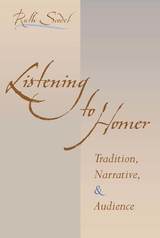 Listening to Homer: Tradition, Narrative, and Audience
Ruth Scodel
University of Michigan Press, 2002 The Homeric poems were not intended for readers, but for a listening audience. Traditional in their basic elements, the stories were learned by oral poets from earlier poets and recreated at every performance. Individual nuances, tailored to the audience, could creep into the stories of the Greek heroes on each and every occasion when a bard recited the epics.
For a particular audience at a particular moment, "tradition" is what it believes it has inherited from the past--and it may not be particularly old. The boundaries between the traditional and the innovative may become blurry and indistinct. By rethinking tradition, we can see Homer's methods and concerns in a new light. The Homeric poet is not naive. He must convince his audience that the story is true. He must therefore seem disinterested, unconcerned with promoting anyone's interests. The poet speaks as if everything he says is merely the repetition of old tales. Yet he carefully ensures that even someone who knows only a minimal amount about the ancient heroes can follow and enjoy the performance, while someone who knows many stories will not remember inappropriate ones. Pretending that every detail is already familiar, the poet heightens suspense and implies that ordinary people are the real judges of great heroes.
Listening to Homer transcends present controversies about Homeric tradition and invention by rethinking how tradition functions. Focusing on reception rather than on composition, Ruth Scodel argues that an audience would only rarely succeed in identifying narrative innovation. Homeric narrative relies on a traditionalizing, inclusive rhetoric that denies the innovation of the oral performance while providing enough information to make the epics intelligible to audiences for whom much of the material is new.
Listening to Homer will be of interest to general classicists, as well as to those specializing in Greek epic and narrative performance. Its wide breadth and scope will also appeal to those non-classicists interested in the nature of oral performance.
Ruth Scodel is Professor of Greek and Latin, University of Michigan, and former president of the American Philological Association. "Ruth Scodel's Listening to Homer proves it is still possible to explore the workings of epic without recourse to a battery of jargon or technicalities. This is not a 'one big idea' book but a rich . . . set of reflections; it makes refreshing reading . . . ."
---Greece & Rome "This is an important book, putting the receiving rather than the sending side of the performance of the Homeric epics center stage. The many observations on narrative technique are often new and worthwhile."
---Irene J.F. de Jong, Gnomon
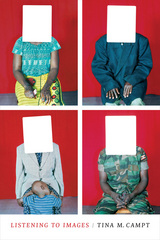 Listening to Images
Tina M. Campt
Duke University Press, 2017 In Listening to Images Tina M. Campt explores a way of listening closely to photography, engaging with lost archives of historically dismissed photographs of black subjects taken throughout the black diaspora. Engaging with photographs through sound, Campt looks beyond what one usually sees and attunes her senses to the other affective frequencies through which these photographs register. She hears in these photos—which range from late nineteenth-century ethnographic photographs of rural African women and photographs taken in an early twentieth-century Cape Town prison to postwar passport photographs in Birmingham, England and 1960s mug shots of the Freedom Riders—a quiet intensity and quotidian practices of refusal. Originally intended to dehumanize, police, and restrict their subjects, these photographs convey the softly buzzing tension of colonialism, the low hum of resistance and subversion, and the anticipation and performance of a future that has yet to happen. Engaging with discourses of fugitivity, black futurity, and black feminist theory, Campt takes these tools of colonialism and repurposes them, hearing and sharing their moments of refusal, rupture, and imagination.
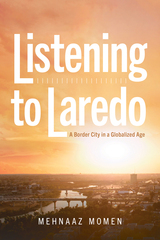 Listening to Laredo: A Border City in a Globalized Age
Mehnaaz Momen
University of Arizona Press, 2023 Nestled between Texas and Tamaulipas, Laredo was once a quaint border town, nurturing cultural ties across the border, attracting occasional tourists, and serving as the home of people living there for generations. In a span of mere decades, Laredo has become the largest inland port in the United States and a major hub of global trade. Listening to Laredo is an exploration of how the dizzying forces of change have defined this locale, how they continue to be inscribed and celebrated, and how their effects on the physical landscape have shaped the identity of the city and its people.
Bringing together issues of growth, globalization, and identity, Mehnaaz Momen traces Laredo’s trajectory through the voices of its people. In contrast to the many studies of border cities defined by the outside—and seldom by the people who live at the border—this volume collects oral histories from seventy-five in-depth interviews that collectively illuminate the evolution of the city’s cultural and economic infrastructure, its interdependence with its sister city across the national boundary, and, above all, the strength of its community as it adapts to and even challenges the national narrative regarding the border. The resonant and lively voices of Laredo’s people convey proud ownership of an archetypal border city that has time and again resurrected itself.
 Listening to Mozart
Charles Wyatt
University of Iowa Press, 1995 With all the drama and complexity of a symphony, Listening to Mozart traces forty years in the life of flutist James Baxter. Many of the stories in this collection—actually a novel in stories—center on or revolve around James' relationship with Anna, a potter and artist. Each story is a separate movement, yet they combine to create a deeply textured whole work. The stories chronicle James' inward journey, as well as his life and loves, with a voice repeatedly transformed through the years. “Bach Suite” serves as a prologue and deals with the split in consciousness that often accompanies musical performance. The story imitates the musical form it describes and tunes the reader's ear to the innermost thoughts of a musician. Each succeeding story introduces another episode in James' life—his music school days in Philadelphia with his first love, Zoe, his stint in the U.S. Marine Band during the Vietnam War when he meets Anna, his adventures with his friend Franklin, his experiences with the mysterious Dalawa, a trip with Anna to Toronto to immerse themselves in the culture and music of South India. James' friendships, affairs, experiences, and occasional angst resound in each story. In all the stories, in all his relationships, James finds himself experiencing his life in much the way he experiences music. There is a moment for which he is waiting, yet for which he is never fully prepared, a moment which passes inexorably. Sometimes, in the rare musical experience, he is able to penetrate that moment and allow time to fall away. These moments are the signposts of his life, like the movements of the Bach suite, but unbidden, and they give him his only perspective and vision.
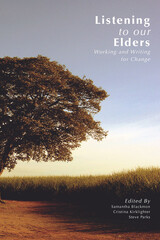 Listening to Our Elders: Working and Writing for Change
Samantha Blackmon, Cristina Kirklighter, and Steve Parks, eds.
Utah State University Press, 2011
In 2011, the National Council of Teachers of English (NCTE) turned one hundred years old. But our profession is endlessly beginning, constantly transforming itself and its purpose as new voices and identities claim their rights in our classrooms and in our country. The recognition of such claims, however, does not occur without a struggle, without collective work.
Listening to our Elders attempts to capture the history of those collective moments where teachers across grade levels and institutions of higher education organized to insure that the voices, heritages, and traditions of their students and colleagues were recognized within our professional organizations as a vital part of our classrooms and our discipline. In doing so, Listening to Our Elders demonstrates this recognition was not always easily given. Instead, whether the issue was race, sexuality, class, or disability, committed activist organizations have often had to push against the existing limits of our field and its organizations to insure a broader sense of common responsibility and humanity was recognized.
Listening to Our Elders features interviews with Malea Powell (Native American Caucus), Joyce Rain Anderson (Native American Caucus), Jeffery Paul Chan (Asian/Asian American), James Hill (Black Caucus), James Dolmage (Committee for Disability Issue in College Composition), Geneva Smitherman (Language Policy Commitee), Carlota Cárdenas de Dwyer (Latino/a Caucus), Victor Villanueva (Latino/a Caucus), Louise Dunlap (Progressive Caucus), Karen Hollis (Progressive Caucus), Louie Crew (Queer Caucus), William Thelin (Working Class Culture and Pedagogy SIG), Bill Macauley (Working Class Culture and Pedagogy SIG).
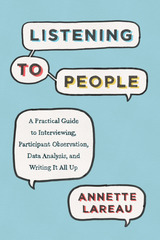 Listening to People: A Practical Guide to Interviewing, Participant Observation, Data Analysis, and Writing It All Up
Annette Lareau
University of Chicago Press, 2021 A down-to-earth, practical guide for interview and participant observation and analysis.
In-depth interviews and close observation are essential to the work of social scientists, but inserting one’s researcher-self into the lives of others can be daunting, especially early on. Esteemed sociologist Annette Lareau is here to help. Lareau’s clear, insightful, and personal guide is not your average methods text. It promises to reduce researcher anxiety while illuminating the best methods for first-rate research practice.
As the title of this book suggests, Lareau considers listening to be the core element of interviewing and observation. A researcher must listen to people as she collects data, listen to feedback as she describes what she is learning, listen to the findings of others as they delve into the existing literature on topics, and listen to herself in order to sift and prioritize some aspects of the study over others. By listening in these different ways, researchers will discover connections, reconsider assumptions, catch mistakes, develop and assess new ideas, weigh priorities, ponder new directions, and undertake numerous adjustments—all of which will make their contributions clearer and more valuable.
Accessibly written and full of practical, easy-to-follow guidance, this book will help both novice and experienced researchers to do their very best work. Qualitative research is an inherently uncertain project, but with Lareau’s help, you can alleviate anxiety and focus on success.
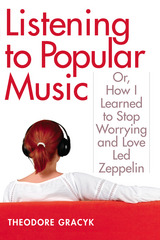 Listening to Popular Music: Or, How I Learned to Stop Worrying and Love Led Zeppelin
Theodore Gracyk
University of Michigan Press, 2007 It has long been assumed that people who prefer Led Zeppelin to Mozart live aesthetically impoverished lives. But why? In Listening to Popular Music, award-winning popular music scholar Theodore Gracyk argues that aesthetic value is just as important in popular listening as it is with “serious” music. And we don’t have to treat popular music as art in order to recognize its worth. Aesthetic values are realized differently in different musical styles, and each requires listening skills that people must learn. Boldly merging insights from popular music studies, aesthetic theory, cognitive science, psychology, identity theory, and cultural studies, Gracyk crafts an innovative study that argues that understanding aesthetic value is crucial to the enjoyment of all forms of music. Listening to Popular Music thusoffers a new, general framework for understanding what it means to appreciate music, showing that an informed preference for popular music is a response to real values of the music, including aesthetic values. "Finally, a book on aesthetics that's philosophically grounded, anti-elitist, and tailored to popular music. Much needed and deftly achieved."
—William Echard, Department of Music, and Institute for Comparative Studies in Literature, Art, and Culture, Carleton University "A sophisticated account of aesthetic value in popular music that revealingly challenges orthodoxies of cultural studies and traditional aesthetics."
—Stephen Davies, Department of Philosophy, University of Auckland, and author of The Philosophy of Art "Gracyk's arguments are thoughtful, clear, and persuasive, and it's refreshing to see him expose the flaws in commonly repeated critiques of popular music. This book will challenge open-minded doubters to take popular music seriously."
—Mark Katz, Assistant Professor of Music, University of North Carolina at Chapel Hill, and author of Capturing Sound: How Technology Has Changed Music Theodore Gracyk is Department Chair and Professor of Philosophy at Minnesota State University Moorhead. He is the author of Rhythm and Noise: An Aesthetics of Rock and I Wanna Be Me: Rock Music and the Politics of Identity, which won the 2002 IASPM-US Woody Guthrie Book Award.
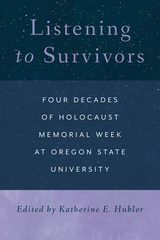 Listening to Survivors: Four Decades of Holocaust Memorial Week at Oregon State University
Katherine E. Hubler
Oregon State University Press, 2024 Listening to Survivors presents the voices of nineteen Holocaust survivors and two witnesses who shared their personal experiences with audiences at Oregon State University over the past four decades as part of the university’s Holocaust Memorial Week observance. The speakers recount revolts in Nazi-run killing centers, intimate friendships with Anne Frank and her family, medical experiments endured at the hands of infamous Nazi doctor Josef Mengele, and countless acts of defiance. Many of the individuals featured in this volume—including Eva Aigner, Les Aigner, Miriam Kominkowska Greenstein, Chella Velt Meekcoms Kryszek, and Alter Wiener—called Oregon home and served at the forefront of Holocaust commemoration in Oregon and public outreach to the state’s young people. By emphasizing the linkages between Oregon and the global tragedy of the Holocaust, this volume reaffirms the local and global relevance of efforts to prevent and redress persecution and mass violence against vulnerable populations.
Historian Katherine Hubler has arranged these recollections thematically in chapters centered on discrimination, refuge, resistance, rescue, and transitional justice. These themes align with Oregon’s Holocaust and Genocide Education learning concepts, discussion questions accompany each chapter to facilitate use in classrooms, and the introduction situates the speakers’ diverse experiences within the broader context of World War Two and the Nazis’ genocidal project.
Intended to bring the history of the Holocaust to all Oregonians, Listening to Survivors honors the legacy of outreach work of local survivors and serves as a reminder of the state’s connection to the Holocaust and commitment to genocide education and prevention.
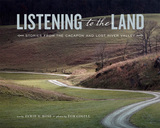 Listening to the Land: Stories from the Cacapon and Lost River Valley
Jamie S. Ross
West Virginia University Press, 2013 The Cacapon and Lost Rivers are located in the Appalachian Mountains of West Virginia’s eastern panhandle. Well loved by paddlers and anglers, these American Heritage Rivers are surrounded by a lush valley of wildlife and flora that is part of the Chesapeake Bay watershed.
Although still rural and mostly forested, development and land fragmentation in the Cacapon and Lost River Valley have increased over the last decades. Listening to the Land: Stories from the Cacapon and Lost River Valley is a conversation between the people of this Valley and their land, chronicling this community’s dedication to preserving its farms, forests, and rural heritage. United around a shared passion for stewardship, the Cacapon and Lost Rivers Land Trust and local landowners have permanently protected over 11,000 acres by incorporating local values into permanent conservation action. Despite the economic pressures that have devastated nearby valleys over the past twenty years, natives and newcomers alike have worked to protect this valley by sustaining family homesteads and buying surrounding parcels.This partnership between the Land Trust and the people of this Valley, unprecedented in West Virginia and nationally recognized for its success, greatly enriches historic preservation and conservation movements, bringing to light the need to investigate, pursue, and listen to the enduring connection between people and place.
 Listening to the Languages of the People: Lazare Sainéan on Romanian, Yiddish, and French
Natalie Zemon Davis
Central European University Press, 2022 This tale of great achievements and great disappointments offers a fresh perspective on the interplay between scholarship and political sentiment in the late nineteenth and early twentieth centuries. Lazăr Șăineanu (1859-1934), linguist and folklorist, was a pioneer in his native Romania, seeking out the popular elements in culture along with high literary ones. He was among the first to publish a study of Yiddish as a genuine language, and he uncovered Turkish features in Romanian language and customs. He also made an index of hundreds of Romanian folktales. Yet when he sought Romanian citizenship and a professorship, he was blocked by powerful figures who thought Jews could not be Romanians and who fancied the origins of Romanian culture to be wholly Latin. Faced with anti-Semitism, some of his friends turned to Zionism. Instead he tried baptism, which brought him only mockery and shame. Hoping to find a polity to which he could belong, Șăineanu moved with his family to Paris in 1900 and became Lazare Sainéan. There he made innovative studies of French popular speech and slang, culminating in his great work on the language of Rabelais. Once again, he was contributing to the development of a national tongue. Even then, while welcomed by literary scholars, Sainéan was unable to get a permanent university post. Though a naturalized citizen of France, he felt himself a foreigner, an “intruder,” into his old age.
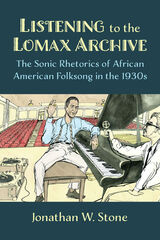 Listening to the Lomax Archive: The Sonic Rhetorics of African American Folksong in the 1930s
Jonathan W. Stone
University of Michigan Press, 2021 In 1933, John A. Lomax and his son Alan set out as emissaries for the Library of Congress to record the folksong of the “American Negro” in several southern African-American prisons. Listening to the Lomax Archive: The Sonic Rhetorics of African American Folksong in the 1930s asks how the Lomaxes’ field recordings—including their prison recordings and a long-form oral history of jazz musician Jelly Roll Morton—contributed to a new mythology of Americana for a nation in the midst of financial, social, and identity crises. Jonathan W. Stone argues that folksongs communicate complex historical experiences in a seemingly simple package, and can thus be a key element—a sonic rhetoric—for interpreting the ebb and flow of cultural ideals within contemporary historical moments. He contends that the Lomaxes, aware of the power folk music, used the folksongs they collected to increase national understanding of and agency for the subjects of their recordings (including the reconstitution of prevailing stereotypes about African American identity) even as they used the recordings to advance their own careers. Listening to the Lomax Archive gives readers the opportunity to listen in on these seemingly contradictory dualities, demonstrating that they are crucial to the ways that we remember and write about the subjects of the Lomaxes archive and other repositories of historicized sound.
Listening To The Sea: The Politics of Improving Environmental Protection
Robert Jay Wilder
University of Pittsburgh Press, 1998 Through a rigorous integration of policy and science, Robert Wilder suggests a much-improved second-generation governance of the oceans and coasts and proposes new ideas for resolving the environmental policy stalemate found within the U.S. government.
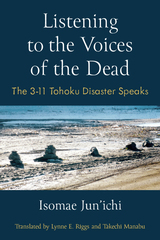 Listening to the Voices of the Dead: The 3-11 Tohoku Disaster Speaks
Isomae Jun'ichi
University of Michigan Press, 2024 Listening to the Voices of the Dead is an account of the author’s search for the disquieted voices of the dead in the wake of the March 11, 2011, Tōhoku Disaster and his attempt to translate those voices for the living. Isomae Jun’ichi considers the disaster a challenge for outside observers to overcome, especially for practitioners of religion and religious studies. He chronicles the care and devotion for the dead shown by ordinary people, people displaced from their homes and loved ones. Drawing upon religious studies, Japanese history, postcolonial studies, and his own experiences during the disaster, Isomae uncovers historical symptoms brought to the surface by the traumas of disaster. Only by listening to the disquieted voices of the dead, translating them, and responding to them can we regain our true selves as well as offer peace to the spirits of the victims. While Listening to the Voices of the Dead focuses on a specific event in Japanese history and memory, it captures a broadening critique at the heart of many movements responding to how increasing globalization impacts our sense of place and community.
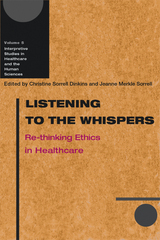 Listening to the Whispers: Re-thinking Ethics in Healthcare
Edited by Christine Sorrell Dinkins and Jeanne Merkle Sorrell
University of Wisconsin Press, 2006 Listening to the Whispers gives voice to scholars in philosophy, medical anthropology, physical therapy, and nursing, helping readers re-think ethics across the disciplines in the context of today's healthcare system. Diverse voices, often unheard, challenge readers to enlarge the circle of their ethical concerns and look for hidden pathways toward new understandings of ethics. Essays range from a focus on the context of corporatization and managed care environments to a call for questioning the fundamental values of society as these values silently affect many others in healthcare. Each chapter is followed by a brief essay that highlights issues useful for scholarly research and classroom discussion. The conversations of interpretive research in healthcare contained in this volume encourage readers to re-think ethics in ways that will help to create an ethical healthcare system with a future of new possibilities. Outstanding Academic Title, Choice Magazine
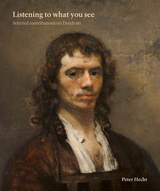 Listening to What You See: Selected Contributions on Dutch Art
Peter Hecht
Paul Holberton Publishing, 2024 Art historian Peter Hecht shares his philosophy and methods of interpreting art.
Listening to What You See brings together more than twenty-five scholarly essays, reviews, and shorter contributions by Peter Hecht, preceded by an introduction on what he thinks his life in art history has taught him. The title indicates what his collected papers have in common: together they represent an attitude of listening to what you see. Hecht is very suspicious of applying a method and believes that looking at an image until it speaks is essential to understanding it. Apart from a few scholarly reviews, Listening to What You See also contains a sample of Hecht’s writings for the public at large, and some of his best-known critical papers are included here. It covers a range of different topics, including defending public art collections, showing what art can mean in times of crisis when it is not accessible (as was the case when Covid forced the museums to shut down), and talking about what art may do for us–provided that we listen.
 Listening to Workers: Oral Histories of Metro Detroit Autoworkers in the 1950s
Daniel J. Clark
University of Illinois Press, 2024 Historians and readers alike often overlook the everyday experiences of workers. Drawing on years of interviews and archival research, Daniel J. Clark presents the rich, interesting, and sometimes confounding lives of men and women who worked in Detroit-area automotive plants in the 1950s. In their own words, the interviewees frankly discuss personal matters like divorce and poverty alongside recollections of childhood and first jobs, marriage and working women, church and hobbies, and support systems and workplace dangers. Their frequent struggles with unstable jobs and economic insecurity upend notions of the 1950s as a golden age of prosperity while stories of domestic violence and infidelity open a door to intimate aspects of their lives. Taken together, the narratives offer seldom-seen accounts of autoworkers as complex and multidimensional human beings. Compelling and surprising, Listening to Workers foregoes the union-focused strain of labor history to provide ground-level snapshots of a blue-collar world.
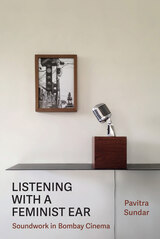 Listening with a Feminist Ear: Soundwork in Bombay Cinema
Pavitra Sundar
University of Michigan Press, 2023 Listening with a Feminist Ear is a study of the cultural politics and possibilities of sound in cinema. Eschewing ocularcentric and siloed disciplinary formations, the book takes seriously the radical theoretical and methodological potential of listening. It models a feminist interpretive practice that is not just attuned to how power and privilege are materialized in sound, but that engenders new, counter-hegemonic imaginaries.
Focusing on mainstream Bombay cinema, Sundar identifies singing, listening, and speaking as key sites in which gendered notions of identity and difference take form. Charting new paths through seven decades of film, media, and cultural history, Sundar identifies key shifts in women’s playback voices and the Islamicate genre of the qawwali. She also conceptualizes spoken language as sound, and turns up the volume on a capacious, multilingual politics of belonging that scholarly and popular accounts of nation typically render silent. All in all, Listening with a Feminist Ear offers a critical sonic sensibility that reinvigorates debates about the gendering of voice and body in cinema, and the role of sound and media in conjuring community.
Lister Hill: Statesman from the South
Virginia Van der Veer Hamilton
University of Alabama Press, 2004 "Hamilton makes clear in this intelligent and sensitive biography [that] Hill, whose 45 years in Congress spanned the presidents from Calvin Coolidge to Lyndon Johnson, deserves to be remembered, both for the impressive legislative record he compiled and for the light he shed on southern liberalism in the 20th century."
-- Journal of Southern History
"Hamilton's fine book is based on extensive research [and] it will be of interest to a general audience as well as to scholars."
-- Journal of American History
"This is an important work about a highly influential lawmaker."
Choice
Virginia Van der Veer Hamilton is Professor Emerita of History at The University of Alabama at Birmingham and author of Hugo Black: The Alabama Years.
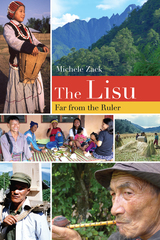 The Lisu: Far from the Ruler
Michele Zack
University Press of Colorado, 2017 This book brings the ironic worldview of the Lisu to life through vivid, often amusing accounts of individuals, communities, regions, and practices. One of the smallest and last groups of stateless people, and the most egalitarian of all Southeast Asian highland minorities, the Lisu have not only survived extremes at the crossroads of civil wars, the drug trade, and state-sponsored oppression but adapted to modern politics and technology without losing their identity. The Lisu weaves a lively narrative that condenses humanity’s transition from border-free tribal groupings into today’s nation-states and global market economy. Journalist and historian Michele Zack first encountered the Lisu in the 1980s and conducted research and fieldwork among them in the 1990s. In 2014 she again traveled extensively in tribal areas of Thailand, Myanmar, and China, when she documented the transformative changes of globalization. Some Lisu have adopted successful new urban occupations in business and politics, while most continue to live as agriculturists “far from the ruler.” The cohesiveness of Lisu culture has always been mysterious—they reject hierarchical political organization and traditionally had no writing system—yet their culture provides a particular skillset that has helped them navigate the terrain of the different religious and political systems they have recently joined. They’ve made the transition from living in lawless, self-governing highland peripheries to becoming residents and citizens of nation-states in a single generation. Ambitious and written with journalist’s eye for detail and storytelling, The Lisu introduces the unique and fascinating culture of this small Southeast Asian minority. Their path to national and global citizenship illustrates the trade-offs all modern people have made, and their egalitarian culture provides insight into current political choices in a world turning toward authoritarianism.
Lit from Within: Contemporary Masters on the Art and Craft of Writing
Kevin Haworth; Dinty W. Moore
Ohio University Press, 2011 Lit from Within offers creative writers a window into the minds of some of America’s most celebrated contemporary authors. Witty, direct, and thought–provoking, these essays offer something to creative writers of all backgrounds and experience. With contributions from fiction writers, poets, and nonfiction writers, this is a collection of unusual breadth and quality. Contributors: Lee K. Abbott, Rick Bass, Claire Bateman, Charles Baxter, Ron Carlson, Billy Collins, Peter Ho Davies, Carl Dennis, Stephen Dunn, Robin Hemley, Tony Hoagland, David Kirby, Maggie Nelson, Francine Prose, Mary Ruefle
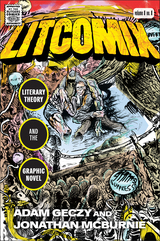 Litcomix: Literary Theory and the Graphic Novel
Adam Geczy
Rutgers University Press, 2023 Critical studies of the graphic novel have often employed methodologies taken from film theory and art criticism. Yet, as graphic novels from Maus to Watchmen have entered the literary canon, perhaps the time has come to develop theories for interpreting and evaluating graphic novels that are drawn from classic models of literary theory and criticism.
Using the methodology of Georg Lukács and his detailed defense of literary realism as a socially embedded practice, Litcomix tackles difficult questions about reading graphic novels as literature. What critical standards should we use to measure the quality of a graphic novel? How does the genre contribute to our understanding of ourselves and the world? What qualities distinguish it from other forms of literature?
LitComix hones its theoretical approach through case studies taken from across the diverse world of comics, from Yoshihiro Tatsumi’s groundbreaking manga to the Hernandez Brothers’ influential alt-comix. Whether looking at graphic novel adaptations of Proust or considering how Jack Kirby’s use of intertextuality makes him the Balzac of comics, this study offers fresh perspectives on how we might appreciate graphic novels as literature.
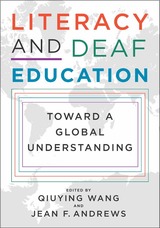 Literacy and Deaf Education: Toward a Global Understanding
Qiuying Wang
Gallaudet University Press, 2020 International perspectives about literacy and deaf students is an uncharted intellectual landscape. Much of the literacy research in deaf education is conducted in English-speaking countries—primarily the United States—but 90% of deaf children live outside the U.S. and learn various signed and spoken languages, as well as diverse writing systems. Many of these children face significant educational challenges. In order to improve the literacy outcomes of deaf students around the world, it is imperative to study how children are using their local signed and spoken languages along with Deaf culture to learn to read and write. This volume fills a void in the field by providing a global view of recent theoretical and applied research on literacy education for deaf learners.
Literacy and Deaf Education: Toward a Global Understanding is organized by region and country, with the first part discussing writing systems that use alphabetic scripts, and the second part focusing on countries that use non-alphabetic scripts. Some examples of the wide spectrum of topics covered include communication methodologies, curriculum, bilingual education, reading interventions, script diversity, and sociocultural development, including Deaf cultural developments. The contributors provide the results from literacy projects in fifteen countries and regions.
This volume aims to widen the knowledge base, familiarize others in the field with these initiatives, and improve global understandings and outcomes of literacy teaching and learning in deaf education from birth to high school.
Signed chapter summaries are available on the Gallaudet University Press YouTube channel.
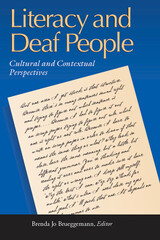 Literacy and Deaf People: Cultural and Contextual Perspectives
Brenda Jo Brueggemann
Gallaudet University Press, 2004 This compelling collection advocates for an alternative view of deaf people’s literacy, one that emphasizes recent shifts in Deaf cultural identity rather than a student’s past educational context as determined by the dominant hearing society. Divided into two parts, the book opens with four chapters by leading scholars Tom Humphries, Claire Ramsey, Susan Burch, and volume editor Brenda Jo Brueggemann. These scholars use diverse disciplines to reveal how schools where deaf children are taught are the product of ideologies about teaching, about how deaf children learn, and about the relationship of ASL and English.
Part Two features works by Elizabeth Engen and Trygg Engen; Tane Akamatsu and Ester Cole; Lillian Buffalo Tompkins; Sherman Wilcox and BoMee Corwin; and Kathleen M. Wood. The five chapters contributed by these noteworthy researchers offer various views on multicultural and bilingual literacy instruction for deaf students. Subjects range from a study of literacy in Norway, where Norwegian Sign Language recently became the first language of instruction for deaf pupils, to the difficulties faced by deaf immigrant and refugee children who confront institutional and cultural clashes. Other topics include the experiences of deaf adults who became bilingual in ASL and English, and the interaction of the pathological versus the cultural view of deafness. The final study examines literacy among Deaf college undergraduates as a way of determining how the current social institution of literacy translates for Deaf adults and how literacy can be extended to deaf people beyond the age of 20.
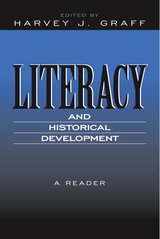 Literacy and Historical Development: A Reader
Edited by Harvey J. Graff
Southern Illinois University Press, 2007 Representing three decades of research, Literacy and Historical Development: A Reader presents some of the most important historical scholarship on literacy in Europe and the United States. The approaches, research, and conclusions reflected in this collection of fifteen essays has changed how historians and many others conceptualize literacy and represents a body of scholarship that is transforming both contemporary and historical literacy theories. In this revised and expanded edition of the groundbreaking volume Literacy and Social Development in the West, editor Harvey J. Graff provides a new introduction and nine new essays by nationally and internationally renowned contributors from a range of disciplines. Replacing an unquestioned certainty that literacy’s powers are universal, independent, and determinative, Graff brings together studies that support new concepts, contending that the importance and influences of literacy depend on specific social and historical contexts, the impacts of literacy are mediated and restricted, the effects of literacy are social and particular, and the role of literacy must be understood within the burgeoning array of communication technologies.
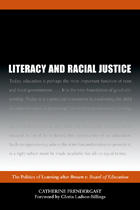 Literacy and Racial Justice: The Politics of Learning after Brown v. Board of Education
Catherine Prendergast. Foreword by Gloria Ladson-Billings
Southern Illinois University Press, 2003 In anticipation of the fiftieth anniversary of the landmark Brown v. Board of Education decision, Catherine Prendergast draws on a combination of insights from legal studies and literacy studies to interrogate contemporary multicultural literacy initiatives, thus providing a sound historical basis that informs current debates over affirmative action, school vouchers, reparations, and high-stakes standardized testing. As a result of Brown and subsequent crucial civil rights court cases, literacy and racial justice are firmly enmeshed in the American imagination—so much so that it is difficult to discuss one without referencing the other. Breaking with the accepted wisdom that the Brown decision was an unambiguous victory for the betterment of race relations, Literacy and Racial Justice: The Politics of Learning after Brown v. Board of Education finds that the ruling reinforced traditional conceptions of literacy as primarily white property to be controlled and disseminated by an empowered majority. Prendergast examines civil rights era Supreme Court rulings and immigration cases spanning a century of racial injustice to challenge the myth of assimilation through literacy. Advancing from Ways with Words, Shirley Brice Heath’s landmark study of desegregated communities, Prendergast argues that it is a shared understanding of literacy as white property which continues to impact problematic classroom dynamics and education practices. To offer a positive model for reimagining literacy instruction that is truly in the service of racial justice, Prendergast presents a naturalistic study of an alternative public secondary school. Outlining new directions and priorities for inclusive literacy scholarship in America, Literacy and Racial Justice concludes that a literate citizen is one who can engage rather than overlook longstanding legacies of racial strife.
 Literacy and Written Culture in Early Modern Central Europe
István György Tóth
Central European University Press, 2001 This unequalled volume’s key value is to place Hungary on the map of European literacy rates over the whole period between the initial stimuli of Renaissance and Reformation and the developed, state-organized educational systems of the (later) nineteenth century.
Suitable for academics across a wide range of subject areas, Tóth’s work is a broad international comparative analysis, concentrating on the long-term development of literacy rates and the use of written and oral culture in early modern societies. Tóth also examines the social history of elementary schools and its teachers, and book reading among peasants and noblemen throughout the sixteenth to nineteenth centuries in Hungary. Literacy and Written Culture includes references to the development of libraries during the period and on the use of different languages – of particular importance is an examination of Latin usage. This volume is an extremely lively and stimulating guide providing fascinating insights into village life, legal and administrative issues and the role of the clergy. Its overall content contributes to major debates in the fields of language, literacy, linguistics and social history.
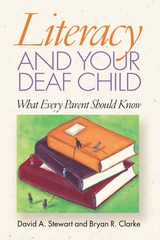 Literacy and Your Deaf Child: What Every Parent Should Know
David A. Stewart
Gallaudet University Press, 2003 In the modern world, success depends upon literacy, a fact especially true for deaf children who, if they read and write well, can take full advantage of e-mail, the Internet, and other communication innovations. Literacy and Your Deaf Child: What Every Parent Should Know provides parents with the means to ensure that their deaf or hard of hearing child becomes a proficient reader and writer. In nine chapters, parents will learn about the relationship of language to reading and writing, including the associated terminology, the challenges that deaf children face, and the role of schools. They’ll also learn activities that they can engage in at home that will strengthen their children’s reading and writing capabilities.
Literacy and Your Deaf Child begins by introducing some common concepts, among them the importance of parental involvement in a deaf child’s education. It outlines how children acquire language and describes the auditory and visual links to literacy. With this information, parents can make informed decisions regarding hearing aids, cochlear implants, speechreading, and sign communication, all of which can have a marked influence on their child’s language development. Parents will discover how to create environments at home and in their community for fostering their child’s literacy, especially in school by learning how to work closely with their child’s teachers. The book also refers throughout to the developmental link between American Sign Language and English literacy for children who use sign communication, making it the best guide available for all deaf children and their parents.
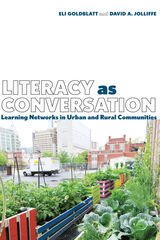 Literacy as Conversation: Learning Networks in Urban and Rural Communities
Eli Goldblatt and David Jolliffe
University of Pittsburgh Press, 2020 In Literacy as Conversation, the authors tell stories of successful literacy learning outside of schools and inside communities, both within urban neighborhoods of Philadelphia and rural and semi-rural towns of Arkansas. They define literacy not as a basic skill but as a rich, broadly interactive human behavior: the ability to engage in a conversation carried on, framed by, or enriched through written symbols. Eli Goldblatt takes us to after-school literacy programs, community arts centers, and urban farms in the city of Philadelphia, while David Jolliffe explores learning in a Latinx youth theater troupe, a performance based on the words of men on death row, and long-term cooperation with a rural health care provider in Arkansas. As different as urban and rural settings can be—and as beset as they both are with the challenges of historical racism and economic discrimination—the authors see much to encourage both geographical communities to fight for positive change.
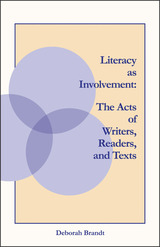 Literacy as Involvement: The Acts of Writers, Readers, and Texts
Deborah Brandt
Southern Illinois University Press, 1990 In Literacy as Involvement, Deborah Brandt examines the cultural and social roots of the acts of reading and writing. The book asks, for example, whether literacy is a natural growth of or a radical shift from orality. It questions the contrary views that literacy is either the learning of the conventions of language or is better understood as heightened social ability. Finally, it raises the possibility that knowing how to read and write is actually understanding how we respond during the acts of reading and writing. This examination of literacy as process is also offered as a critique of prevailing theories of literacy advanced by such scholars as Walter J. Ong, S.J., David Olson, and E. D. Hirsch. They depict literacy as a textual experience that is socially and linguistically detached. Brandt critically examines the underlying assumptions from research on writing processes and argues that they call for a major reformation of prevailing conceptions of literacy. Specifically, she analyzes several expository texts from a process perspective to establish the interaction of reader and writer in even the most seemingly formal and detached writing. In her conclusion, Brandt brings together the major findings of her study to address pressing literacy issues, including the problem of illiteracy in our schools.
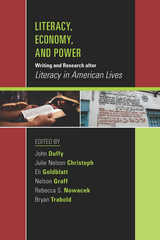 Literacy, Economy, and Power: Writing and Research after "Literacy in American Lives"
Edited by John Duffy, Julie Nelson Christoph, Eli Goldblatt, Nelson Graff, Rebecca S. Nowacek, Bryan Trabold
Southern Illinois University Press, 2014 Following on the groundbreaking contributions of Deborah Brandt’s Literacy in American Lives—a literacy ethnography exploring how ordinary Americans have been affected by changes in literacy, public education, and structures of power—Literacy, Economy, and Power expands Brandt’s vision, exploring the relevance of her theoretical framework as it relates to literacy practices in a variety of current and historical contexts, as well as in literacy’s expanding and global future. Bringing together scholars from rhetoric, composition, and literacy studies, the book offers thirteen engrossing essays that extend and challenge Brandt’s commentary on the dynamics between literacy and power. The essays cover many topics, including the editor of the first Native American newspaper, the role of a native Hawaiian in bringing literacy to his home islands, the influence of convents and academies on nineteenth-century literacy, and the future of globalized digital literacies. Contributors include Julie Nelson Christoph, Ellen Cushman, Kim Donehower, Anne Ruggles Gere, Eli Goldblatt, Harvey J. Graff, Gail E. Hawisher, Bruce Horner, David A. Jolliffe, Rhea Estelle Lathan, Min-Zhan Lu, Robyn Lyons-Robinson, Carol Mattingly, Beverly J. Moss, Paul Prior, Cynthia L. Selfe, Michael W. Smith, and Morris Young. Literacy, Economy, and Power also features an introduction exploring the scholarly impact of Brandt’s work, written by editors John Duffy, Julie Nelson Christoph, Eli Goldblatt, Nelson Graff, Rebecca Nowacek, and Bryan Trabold. An invaluable tool for literacy studies at the graduate or professional level, Literacy, Economy, and Power provides readers with a wide-ranging view of the work being done in literacy studies today and points to ways researchers might approach the study of literacy in the future.
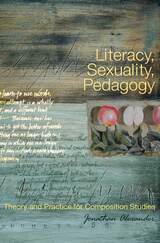 Literacy, Sexuality, Pedagogy: Theory and Practice for Composition Studies
Jonathan Alexander
Utah State University Press, 2008 Despite its centrality to much of contemporary personal and public discourse, sexuality remains infrequently discussed in most composition courses, and in our discipline at large. Moreover, its complicated relationship to discourse, to the very languages we use to describe and define our worlds, is woefully understudied in our discipline. Discourse about sexuality, and the discourse of sexuality, surround us—circulating in the news media, on the Web, in conversations, and in the very languages we use to articulate our interactions with others and our understanding of ourselves. It forms a core set of complex discourses through which we approach, make sense of, and construct a variety of meanings, politics, and identities.
In Literacy, Sexuality, Pedagogy, Jonathan Alexander argues for the development of students' "sexual literacy." Such a literacy is not just concerned with developing fluency with sexuality as a "hot" topic, but with understanding the intimate interconnectedness of sexuality and literacy in Western culture. Using the work of scholars in queer theory, sexuality studies, and the New Literacy Studies, Alexander unpacks what he sees as a crucial--if often overlooked--dimension of literacy: the fundamental ways in which sexuality has become a key component of contemporary literate practice, of the stories we tell about ourselves, our communities, and our political investments.
Alexander then demonstrates through a series of composition exercises and writing assignments how we might develop students' understanding of sexual literacy. Examining discourses of gender, heterosexuality, and marriage allows students (and instructors) a critical opportunity to see how the languages we use to describe ourselves and our communities are saturated with ideologies of sexuality. Understanding how sexuality is constructed and deployed as a way to "make meaning" in our culture gives us a critical tool both to understand some of the fundamental ways in which we know ourselves and to challenge some of the norms that govern our lives. In the process, we become more fluent with the stories that we tell about ourselves and discover how normative notions of sexuality enable (and constrain) narrations of identity, culture, and politics. Such develops not only our understanding of sexuality, but of literacy, as we explore how sexuality is a vital, if vexing, part of the story of who we are.
 Literal Figures: Puritan Allegory and the Reformation Crisis in Representation
Thomas H. Luxon
University of Chicago Press, 1995 Literal Figures is the most important work on John Bunyan to appear in many years, and a significant contribution to the history and theory of representation. Beginning with mainstream Puritan responses to a challenge to orthodoxy—a man who claims he has been literally transformed into Christ and his companion who claims to be the "Spouse of Christ"—and concluding with an analysis of The Pilgrim's Progress, which John Bunyan described as a "fall into Allegory," Thomas Luxon presents detailed analyses of key moments in the Reformation crisis of representation.
Why did Puritan Christianity repeatedly turn to allegorical forms of representation in spite of its own intolerance of "Allegorical fancies?" Luxon demonstrates that Protestant doctrine itself was a kind of allegory in hiding, one that enabled Puritans to forge a figural view of reality while championing the "literal" and the "historical". He argues that for Puritanism to survive its own literalistic, anti-symbolic, and millenarian challenges, a "fall" back into allegory was inevitable. Representative of this "fall," The Pilgrim's Progress marks the culminating moment at which the Reformation's war against allegory turns upon itself. An essential work for understanding both the history and theory of representation and the work of John Bunyan, Literal Figures skillfully blends historical and critical methods to describe the most important features of early modern Protestant and Puritan culture.
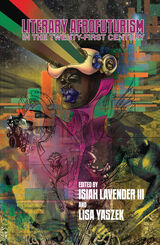 Literary Afrofuturism in the Twenty-First Century
Edited by Isiah Lavender III and Lisa Yaszek
Ohio State University Press, 2020 Finalist, 2021 Locus Award
In Literary Afrofuturism in the Twenty-First Century, eminent contributors pay tribute to Afrofuturism as a powerful and evolving aesthetic practice that communicates the experience of science, technology, and race across centuries, continents, and cultures. While Ryan Coogler and Janelle Monáe may have helped bring the genre into contemporary pop consciousness, it in fact extends back to the writing of eighteenth-century poet Phyllis Wheatley and has continued in the work of Samuel R. Delany, Octavia E. Butler, N. K. Jemisin, and many others. In examining this heritage, contributors in this volume question generic boundaries, recover lost artists and introduce new ones, and explore how the meteoric rise of a new, pan-African speculative literary tradition may or may not connect with Afrofuturism.
Additionally, the editors have marshaled some of today’s most exciting writers for a roundtable discussion of the genre: Bill Campbell, Minister Faust, Nalo Hopkinson, N. K. Jemisin, Chinelo Onwualu, Nisi Shawl, and Nick Wood. Pioneering author and editor Sheree R. Thomas limns how black women have led new developments in contemporary Afrofuturism, and artist Stacey Robinson’s illustrations orient readers to the spirited themes of this enduring and consequential literary tradition.
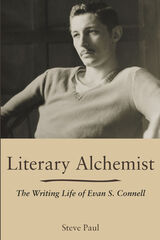 Literary Alchemist: The Writing Life of Evan S. Connell
Steve Paul
University of Missouri Press, 2021 Winner, 2022 Society of Midland Authors award for Biography/Memoir Evan S. Connell (1924–2013) emerged from the American Midwest determined to become a writer. He eventually made his mark with attention-getting fiction and deep explorations into history. His linked novels Mrs. Bridge (1959) and Mr. Bridge (1969) paint a devastating portrait of the lives of a prosperous suburban family not unlike his own that, more than a half century later, continue to haunt readers with their minimalist elegance and muted satire. As an essayist and historian, Connell produced a wide range of work, including a sumptuous body of travel writing, a bestselling epic account of Custer at the Little Bighorn, and a singular series of meditations on history and the human tragedy.
This first portrait and appraisal of an under-recognized American writer is based on personal accounts by friends, relatives, writers, and others who knew him; extensive correspondence in library archives; and insightful literary and cultural analysis of Connell’s work and its context. It also illuminates aspects of American publishing, Hollywood, male anxieties, and the power of place.
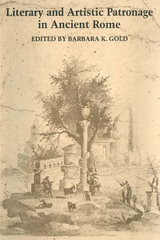 Literary and Artistic Patronage in Ancient Rome
Edited by Barbara K. Gold
University of Texas Press, 1982 Virgil, Horace, Catullus, Propertius—these are just a few of the poets whose work we would be without today were it not for the wealthy and powerful patrons upon whose support the Roman cultural establishment so greatly depended. Who were these patrons? What benefits did they give, to whom, and why? What effect did the support of such men as Maecenas and Pompey have on the lives and work of those who looked to them for aid? These questions and others are addressed in this volume, which explores all the important aspects of patronage—a topic crucial to the study of literature and art from Homer to the present day. The subject is approached from various vantage points: literary, artistic, historical. The essayists reach conclusions that dispel the many misconceptions about Roman patronage derived from seventeenth- and eighteenth-century models in England and Europe. An understanding of the workings of patronage is indispensable in helping us see how the Roman cultural establishment functioned in the four centuries of its flourishing and also in helping us read and enjoy specific poems and works of art. A book for all concerned with classical literature, art, and social history, Literary and Artistic Patronage in Ancient Rome not only deepens our understanding of the ancient world but also suggests important avenues for future exploration.
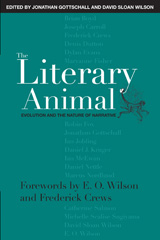 The Literary Animal: Evolution and the Nature of Narrative
Jonathan Gottschall and David Sloan Wilson
Northwestern University Press, 2005 In recent years, articles in major periodicals from the New York Times Magazine to the Times Literary Supplement have heralded the arrival of a new school of literary studies that promises-or threatens-to profoundly shift the current paradigm. This revolutionary approach, known as Darwinian literary studies, is based on a few simple premises: evolution has produced a universal landscape of the human mind that can be scientifically mapped; these universal tendencies are reflected in the composition, reception, and interpretation of literary works; and an understanding of the evolutionary foundations of human behavior, psychology, and culture will enable literary scholars to gain powerful new perspectives on the elements, form, and nature of storytelling.
The goal of this book is to overcome some of the widespread misunderstandings about the meaning of a Darwinian approach to the human mind generally, and literature specifically. The volume brings together scholars from the forefront of the new field of evolutionary literary analysis-both literary analysts who have made evolution their explanatory framework and evolutionist scientists who have taken a serious interest in literature-to show how the human propensity for literature and art can be properly framed as a true evolutionary problem. Their work is an important step toward the long-prophesied synthesis of the humanities and what Steven Pinker calls "the new sciences of human nature."
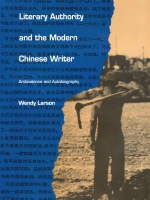 Literary Authority and the Modern Chinese Writer: Ambivalence and Autobiography
Wendy Larson
Duke University Press, 1991 Throughout the twentieth century, Chinese writers have confronted the problem of creating a new literary tradition that both maintains the culturally unique aspects of a rich heritage and succeeds in promoting a new modernity. In the first book-length treatment of the topic, Wendy Larson examines the contradictory forms of authority at work in the autobiographical texts of modern Chinese writers and scholars and the way these conflicts helped to shape and determine the manner in which writers viewed themselves, their texts, and their work.
Larson focuses on the most famous writers associated with the May Fourth Movement, a group most active in the 1920s and 1930s, and their fundamental ambivalence about writing. She analyzes how their writing paradoxically characterized textual labor as passive, negative, and inferior to material labor and the more physical political work of social progress, and she describes the ways they used textual means to devalue literary labor.
The impact of China’s increasing contact with the West—particularly the ways in which Western notions of “individualism” and “democracy” influenced Chinese ideologies of self and work—is considered. Larson also studies the changes in China’s social structure, notably those linked to the abolition in 1905 of the educational exam system, which subsequently broke the link between the mastery of certain texts and the attainment of political power, further denigrating the cultural role of the writer.
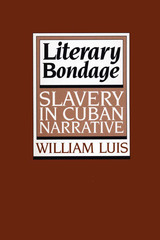 Literary Bondage: Slavery in Cuban Narrative
By William Luis
University of Texas Press, 1990 In the nineteenth century, the Cuban economy rested on the twin pillars of sugar and slaves. Slavery was abolished in 1886, but, one hundred years later, Cuban authors were still writing antislavery narratives. William Luis explores this seeming paradox in his groundbreaking study Literary Bondage, asking why this literary genre has remained a viable means of expression. Applying Foucault's theory of counter-discourse to a vast body of antislavery literature, Luis shows how these narratives have always served to undermine the foundations of slavery, to protest the marginalized status of blacks in Cuban society, and to rewrite the canon of "acceptable" history and literature. He finds that emancipation did not end the need for such counter-discourse and reveals how the antislavery narrative continues to provide a forum for voices that have been silenced by the dominant culture. In addition to such well-known works as Cecilia Valdés, The Kingdom of This World, and The Autobiography of a Runaway Slave, Luis draws on many literary works outside the familiar canon, including Romualdo, uno de tantos, Aponte, SofíaLa familia Unzúazu, El negrero, and Los guerrilleros negros. This comprehensive coverage raises important questions about the process of canon-formation and brings to light Cuba's rich heritage of Afro-Latin literature and culture.
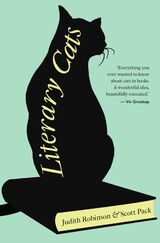 Literary Cats
Judith Robinson and Scott Pack
Bodleian Library Publishing, 2022 A light-hearted journey through the history of literary cats.
From Puss in Boots to T. S. Eliot’s Jellicles, cats have long inspired an incredible range of fiction, memoir, and poetry. This book celebrates the connections between our favorite feline friends and the literary imagination, diving into ancient myths and fables, much-loved children’s books, classic literature, and contemporary novels.
Featuring famous fictional characters such as Lewis Carroll’s Cheshire Cat, Beatrice Potter’s Tom Kitten, and Edgar Allan Poe’s Pluto, Literary Cats explores the role of felines across literary genres. This light-hearted history also uncovers their domestication, early cultural beginnings, and religious associations. The collection also reveals the history of several real-life cats such as Bob, the famous London street cat, as well as cats belonging to authors Ernest Hemingway, Patricia Highsmith, Muriel Spark, and more. A section on cats in world literature introduces narrator cats and cat companions from Japan, Eastern Europe, France, Greece, Germany, and Finland, demonstrating their enduring worldwide appeal.
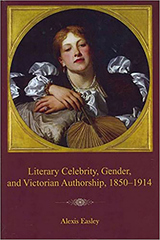 Literary Celebrity, Gender, and Victorian Authorship, 1850-1914
Alexis Easley
University of Delaware Press, 2011 This study examines literary celebrity in Britain from 1850 to 1914. Through lively analysis of rare cultural materials, Easley demonstrates the crucial role of the celebrity author in the formation of British national identity. As Victorians toured the homes and haunts of famous writers, they developed a sense of shared national heritage. At the same time, by reading sensational accounts of writers’ lives, they were able to reconsider conventional gender roles and domestic arrangements. As women were featured in interviews and profiles, they were increasingly associated with the ephemerality of the popular press and were often excluded from emerging narratives of British literary history, which defined great literature as having a timeless appeal. Nevertheless, women writers were able to capitalize on celebrity media as a way of furthering their own careers and retelling history on their own terms. Press attention had a more positive effect on men’s literary careers since they were expected to assume public identities; however, in some cases, media exposure had the effect of sensationalizing their lives, bodies, and careers. With the development of proto-feminist criticism and historiography, the life stories of male writers were increasingly used to expose unhealthy domestic relationships and imagine ideal forms of British masculinity. The first section of Literary Celebrity explores the practice of literary tourism in Victorian Britain, focusing specifically on the homes and haunts of Charles Dickens, Christina Rossetti, George Eliot, Elizabeth Barrett Browning, and Harriet Martineau. This investigation incorporates analysis of fascinating cultural texts, including maps, periodicals, and tourist guidebooks. Easley links the practice of literary tourism to a variety of cultural developments, including nationalism, urbanization, spiritualism, the women’s movement, and the expansion of popular print culture. The second section provides fresh insight into the ways that celebrity culture informed the development of Victorian historiography. Easley demonstrates how women were able to re-tell history from a proto-feminist perspective by writing contemporary history, participating in architectural reform movements, and becoming active in literary societies. In this chapter she returns to the work of Harriet Martineau and introduces a variety of lesser-known contributors to the field, including Mary Gillies and Mary Ward. Literary Celebrity concludes with a third section focused on the expansion of celebrity media at the fin de siècle. These chapters and a brief coda link the popularization of celebrity news to the de-canonization of women writers, the professionalization of medicine, the development of the open space movement, and the institutionalization of English studies. These investigations elucidate the role of celebrity media in the careers of Charlotte Robinson, Marie Corelli, Mary Braddon, Harriet Martineau, Thomas Carlyle, Ernest Hart, and Octavia Hill.
Published by University of Delaware Press. Distributed worldwide by Rutgers University Press.
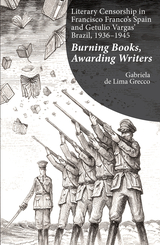 Literary Censorship in Francisco Franco’s Spain and Getulio Vargas’ Brazil, 1936–1945: Burning Books, Awarding Writers
Gabriela De Lima Grecco
Sussex Academic Press, 2022 This book presents two systems of censorship and literary promotion, revealing how literature can be molded to support authoritarian regimes. The issue is complex in that at a descriptive level the strategies and methods "new states" use to control communication through the written word can be judged by how and when formal decrees were issued, and how publishing media, whether in the form of publishing companies or at the individual level, engaged with political overseers. Literature was equally a means of resistance against an authoritarian regime, not only for writers but for readers as well. From the point of view of historical memory and intellectual history, stories of "people without history" and the production of their texts through the literary "underground" can be constructed from subsequent testimony: from books sold in secret, to the writings of women in jail, to books that were written but never published or distributed in any way, and to myriad compelling circumstances resulting from living under fascist authority. A parallel study on two fascist movements provides a unique viewpoint at literary, social, and political levels. Comparative analysis of literary censorship/literary reward allows an understanding of the balance between dictatorship, official policy, and what literary acts were deemed acceptable. The work is an important contribution to the history of twentieth-century authoritarianism and the development fascist ideas.
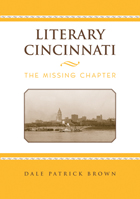 Literary Cincinnati: The Missing Chapter
Dale Patrick Brown
Ohio University Press, 2011 The history of Cincinnati runs much deeper than the stories of hogs that once roamed downtown streets. In addition to hosting the nation’s first professional baseball team, the Tall Stacks riverboat celebration, and the May Festival, there’s another side to the city—one that includes some of the most famous names and organizations in American letters. Literary Cincinnati fills in this missing chapter, taking the reader on a joyous ride with some of the great literary personalities who have shaped life in the Queen City. Meet the young Samuel Clemens working in a local print shop, Fanny Trollope struggling to open her bizarre bazaar, Sinclair Lewis researching Babbitt, hairdresser Eliza Potter telling the secrets of her rich clientele, and many more who defined the nineteenth- and early twentieth-century Queen City. For lovers of literature everywhere—but especially in Cincinnati—this is a literary tour that will entertain, inform, and amuse.
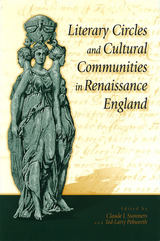 Literary Circles and Cultural Communities in Renaissance England
Edited by Claude J. Summers & Ted-Larry Pebworth
University of Missouri Press, 2001
Although the literary circle is widely recognized as a significant feature of Renaissance literary culture, it has received remarkably little examination. In this collection of essays, the authors attempt to explain literary circles and cultural communities in Renaissance England by exploring both actual and imaginary ways in which they were conceived and the various needs they fulfilled. The book also pays considerable attention to larger theoretical issues relating to literary circles.
The essayists raise important questions about the extent to which literary circles were actual constructs or fictional creations. Whether illuminating or limiting, the circle metaphor itself can be extended or reformulated. Some of the authors discuss how particular circles actually operated, and some question the very concept of the literary circle. Literary Circles and Cultural Communities in Renaissance England will be an important addition to seventeenth-century studies.
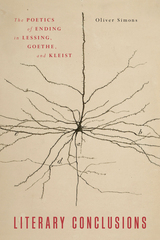 Literary Conclusions: The Poetics of Ending in Lessing, Goethe, and Kleist
Oliver Simons
Northwestern University Press, 2022 Endings are not just singular moments in time but the outcomes of a process. And whatever a book’s conclusion, its form has a history. Literary Conclusions presents a new theory of textual endings in eighteenth-century literature and thought. Analyzing essential works by Gotthold Ephraim Lessing, Johann Wolfgang von Goethe, and Heinrich von Kleist, Oliver Simons shows how the emergence of new kinds of literary endings around 1800 is inextricably linked to the history of philosophical and scientific concepts.
Simons examines the interrelations of Lessing’s literary endings with modes of logical conclusion; he highlights how Goethe’s narrative closures are forestalled by an uncontrollable vital force that was discussed in the sciences of the time; and he reveals that Kleist conceived of literary genres themselves as forms of reasoning. Kleist’s endings, Simons demonstrates, mark the beginning of modernism. Through close readings of these authors and supplemental analyses of works by Walter Benjamin, Friedrich Hölderlin, and Georg Wilhelm Friedrich Hegel, he crafts an elegant theory of conclusions that revises established histories of literary genres and forms.
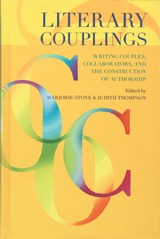 Literary Couplings: Writing Couples, Collaborators, and the Construction of Authorship
Edited by Marjorie Stone and Judith Thompson
University of Wisconsin Press, 2007 This innovative collection challenges the traditional focus on solitary genius by examining the rich diversity of literary couplings and collaborations from the early modern to the postmodern period. Literary Couplings explores some of the best-known literary partnerships—from the Sidneys to Boswell and Johnson to Sylvia Plath and Ted Hughes—and also includes lesser-known collaborators such as Daphne Marlatt and Betsy Warland. The essays place famous authors such as Samuel Coleridge, Oscar Wilde, and William Butler Yeats in new contexts; reassess overlooked members of writing partnerships; and throw new light on texts that have been marginalized due to their collaborative nature. By integrating historical studies with authorship theory, Literary Couplings goes beyond static notions of the writing "couple" to explore literary couplings created by readers, critics, historians, and publishers as well as by writers themselves, thus expanding our understanding of authorship.
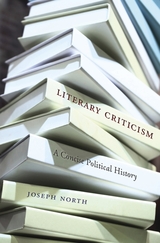 Literary Criticism: A Concise Political History
Joseph North
Harvard University Press, 2017 Literary Criticism offers a concise overview of literary studies in the English-speaking world from the early twentieth century to the present. Joseph North steps back from the usual tangle of figures, schools, and movements in order to analyze the intellectual paradigms that underpinned them. The result is a radically new account of the discipline’s development, together with a trenchant argument about where its political future lies.
People in today’s literature departments often assume that their work is politically progressive, especially when compared with the work of early- and mid-twentieth-century critics. North’s view is less cheering. For when understood in relation to the longer arc of the discipline, the current historicist and contextualist mode in literary studies represents a step to the Right. Since the global turn to neoliberalism in the late 1970s, all the major movements within literary studies have been diagnostic rather than interventionist in character: scholars have developed sophisticated techniques for analyzing culture, but they have retreated from systematic attempts to transform it. In this respect, the political potential of current literary scholarship compares poorly with that of earlier critical modes, which, for all their faults, at least had a programmatic commitment to cultural change.
Yet neoliberalism is now in crisis—a crisis that presents opportunities as well as dangers. North argues that the creation of a genuinely interventionist criticism is one of the central tasks facing those on the Left of the discipline today.
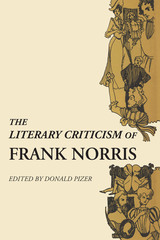 The Literary Criticism of Frank Norris
Edited by Donald Pizer
University of Texas Press, 1964 All of American author Frank Norris’s significant critical writings have been compiled in this book, including his articles for the San Francisco Wave during 1896–1897 and selections from his “Weekly Letter” column for the Chicago American in 1901. Essays from these two previously unexploited sources, comprising almost half the book, reveal certain areas of Norris’s thought which heretofore had been overlooked by scholars. This book was compiled in order to clarify Frank Norris’s literary creed. When Donald Pizer began to read Norris’s uncollected critical articles, he observed concepts which had been unnoted or misunderstood by his critics. Crediting this to the inadequate representation of Norris’s ideas in the posthumous The Responsibilities of the Novelist (1903), Pizer recognized the need for an interpretive and complete edition of Norris’s critical writings. This volume thus fills a noticeable gap in the field of American literary criticism. By the time of his death in 1902 Norris had a closed system of critical ideas. This core of ideas, however, is only peripherally related to the conventional concept of literary naturalism, which perhaps explains why critics have gone astray trying to find Zolaesque ideas in Norris’s criticism. Norris’s central idea, around which he built an aesthetic of the novel, was that the best novel combines an intensely primitivistic subject matter and theme with a highly sophisticated form. His paradox of sophisticated primitivism clarifies the vital link between the fiction produced in the 1890s and that written by Hemingway, Faulkner, and Steinbeck. Norris’s essays deal with many of the literary themes which preoccupy modern critical theorists. His range of subjects includes the form and function of the novel; definitions of naturalism, realism, and romanticism; and the problem of what constitutes an American novel. His interpretation of commonplace events, his comments on prominent figures of his day, and his parodies of writers such as Bret Harte, Stephen Crane, and Rudyard Kipling are characterized by ingenuity and perception. Through these writings the personality of a man with well-defined convictions and the ability to expound them provocatively comes into sharp focus. In a general introduction Pizer summarizes Norris’s critical position and surveys his career as literary critic. This introduction and the interpretative introductions preceding each section constitute an illuminating essay on the literary temper of the period and provide a new insight into Norris’ craft and his literary philosophy.
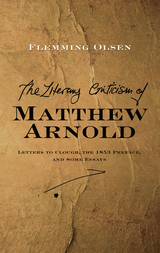 The Literary Criticism of Matthew Arnold: Letters to Clough, the 1853 Preface and Some Essays
Flemming Olsen
Sussex Academic Press, 2022 Many of the ideas that appear in Arnold's Preface of 1853 to his collection of poems and in his later essays are suggested in the letters that Arnold wrote to his friend Arthur Hugh Clough. Analysis of the Preface reveals a poet who found a theoretical basis for poetry (by which he means literature in general) in the dramas of the Greek tragedians, particularly Sophocles: action is stressed as an indispensable ingredient, wholes are preferred to parts, the didactic function of literature is promoted -- in short, the Preface reads like the recipe for a classical tragedy. It is a young poet's attempt to establish criteria for what poetry ought to be. He found the Romantic idiom outworn. Literature was, in Arnold's perception, meant to communicate a message rather than impress by its structure or by formal sophistication. Modern theories of coalescence between content and form were outside the contemporary paradigm. T S Eliot's ambivalent attitude to Arnold -- now reluctantly admiring, now decidedly patronizing -- is puzzling. Eliot never seemed able to liberate himself from the influence of Arnold. What in Arnold's critical oeuvre attracted and at the same time repelled Eliot? That question has led to an in-depth analysis of Arnold as a literary critic. This book begins with an examination of Arnold's letters to Clough, where "it all started" and proceeds with a close reading of the 1853 Preface. A look at some of the later literary essays rounds off the picture of Arnold as a literary critic. This work is the result of Reader and Review comments of the author's well received Eliot's Objective Criticism: Tradition or Individual Talent? "Yet he is in some respects the most satisfactory man of letters of his age." -- T S Eliot, The Use of Poetry and the Use of Criticism.
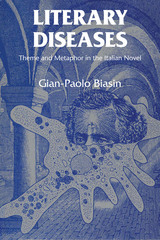 Literary Diseases: Theme and Metaphor in the Italian Novel
By Gian-Paolo Biasin
University of Texas Press, 1975 Disease—real or imagined, physical or mental—is a common theme in Western literature and is often a symbol of modern alienation. In Literary Diseases, a comprehensive analysis of the metaphorical and symbolic force of disease in modern Italian literature, Gian-Paolo Biasin expands the geography of the discussion of this important theme. Using as a backdrop the perspective of European experiences of the previous hundred years, Biasin analyzes the theme of disease as a reflection of certain sociological and historical phenomena in modern European novels, as a metaphor for the world visions of selected Italian novelists, and especially as a vehicle for understanding the nature and function of fiction itself. The core of Biasin’s study is found in his discussion of the works of four major Italian writers. In his criticism of the novels of Giovanni Verga, who stood at the center of many complex developments in the nineteenth century, he examines the antecedents of modern Italian prose. He then scrutinizes the works of Italo Svevo and Luigi Pirandello, who together inaugurated the modern novel in Italy. Of particular interest is his exploration of their critical use of psychoanalysis and madness climaxed by apocalyptic visions. He then discusses the prose of Carlo Emilio Gadda, which epitomizes the problems of the avant-garde in its experimentalism and expressionism. Biasin utilizes a broad spectrum of critical approaches—from sociology, psychoanalysis, and different trends in modern French, American, and Italian literary criticism—in shaping his own methodology, which is a thematic and structural symbolism. He concludes that disease in literature should be considered as a metaphor for writing (écriture) and as a cognitive instrument that calls into question the anthropocentric values of Western culture. The book, with its textual comparisons and unusual supporting examples, constitutes a significant methodological contribution as well as a major survey of modern Italian prose, and will allow the reader to see traditional landmarks in European fiction in a new light.
 Literary Dissent in Communist China
Merle Goldman
Harvard University Press In modern China, literature has been regarded as a vehicle of political and idea logical dissent, a concept that has persisted under communism. This study exhaustively analyzes the conflict between the Chinese Communist party and the intellectuals, particularly the writers, in the crucial decades of the 1940's and 1950's.
By singling out individual writers as egregious examples, party leaders, through a series of thought-control campaigns, have tried to mold intellectuals along orthodox doctrinal lines. But these same leaders, holding to the paradoxical conviction that personal initiative and creativity are necessary catalysts in the effort to construct a Communist state, have not wanted to stifle these qualities altogether. The result has been a pattern of permissiveness and pressure, as illustrated by the ill-fated "Hundred Flowers" movement and the subsequent return to a policy of harsh regimentation.
In depicting the views, feelings, frustrations, and tragic fates of many individual intellectuals in the confrontation with an oppressive party bureaucracy, the author reveals, in an unprecedented way, the nature of the authoritarian society that has evolved in Communist China. Her study convincingly demonstrates that totalitarian rule has not guaranteed the subservience of the Chinese intelligentsia and, even more important, that the alienated, critical intellectual remains a significant and vital force.
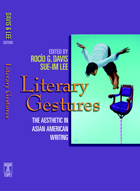 Literary Gestures: The Aesthetic in Asian American Writing
edited by Rocío G. Davis and Sue-Im Lee
Temple University Press, 2005 Literary Gestures:The Aesthetic in Asian American Writing contests the dominance of materialist and cultural critiques in Asian American literary discourse by re-centering critical attention around issues of aesthetics and literary form. Collapsing the perceived divisions between the "ethnic" and the "aesthetic" in Asian American literary criticism, the eleven original essays in this volume provide theoretically sophisticated and formally sensitive readings of works in prose, poetry, and drama. These contributions bring discussions of genre, canonicity, narrative, and literary value to the fore to show how aesthetic and formal concerns play an important part in the production and consumption of these works. By calling for a more balanced mode of criticism, this collection invites students and scholars to reinvest in the literary, not as a negation of the sociopolitical, but as a complementary strategy in reading and understanding Asian American literature.
 The Literary Guide and Companion to Southern England: Revised Edition
Robert M. Cooper
Ohio University Press, 1998 In a series of intriguing routes through the English countryside, Professor Robert Cooper notes those attractions that the casual tourist might unknowingly pass by, such as the house where Dickens wrote A Tale of Two Cities, or the windswept quay where John Fowles’s French Lieutenant’s woman walked. Maps and information about restaurants and accommodations give the traveler the opportunity of having pints of “half and half” where Jane Austen dined or visiting the pub where Blake’s scuffle led to his trial for treason. This newly revised and updated edition of Robert Cooper’s acclaimed handbook combines the utility of current travel information with the appeal of literary history, biography, and anecdote in a leisurely and flavorful guide to the broad sweep of southern England outside of London. A rich and reliable guide to the landscape that fostered one of our most cherished cultures, The Literary Guide and Companion to Southern England is an indispensable resource for those who wish to experience literature firsthand.
 A Literary Guide to Provence
Daniel Vitaglione
Ohio University Press, 2001 Provence through the eyes of its writers—those who wrote of it in Provençal or French and also those visitors who were moved by its beauty—that is the inspiration behind A Literary Guide to Provence. In this compact travel guide, Marseilles native Daniel Vitaglione presents a literary panorama of the region of southern France from the Avignon of Mistral to Colette’s St. Tropez. Including such sites as the birthplace of Nostradamus and the ruins of the Marquis de Sade’s castle, A Literary Guide to Provence presents a thousand years of history entwined with maps and photos that provide readers on tour with a sense of the historical import of this most beautiful of regions even as they experience it firsthand. Both authors of Provençal ancestry and those who came to love and live in Provence are featured in this comprehensive and enchanting picture of the garden place of France. The Riviera enticed Virginia Woolf. Toulon inspired two novels by Georges Sand. Robert Louis Stevenson resided in Hyères, as did Edith Wharton. Le Lavandou was Willa Cather’s favorite place. F. Scott Fitzgerald lived in St. Raphael and Juan-les-Pins, where he wrote Tender is the Night. This illustrated guide follows in these writers’ footsteps, and the practical information on hotels and restaurants (phones, web sites, email, etc.) make it the ideal traveling companion for armchair tourists and those who cannot resist seeing Provence for themselves.
The Literary Guide to the Bible
Robert Alter
Harvard University Press, 1986 Rediscover the incomparable literary richness and strength of a book that all of us live with an many of us live by. An international team of renowned scholars, assembled by two leading literary critics, offers a book-by-book guide through the Old and New Testaments as well as general essays on the Bible as a whole, providing an enticing reintroduction to a work that has shaped our language and thought for thousands of years.
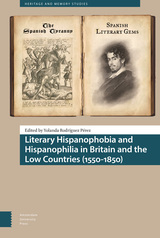 Literary Hispanophobia and Hispanophilia in Britain and the Low Countries (1550-1850)
Yolanda Rodríguez Pérez
Amsterdam University Press, 2020 Spain has been a fruitful locus for the European imagination for centuries, and it has been most often perceived in black-and-white oppositions -- either as a tyrannical and fanatical force in the early modern period or as an imaginary geography of a ‘Romantic’ Spain in later centuries. However, the image of Spain, its culture and its inhabitants did not evolve inexorably from negative to positive. From the early modern period onwards, it responded to an ambiguous matrix of conflicting Hispanophobic and Hispanophilic representations. Just as in the nineteenth century latent negative stereotypes continued to resurface, even in the Romantic heyday, in the early modern period appreciation for Spain was equally undeniable. When Spain was a political and military superpower, it also enjoyed cultural hegemony with a literary Golden Age producing internationally hailed masterpieces. Literary Hispanophobia and Hispanophilia in Britain and the Low Countries (1550-1850) explores the protracted interest in Spain and its culture, and it exposes the co-existent ambiguity between scorn and fascination that characterizes Western historical perceptions, in particular in Britain and the Low Countries, two geographical spaces with a shared sense of historical connectedness and an overlapping, sometimes complicated, history with Spain.
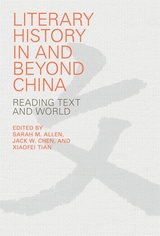 Literary History in and beyond China: Reading Text and World
Sarah M. Allen, Jack W. Chen, and Xiaofei Tian
Harvard University Press, 2023 Literary History in and beyond China: Reading Text and World explores the idea of literary history across the long span of the Chinese tradition. Although much scholarship on Chinese literature may be characterized as doing the work of literary history, there has been little theoretical engagement with received literary historical categories and assumptions, with how literary historical judgments are formed, and with what it means to do literary history in the first place. The present collection of essays addresses these questions from perspectives emerging both from within the tradition and from without, examining the anthological histories that shape the concept of a particular genre, the interpretive positions that impel our aesthetic judgments, the conceptual categories that determine how literary history is framed, and the history of literary historiography itself. As such, the essays collectively consider what it means to think through the framework of literary history, what literary history affords or omits, and what needs to be theorized in terms of literary history’s constraints and possibilities.
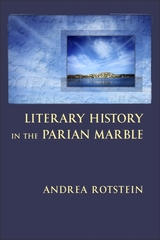 Literary History in the Parian Marble
Andrea Rotstein
Harvard University Press, 2014 Inscribed some time after 264 BCE, the Parian Marble offers a chronological list of events with an exceptional emphasis on literary matters. Literary History in the Parian Marble explores the literary and historiographical qualities of the inscription, the genre to which it belongs, and the emerging patterns of time. Endorsing the hypothesis that the inscription was originally displayed at a Parian shrine honoring Archilochus, Andrea Rotstein argues that literary history was one of its main concerns. Though it may be conventional in its focus on the chronology of poets, their inventions and victories, the Parian Marble is nonetheless idiosyncratic in the range of authors displayed. By reconstructing the methods by which information might have been obtained, Rotstein contributes to an understanding of the way literary history was practiced within the local communities of ancient Greece, away from the major Hellenistic centers of scholarship.
The Parian chronicle has not been the subject of a comprehensive study for almost a century. Literary History in the Parian Marble brings to the English-speaking audience up-to-date information about the inscription, including a revision of Felix Jacoby’s Greek text and a complete translation.
 A Literary History of Iowa
Clarence A. Andrews
University of Iowa Press, 1972 Originally published in 1972, A Literary History of Iowa, which features writers published in book form between 1856 and the late 1960s, returns to print. One of Iowa's native sons, Ellis Parker Butler, once said that in Iowa 12 dollars were spent for fertilizer each time a dollar was spent for literature. Many readers will be surprised to learn from this book the extent of Iowa's distinguished literary past---the many prizes and praise received by her authors. To those already familiar with Iowa's credits, A Literary History of Iowa will be a nostalgic and informative delight. During the 1920s and 1930s, Iowa had good claim to recognition as the literary capital of the country. Clarence Andrews says that as he grew up he knew a host of Iowa writers. "I also knew that Iowa was winning a diproportionate share of the Pulitzer Prizes---Hamlin Garland, Margaret Wilson, Susan Glaspell, Frank Luther Mott, "Ding" Darling, Clark Mollenhoff. It was winning its share or more of prizes offered by publishers---and its authors' books were being selected as Book-of-the-Month and Literary Guild books. I knew too about Carl Van Vechten as part of that avant-garde group of midwest exiles---including Fitzgerald, Anderson, and Hemingway."A Literary History of Iowa looks at Iowans who knew and cared for the state---people who wrote poetry, plays, musical plays, novels, and short stories about Iowa subjects, Iowa ideas, Iowa people. These writers often have dealt with such themes as the state's history, the rise of technology and its impact on the community, provincialism and exploitation, the problems of personal adjustment, and the family and the community. John T. Frederick, whose own books are paramount in Iowa's literary history, has pointed to Iowa's special contributions to the literature of rural life in saying that no other state can show its portrayal in "fiction so rich, so varied, and so generally sound as can Iowa."
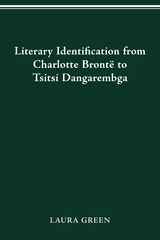 Literary Identification from Charlotte Brontë to Tsitsi Dangarembga
Laura Green
Ohio State University Press, 2012 Literary Identification from Charlotte Brontë to Tsitsi Dangarembga, by Laura Green, seeks to account for the persistent popularity of the novel of formation, from nineteenth-century English through contemporary Anglophone literature. Through her reading of novels, memoirs, and essays by nineteenth-, twentieth-, and twenty-first-century women writers, Green shows how this genre reproduces itself in the elaboration of bonds between and among readers, characters, and authors that she classifies collectively as “literary identification.” Particular literary identifications may be structured by historical and cultural change or difference, but literary identification continues to undergird the novel of formation in new and evolving contexts. The two nineteenth-century English authors discussed in this book, Charlotte Brontë and George Eliot, established the conventions of the novel of female formation. Their twentieth-century English descendants, Virginia Woolf, Radclyffe Hall, and, Jeanette Winterson, challenge the dominance of heterosexuality in such narratives. In twentieth- and twenty-first-century narratives by Simone de Beauvoir, Jamaica Kincaid, and Tsitsi Dangarembga, the female subject is shaped not only by gender conventions but also by colonial and postcolonial conflict and national identity.. For many contemporary critics and theorists, identification is a middlebrow or feminized reading response or a structure that functions to reproduce the middle-class subjectivity and obscure social conflict. However, Green suggests that the range and variability of the literary identifications of authors, readers, and characters within these novels allows such identifications to function variably as well: in liberatory or life-enhancing ways as well as oppressive or reactionary ones.
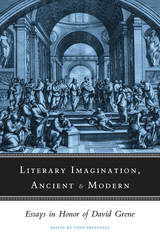 Literary Imagination, Ancient and Modern: Essays in Honor of David Grene
Edited by Todd Breyfogle
University of Chicago Press, 1999 Perhaps best known for his widely acclaimed translations of the Greek tragedies and Herodotus's History, as well as his edition of Hobbes's Thucydides, David Grene has also had a major impact as a teacher and interpreter of texts both ancient and modern. In this book, distinguished colleagues and former students explore the imaginative force of literature and history in articulating and illuminating the human condition.
Ranging as widely as Grene's own interests in Greek and Roman antiquity, in drama, poetry, and the novel, in the art of translation, and in English history, these essays include discussions of the Odyssey and Ulysses, the Metamorphoses of Ovid and Apuleius, Mallarmé's English and T. S. Eliot's religion, and the mutually antipathetic minds of Edmund Burke and Thomas Jefferson. The introduction by Todd Breyfogle sketches for the first time the contours of Grene's own thought.
Classicists, political theorists, intellectual historians, philosophers, and students of literature will all find much of value in the individual essays here and in the juxtaposition of their themes.
Contributors: Saul Bellow, Seth Benardete, Todd Breyfogle, Amirthanayagam P. David, Wendy Doniger, Mary Douglas, Joseph N. Frank, Victor Gourevitch, Nicholas Grene, W. R. Johnson, Brendan Kennelly, Edwin McClellan, Françoise Meltzer, Stephanie Nelson, Conor Cruise O'Brien, Martin Ostwald, Robert B. Pippin, James Redfield, Sandra F. Siegel, Norma Thompson, and David Tracy
 Literary Intellectuals and the Dissolution of the State: Professionalism and Conformity in the GDR
Edited by Robert von Hallberg
University of Chicago Press, 1996 For two generations, writers in the German Democratic Republic enjoyed a massive audience in their own country, a readership dependent on their works for a measure of utopian solace amid the grimness of life under Communism. But after the fall of the Berlin Wall, these writers were abandoned by their readers and stripped of the professional structures that had supported them. Their literary culture destroyed, they were rebuked for compliant service to the discredited state; and some were reviled for collaborating with the East German secret police, the Stasi.
What drove leading thinkers, including those of the avant-garde who publicly embraced intellectual freedom, to serve as government informants? Why were they content to work within a repressive system rather than challenging it outright? This collection of interviews with more than two dozen writers and literary scholars, including several Stasi informants, provides a gripping, often dismaying picture of the motivations, compromises, and illusions of East German intellectual life.
In conversations with Robert von Hallberg, writers such as best-selling novelist Hermann Kant, playwright Christoph Hein, and avant-garde poet-publisher Sascha Anderson talk about their lives and work before the fall of the wall in 1989—about the constraints and privileges of Communist Party membership, experiences of government censorship and self-censorship, and relations with their readers. They reflect on why the possibilities of opposition to the state seemed so limited, and on how they might have found ways to resist more aggressively. Turning to the controversies that have emerged since reunification, including the Stasi scandals involving Anderson and Christa Wolf, they discuss their feelings of complicity and the need for further self-examination. Two interviews with Anderson—one conducted before he was exposed as a Stasi collaborator and one conducted afterward—offer unique insight into the double life led by many writers and scholars in the German Democratic Republic.
 Literary Interest: The Limits of Anti-Formalism
Steven Knapp
Harvard University Press, 1993 Is there such a thing as a specifically literary discourse, distinguishable from other modes of thought and writing? Is there any way to defend the intuition that a work of literature says something that can't be said in any other way? Drawing on recent work in the philosophies of language and action, Steven Knapp presents a challenging new definition of “the literary” in a forceful analysis that will radically change the sometimes heated debate about formalism.
Formalist theorists have maintained that the uniqueness of the literary lies in the special nature of literary language. Their critics argue that to draw sharp distinctions between literary and nonliterary language is to privilege one kind of text and to insulate cultural activity from social conflict and political change. In the course of a rigorous engagement with such literary theorists, old and new, Knapp develops a provocative defense of the notion of a uniquely literary mode of discourse—a defense that challenges proponents as well as critics of formalism. He extends and deepens current debates about the literary canon, the purpose of literary study, and the aims and implications of the recent critical return to history. His bold and surprising argument has significance for the ethical and political role of literary studies that no one interested in literary theory or the philosophy of art will be able to ignore. Literary Interest will engage theorists, literary critics in all fields, and philosophers addressing issues of aesthetics and language.
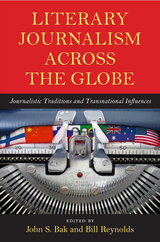 Literary Journalism across the Globe: Journalistic Traditions and Transnational Influences
John S. Bak
University of Massachusetts Press, 2011 At the end of the nineteenth century, several countries were developing journalistic traditions similar to what we identify today as literary reportage or literary journalism. Yet throughout most of the twentieth century, in particular after World War I, that tradition was overshadowed and even marginalized by the general perception among democratic states that journalism ought to be either "objective," as in the American tradition, or "polemical," as in the European. Nonetheless, literary journalism would survive and, at times, even thrive. How and why is a story that is unique to each nation.
Though largely considered an Anglo-American phenomenon today, literary journalism has had a long and complex international history, one built on a combination of traditions and influences that are sometimes quite specific to a nation and at other times come from the blending of cultures across borders. These essays examine this phenomenon from various international perspectives, documenting literary journalism's rich and diverse heritage and describing its development within a global context.
In addition to the editors, contributors include David Abrahamson, Peiqin Chen, Clazina Dingemanse, William Dow, Rutger de Graaf, John Hartsock, Nikki Hessell, Maria Lassila-Merisalo, Edvaldo Pereira Lima, Willa McDonald, Jenny McKay, Sonja Merljak Zdovc, Sonia Parratt, Norman Sims, Isabel Soares,and Soenke Zehle.
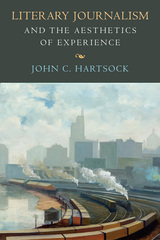 Literary Journalism and the Aesthetics of Experience
John C. Hartsock
University of Massachusetts Press, 2016 Proponents and practitioners of narrative literary journalism have sought to assert its distinctiveness as both a literary form and a type of journalism. In Literary Journalism and the Aesthetics of Experience, John C. Hartsock argues that this often neglected kind of journalism—exemplified by such renowned works as John Hersey’s Hiroshima, James Agee’s Let Us Now Praise Famous Men, and Joan Didion’s Slouching Towards Bethlehem—has emerged as an important genre of its own, not just a hybrid of the techniques of fiction and the conventions of traditional journalism. Hartsock situates narrative literary journalism within the broader histories of the American tradition of “objective” journalism and the standard novel. While all embrace the value of narrative, or storytelling, literary journalism offers a particular “aesthetics of experience” lacking in both the others. Not only does literary journalism disrupt the myths sustained by conventional journalism and the novel, but its rich details and attention to everyday life question readers’ cultural assumptions. Drawing on the critical theories of Nietzsche, Bakhtin, Benjamin, and others, Hartsock argues that the aesthetics of experience challenge the shibboleths that often obscure the realities the other two forms seek to convey. At a time when print media appear in decline, Hartsock offers a thoughtful response to those who ask, “What place if any is there for a narrative literary journalism in a rapidly changing media world?”
Literary Journalism in the Twentieth Century
Norman Sims
Northwestern University Press, 2008 This wide-ranging collection of critical essays on literary journalism addresses the shifting border between fiction and non-fiction, literature and journalism. Literary Journalism in the Twentieth Century addresses general and historical issues, explores questions of authorial intent and the status of the territory between literature and journalism, and offers a case study of Mary McCarthy’s 1953 piece, "Artists in Uniform," a classic of literary journalism. Sims offers a thought-provoking study of the nature of perception and the truth, as well as issues facing journalism today.
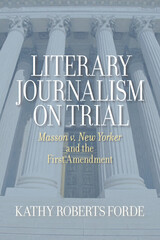 Literary Journalism on Trial: Masson v. New Yorker and the First Amendment
Kathy Roberts Forde
University of Massachusetts Press, 2008 In November 1984, Jeffrey Masson filed a libel suit against writer Janet Malcolm and the New Yorker, claiming that Malcolm had intentionally misquoted him in a profile she wrote for the magazine about his former career as a Freud scholar and administrator of the Freud archives. Over the next twelve years the case moved up and down the federal judicial ladder, at one point reaching the U.S. Supreme Court, as lawyers and judges wrestled with questions about the representation of "truth" in journalism and, by extension, the limits of First Amendment protections of free speech. Had a successful Freudian scholar actually called himself an "intellectual gigolo" and "the greatest analyst who ever lived"? Or had a respected writer for the New Yorker knowingly placed false, self-damning words in her subject's mouth? In Literary Journalism on Trial, Kathy Roberts Forde explores the implications of Masson v. New Yorker in the context of the history of American journalism. She shows how the case represents a watershed moment in a long debate between the advocates of traditional and literary journalism and explains how it reflects a significant intellectual project of the period: the postmodern critique of objectivity, with its insistence on the instability of language and rejection of unitary truth in human affairs. The case, Forde argues, helped widen the perceived divide between ideas of literary and traditional journalism and forced the resolution of these conflicting conceptions of truth in the constitutional arena of libel law. By embracing traditional journalism's emphasis on fact and objectivity and rejecting a broader understanding of truth, the Supreme Court turned away from the First Amendment theory articulated in previous rulings, opting to value less the free, uninhibited interchange of ideas necessary to democracy and more the "trustworthiness" of public expression. The Court's decision in this case thus had implications that reached beyond the legal realm to the values and norms expressed in the triangular relationship between American democracy, First Amendment principles, and the press.
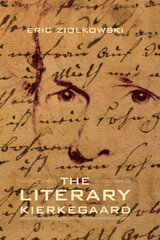 The Literary Kierkegaard
Eric Ziolkowski
Northwestern University Press, 2011 Eric Ziolkowski’s monumental study examines Kierkegaard’s “whole ‘prolix literature,’” including both the pseudonymous and the signed published writings as well as the private journals, papers, and letters, in relation to works by five literary giants from different times and places: Clouds by Aristophanes; Parzival by the medieval German poet Wolfram von Eschenbach; Don Quixote by Cervantes; certain plays, particularly Hamlet, by Shakespeare; and the fictional, poeticphilosophical work Sartor Resartus, together with some of the essays by Kierkegaard’s Scottish contemporary Thomas Carlyle. No full or complete understanding of the writings of an author as prolific and complex as Kierkegaard is possible.
Yet Kierkegaard signals the essentially literary as opposed to strictly theological or philosophical nature of his writings. Ziolkowski first considers the notions of aesthetics and the aesthetic as Kierkegaard adapted them, and then his posture as a poet, as interrelated contexts of his selfconception as “a weed in literature.” After next taking account of the history of the critical recognition of Kierkegaard as a literary artist, he looks at an important characteristic of his literary craft that has received relatively little attention: the manner by which he and his pseudonyms read and quote other authors. Ziolkowski then explores the connections between the philosopher’s writings and those of other literary masters by whom he was directly influenced, such as Aristophanes, Cervantes, and Shakespeare; or of those who, while they did not directly influence him, gave paradigmatic expression to some of the same aspects of aesthetic, ethical, and religious existence that Kierkegaard and his pseudonyms portray. Ziolkowski’s seminal study will be of interest to Kierkegaard scholars, philosophers, and comparative literature scholars alike.
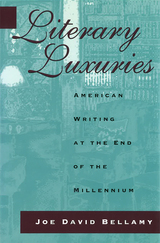 Literary Luxuries: American Writing at the End of the Millennium
Joe David Bellamy
University of Missouri Press, 1995
From the Iowa Writers Workshop to the halls of Congress and the National Endowment for the Arts, from the world of literary magazines and writers' conferences to the bizarre realm of the late-twentieth-century American English department, Literary Luxuries takes the reader on a guided tour of American literary life in our time--and the forces threatening its existence.
Joe David Bellamy has been a significant figure on the literary scene during the last three decades; as a "literary Everyman," he offers in Literary Luxuries a distinctive and valuable perspective on the culture wars, on education and the imagination, on particular writers and major literary and aesthetic movements, on the role of government in fostering cultural development, and on the day-to-day strife of the writer's life in the United States.
As director of the literature program of the National Endowment for the Arts, Bellamy had the unenviable task of trying to persuade Congress and ordinary citizens that American literature is worthy of support, and in Literary Luxuries he continues that debate and helps us to understand its implications: "Literature is our national treasury of language and style and our best reckoning about human life, as it is lived in this time and place."
Part memoir, part critique, part impassioned defense of American literary culture and the values it espouses and struggles to uphold, Literary Luxuries offers unforgettable commentary on the literary life in the United States during the last decades of the twentieth century as described from the perspective of one of its key participants.
Literary Modernism and the Transformation of the Work
James F. Knapp
Northwestern University Press, 1988 Literary Modernism and the Transformation of Work probes the relationship between the aesthetic structures of modernism and its political and philosophical shape. James F. Knapp explores modernism's engagement with and reaction to the theories and discourse of scientific management that were reshaping the workplace in the early twentieth century, and in so doing, he traces "the ways in which a socially dominant discourse of knowledge is reproduced—and challenged—through a series of texts that range from the marginal to the most fully canonized."
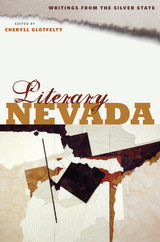 Literary Nevada: Writings from the Silver State
Cheryll Glotfelty
University of Nevada Press, 2008 Over 200 writings about Nevada with selections from Native American tales to contemporary writings on urban experience and environmental concerns. The state of Nevada embodies paradox and contradiction—home to one of the fastest-growing cities in the nation and to isolated ranches scattered across a sparsely populated backcountry. Nevada is a place where the lust for sudden wealth has prompted both wild mining booms and glittering casinos, and where forbidding atomic test sites coexist with alluring tourist meccas. The variety and distinctiveness of Nevada’s landscape and peoples have inspired writers from the beginning of immigrant contact with the region. This contact has produced abundant literary wealth that includes the rich oral traditions of Native American peoples and an amazing spectrum of contemporary voices. Literary Nevada is the first comprehensive literary anthology of Nevada. It contains over 200 selections ranging from traditional Native American tales, explorers’ and emigrants’ accounts, and writing from the Comstock Lode and other mining boomtowns, as well as compelling fiction, poetry, and essays from throughout the state’s history. There is work by well-known Nevada writers such as Sarah Winnemucca, Mark Twain, and Robert Laxalt, by established and emerging writers from all parts of the state, and by some nonresident authors whose work illuminates important facets of the Nevada experience. The book includes cowboy poetry, travel writing, accounts of nuclear Nevada, narratives about rural life and urban life in Las Vegas and Reno, poetry and fiction from the state’s best contemporary writers, and accounts of the special beauty of wild Nevada’s mountains and deserts. Editor Cheryll Glotfelty provides insightful introductions to each section and author. The book also includes a photo gallery of selected Nevada writers and a generous list of suggested further readings. Nevada has inspired an exceptionally rich panorama of fine writing and a dazzling array of literary voices. The selections in Literary Nevada will engage and delight readers while revealing the complex and exciting diversity of the state’s history, people, and life.
 Literary Pioneers: Early American Explorers of European Culture
Orie William Long
Harvard University Press George Ticknor, Edward Everett, Joseph Green Cogswell, George Bancroft, Henry Wadsworth Longfellow, and John Lothrop Motely are the pioneers studied in successive essays of this volume. They were the first Americans of distinction to study abroad, the earliest explorers of European culture, apostles of learning, cosmopolitans in the truest sense of that term, serving as an important connecting link in the intellectual relations between the two continents. The book presents a detailed analysis of their experiences and impressions and of their many interesting contacts as they wandered over Europe and Great Britain, meeting almost everyone of eminence. It further shows the rich contributions these scholars made upon their return home to the progress of human knowledge and to the advancement of American intellectual life in the nineteenth century. Each essay presents much material that has hitherto been unpublished and fresh and vital points of view.
 Literary Politics in the Soviet Ukraine, 1917-1934
George S. N. Luckyj
Duke University Press, 1990 Literary Politics in the Soviet Ukraine, 1917–1934 illuminates the flowering of Ukrainian literature in the 1920s and the subsequent purge of Soviet Ukrainian writers during the following Stalinist decade. Upon its original publication in 1956, George S. N. Luckyj’s book won the praise of American and English critics, but was violently attacked by Soviet critics who labeled it a “slander on the Soviet Union.” In the current political environment of glasnost, the book’s findings have been acknowledged and supported by Soviet scholars. Moreover, this new critical corroboration has enabled the author to discover that the 1930s purge was more brutal than was previously estimated.
The new edition reissues Luckyj’s critical work in light of current political developments and reflects the revision of previous findings. Luckyj originally drew on published Soviet sources and the important unpublished papers of a Soviet Ukrainian writer who defected to the West to describe how the brief literary revival in the Soviet Ukraine in the 1920s was abruptly halted by Communist Party controls. The present volume features a new preface, an additional chapter covering recent Soviet attitudes toward the literature of the 1920s and 1930s, and an updated bibliography.
Literary Publishing in America, 1790-1850
William Charvat
University of Massachusetts Press, 1993 Available for the first time in paperback, this book is a succinct distillation of the work and thought of William Charvat, a pioneer in the study of the history of the American book. This burgeoning field of inquiry investigates the social and cultural context of the act of literary creation by relating it to the modes of its production and distribution. This new edition of Literary Publishing in America contains an afterword by Michael Winship that discusses scholarship in the field since publication of Charvat's groundbreaking work.
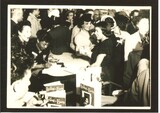 Literary Sisters: Dorothy West and Her Circle, A Biography of the Harlem Renaissance
Mitchell, Verner D
Rutgers University Press, 2012 Harlem Renaissance writer Dorothy West led a charmed life in many respects. Born into a distinguished Boston family, she appeared in Gershwin’s Porgy and Bess, then lived in the Soviet Union with a group that included Langston Hughes, to whom she proposed marriage. She later became friends with Jacqueline Kennedy Onassis, who encouraged her to finish her second novel, The Wedding, which became the octogenarian author’s first bestseller. Literary Sisters reveals a different side of West’s personal and professional lives—her struggles for recognition outside of the traditional literary establishment, and her collaborations with talented African American women writers, artists, and performers who faced these same problems. West and her “literary sisters”—women like Zora Neale Hurston and West’s cousin, poet Helene Johnson—created an emotional support network that also aided in promoting, publishing, and performing their respective works. Integrating rare photos, letters, and archival materials from West’s life, Literary Sisters is not only a groundbreaking biography of an increasingly important author but also a vivid portrait of a pivotal moment for African American women in the arts.
Literary Speech Acts of the Medieval North: Essays Inspired by the Works of Thomas A. Shippey
Eric Shane Bryan
Arizona Center for Medieval and Renaissance Studies, 2020 This volume brings together examinations of pragmatic meaning and proverbs of the Medieval North. Pragmatic meaning, which relies upon cultural and interpersonal context to go beyond the simple semantic and grammatical meaning of an utterance, has a fundamental connection with proverbs, which also communicate a deeper meaning than what is actually said. Essays in this volume explore this connection by examining the language of generosity, conversion, friendship, debate, dragon proverbs, and saints’ lives. These essays are inspired by the works of Thomas A. Shippey, who has been a pioneer in the study of wisdom poetry and pragmatics in medieval literature.
 Literary Structure, Evolution, and Value: Russian Formalism and Czech Structuralism Reconsidered
Jurij Striedter
Harvard University Press, 1989 Jurij Striedter provides a dynamic introduction to and critique of Russian Formalism and Czech Structuralism. He makes clear the pathbreaking contribution of these European schools to modern literary theory and criticism, placing them in their contemporary contexts and at the same time relating them to ongoing debates in America.
Striedter gives an authoritative account of the development of Russian Formalism from its birth around 1915 through its forced end in the late 1920s, focusing on the contributions of Roman Jakobson, Mikhail Bakhtin, and others to the theory and analysis of literary history, literary genres and narrative prose. He compares the concepts of the literary work, literature as system, and literary evolution in both Russian Formalism and Czech Structuralism to show how these early formalistic approaches led to an elaborated structuralist and semiotic concept of literature as a historically changing system correlated to society and cultural change. He sets forth the work of Jan Mukarovsky and Felix Vodicka, whose Czech Structuralist theory of literary evolution and literary reception (or reader response) anticipated much recent theorizing.
Finally, Striedter brings these ideas into play by showing how they can contribute to the debate of the last few years in North America and Europe about the key issue of literary evaluation. This book and the theories it discusses challenge our contemporary understanding of literature, its history, and its functions in society and human life.
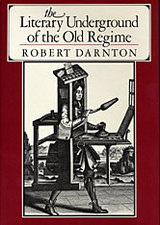 The Literary Underground of the Old Regime
Robert Darnton
Harvard University Press, 1982 “This is splendid historical writing…Darnton [has] a well-justified reputation as one of the most original contributors to our understanding of life in pre-revolutionary Paris.” —New York Review of Books
Robert Darnton introduces us to the shadowy world of pirate publishers, garret scribblers, under-the-cloak book peddlers, smugglers, and police spies that composed the literary underground of the Enlightenment.
Here are the ambitious writers who crowded into Paris seeking fame and fortune within the Republic of Letters, but who instead sank into the miserable world of Grub Street—victims of a closed world of protection and privilege. Venting their frustrations in an illicit literature of vitriolic pamphlets, libelles, and chroniques scandaleuses, these “Rousseaus of the gutter” desecrated everything sacred in the social order of the Old Regime. Here too are the workers who printed their writings and the clandestine booksellers who distributed them.
While censorship, a monopolistic guild, and the police contained the visible publishing industry within the limits of official orthodoxies, a prolific literary underworld disseminated a vast illegal literature that conveyed a seditious ideology to readers everywhere in France. Covering their traces in order to survive, the creators of this eighteenth-century counterculture have virtually disappeared from history. By drawing on an ingenious selection of previously hidden sources, such as police ledgers and publishers’ records, Robert Darnton reveals for the first time the fascinating story of that forgotten underworld.
The activities of the underground bear on a broad range of issues in history and literature, and they directly concern the problem of uncovering the ideological origins of the French Revolution. This engaging book illuminates those issues and provides a fresh view of publishing history that will inform and delight the general reader.
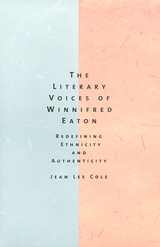 The Literary Voices of Winnifred Eaton: Redefining Ethnicity and Authenticity
Cole, Jean Lee
Rutgers University Press, 2002 Winnifred Eaton, better known under her Japanese-sounding pseudonym, Onoto Watanna, published over a dozen novels and hundreds of short stories, articles, and screenplays during the first half of the twentieth century. However, by the time of her death in 1954, most of her books were out of print.
Eaton attempted to disguise her Chinese heritage by writing under a hypothetically Japanese pen name. In legal documents, she usually claimed a "white" racial identity. In her fiction, Eaton portrayed Japanese, Chinese, Irish, and American characters, relying on the accepted stereotypes of the day. Jean Lee Cole shows that the many voices Eaton adopted show her deep preoccupations with "American" identity as a whole. The author attempts to reconcile all of these "voices," examining how Eaton survived in a climate hostile to minority writers in the early twentieth century, and how her seemingly anomalous works conjoin Asian American and American literary history.
The Literary Work of Art: An Investigation of the Borderlines of Ontology, Logic, and Theory of Language
Roman Ingarden
Northwestern University Press, 1973 This long-awaited translation of Das literarische Kunstwerk makes available for the first time in English Roman Ingarden's influential study. Though it is inter-disciplinary in scope, situated as it is on the borderlines of ontology and logic, philosophy of literature and theory of language, Ingarden's work has a deliberately narrow focus: the literary work, its structure and mode of existence.
The Literary Word of Art establishes the groundwork for a philosophy of literature, i.e., an ontology in terms of which the basic general structure of all lliterary works can be determined. This "essential anatomy" makes basic tools and concepts available for rigorous and subtle aesthetic analysis.
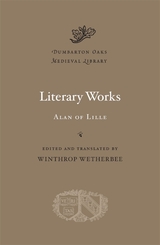 Literary Works
Alan of Lille
Harvard University Press, 2013 A product of the cathedral schools that played a foundational role in the so-called Twelfth-Century Renaissance, Alan of Lille was renowned for the vast learning which earned him the title of Doctor Universalis. His writings include many significant contributions to the development of systematic theology, but he was also the most important Latin poet of his time, the great age of Medieval Latin poetry. The works included in this volume aim to give imaginative expression to the main tenets of Alan’s theology, but the forms in which his vision is embodied are strikingly original and informed by a rich awareness of poetic tradition.
The “Sermon on the Intelligible Sphere” translates Platonist cosmology into the terms of a visionary psychology. In the Boethian dialogue of the De planctu Naturae the goddess Nature inveighs against sodomy and “unnatural” behavior generally. The Anticlaudianus, viewed as virtually a classic in its own day, is at once a summa of the scholastic achievement of the Twelfth-Century schools and an allegory of spiritual pilgrimage that anticipates the Divine Comedy.
Literate Programming
Donald E. Knuth
CSLI, 1992 This anthology of essays from Donald Knuth, "the father of computer science," and the inventor of literate programming includes early essays on related topics such as structured programming, as well as The Computer Journal article that launched literate programming itself. Many examples are given, including excerpts from the programs for TeX and METAFONT. The final essay is an example of CWEB, a system for literate programming in C and related languages.
This volume is first in a series of Knuth's collected works.
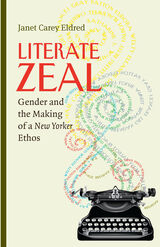 Literate Zeal: Gender and the Making of a New Yorker Ethos
Janet Carey Eldred
University of Pittsburgh Press, 2014
In Literate Zeal, Janet Carey Eldred examines the rise of women magazine editors during the mid-twentieth century and reveals their unheralded role in creating a literary aesthetic for the American public. Between the sheets of popular magazines, editors offered belles-lettres to the masses and, in particular, middle-class women. Magazines became a place to find culture, humor, and intellectual affirmation alongside haute couture.
Eldred mines a variety of literary archives, notably the correspondence of Katharine Sargeant White of the New Yorker, to provide an insider’s view of the publisher-editor-author dynamic. Here, among White’s letters, memos, and markups, we see the deliberate shaping of literature to create a New Yorker ethos. Through her discrete phrasing, authors are coaxed by White to correct or wholly revise their work. Stories or poems by famous writers are rejected for being “dizzying” or “too literate.” With a surgeon’s skill, “disturbing” issues such as sexuality and race are extracted from manuscripts.
Eldred chronicles the work of women (and a few men) editors at the major women’s magazines of the day. Ladies’ Home Journal, Mademoiselle, Vogue, and others enacted an editorial style similar to that of the New Yorker by offering literature, values, and culture to an educated and aspiring middle class. Publishers effectively convinced readers that middlebrow stories (and by association their audience) had much loftier pursuits. And they were right. These publications created and sustained a mass literacy never before seen in American publishing.
 The Literati Purges: Political Conflict in Early Yi Korea
Edward W. Wagner
Harvard University Press, 1974 The Literati Purges explores the phenomenon of the political purge in early Yi Dynasty Korea. Four such upheavals occurring within a fifty-year span are known in Korean historiography by the term sahwa, literati purge; the first three of these events, occurring in 1498, 1504, and 1519, are the subject of this study.
The author's original aim was to narrate in full detail the background, development, and consequences of each purge, focusing on those issues and events that best reveal the political institutions and processes as they actually operated in early Yi Korea. But as the study proceeded it became clear that the story of the literati purges was, above all, the history of the development of the remonstrance or censorial function in the Yi state and the conflict among the administrative organs of the government that accompanied this development. In short, although The Literati Purges focuses on events, it is at the same time an institutional study.
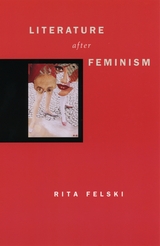 Literature after Feminism
Rita Felski
University of Chicago Press, 2003 Recent commentators have portrayed feminist critics as grim-faced ideologues who are destroying the study of literature. Feminists, they claim, reduce art to politics and are hostile to any form of aesthetic pleasure. Literature after Feminism is the first work to comprehensively rebut such caricatures, while also offering a clear-eyed assessment of the relative merits of various feminist approaches to literature.
Spelling out her main arguments clearly and succinctly, Rita Felski explains how feminism has changed the ways people read and think about literature. She organizes her book around four key questions: Do women and men read differently? How have feminist critics imagined the female author? What does plot have to do with gender? And what do feminists have to say about the relationship between literary and political value? Interweaving incisive commentary with literary examples, Felski advocates a double critical vision that can do justice to the social and political meanings of literature without dismissing or scanting the aesthetic.
 Literature after Feminism
Rita Felski
University of Chicago Press, 2003 This is an auto-narrated audiobook version of this book.
Recent commentators have portrayed feminist critics as grim-faced ideologues who are destroying the study of literature. Feminists, they claim, reduce art to politics and are hostile to any form of aesthetic pleasure. Literature after Feminism is the first work to comprehensively rebut such caricatures, while also offering a clear-eyed assessment of the relative merits of various feminist approaches to literature.
Spelling out her main arguments clearly and succinctly, Rita Felski explains how feminism has changed the ways people read and think about literature. She organizes her book around four key questions: Do women and men read differently? How have feminist critics imagined the female author? What does plot have to do with gender? And what do feminists have to say about the relationship between literary and political value? Interweaving incisive commentary with literary examples, Felski advocates a double critical vision that can do justice to the social and political meanings of literature without dismissing or scanting the aesthetic.
 Literature Among Discourses: The Spanish Golden Age
Wlad Godzich and Nicholas Spadaccini, EditorsIntroduction by Wlad Godzich and Nicholas Spadaccini
University of Minnesota Press, 1986
Literature Among Discourses was first published in 1986. Minnesota Archive Editions uses digital technology to make long-unavailable books once again accessible, and are published unaltered from the original University of Minnesota Press editions.
Literature in the High Middle Ages referred to anything written. Those who institutionalized the study of literature in the eighteenth and nineteenth centuries ignored this medieval meaning, and literary history, especially in the hands of teachers, became what Wlad Godzich and Nicholas Spadaccini call a peregrination from one masterpiece to another. In Spanish literature, a cluster of such masterpieces came to be identified quite early, constituting a siglo de oro,a Golden Age. These outstanding works of the sixteenth and seventeenth centuries became a paradigm of achievement for the German romantics who formulated the project of literary history; for this reason, the authors of Literature among Discourses have chosen to begin their own exploratory voyage with the Spanish Golden Age.
Their intent is not simply to complete the historical record by studying "popular" texts alongside the canonical works, nor is it to establish these texts as a treasure trove of raw materials awaiting entry into and transformation by the masterpiece. They ask, rather, why the masterpiece came to occupy its place—how specific texts (or classes of texts) came to be differentiated from other discursive entities and labeled "literature." Taken together, their essays reveal an era in which literature is never a given, but is instead constantly being forged in a manner as complex as the social dynamic itself.
Contributors include: the editors, José Antonio Maravall, Michael Nerlich, Ronald Sousa, Constance Sullivan, Jenaro Talens, José Luís Canet, and Javier Herrero. Wlad Godzich is director of the Center for Humanistic Studies, and Nicholas Spadaccini, professor of Spanish and Portuguese, at the University of Minnesota.
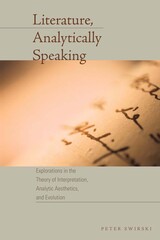 Literature, Analytically Speaking: Explorations in the Theory of Interpretation, Analytic Aesthetics, and Evolution
By Peter Swirski
University of Texas Press, 2010 In a new approach to interdisciplinary literary theory, Literature, Analytically Speaking integrates literary studies with analytic aesthetics, girded by neo-Darwinian evolution. Scrutinizing narrative fiction through a lens provided by analytic philosophy, revered literary theorist Peter Swirski puts new life into literary theory while fashioning a set of practical guidelines for critics in the interpretive trenches. Dismissing critical inquirers who deny intention its key role in the study of literary reception, Swirski extends the defense of intentionality to art and to human behavior in general. In the process, Swirski takes stock of the recent work in evolutionary theory, arguing that the analysis of narrative truth may be grounded in the neo-Darwinian paradigm which forms the empirical backbone behind his analytic approach. Literature, Analytically Speaking provides a series of precepts designed to capture the ways in which we do interpret (and ought to interpret) works of literature. Reflecting a resounding shift from the poststructuralist paradigm, Swirski's lively and colorful presentation, backed up by a dazzling variety of examples and case studies, reconceptualizes the aesthetics of literature and literary studies.
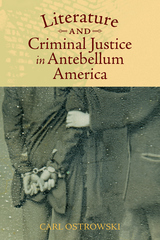 Literature and Criminal Justice in Antebellum America
Carl Ostrowski
University of Massachusetts Press, 2016 The United States set about defining and reforming its criminal justice institutions during the antebellum years, just as an innovative, expanding print culture afforded authors and publishers unprecedented opportunities to reflect on these important social developments. Carl Ostrowski traces the impact of these related historical processes on American literature, identifying a set of culturally resonant narratives that emerged from criminal justice-related discourse to shape the period's national literary expression.
Drawing on an eclectic range of sources including newspaper arrest reports, prison reform periodicals, popular literary magazines, transatlantic travel narratives, popular crime novels, anthologies of prison poetry, and the memoirs of prison chaplains, Ostrowski analyzes how authors as canonical as Nathaniel Hawthorne and as obscure as counterfeiter/poet/prison inmate Christian Meadows adapted, manipulated, or rejected prevailing narratives about criminality to serve their artistic and rhetorical ends. These narratives led to the creation of new literary subgenres while also ushering in psychological interiority as an important criterion by which serious fiction was judged. Ostrowski joins and extends recent scholarly conversations on subjects including African American civic agency, literary sentimentalism, outsider authorship, and the racial politics of antebellum prison reform.
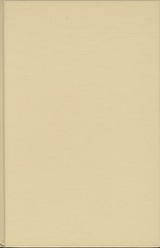 Literature and Human Equality
Stewart Justman
Northwestern University Press, 2006 When Achilles dons his armor, gods and readers alike know the outcome, as does the hero himself. But when the commoner becomes the hero, when, as Dr. Johnson remarked in 1750, the heroes of modern fiction are "leveled with the rest of the world"--now that's a different story. In this ambitious work, Stewart Justman ranges across Western literature from the Iliad and the Odyssey through Cervantes and Shakespeare to Dickens, Tolstoy, and Dostoevsky to show how such a leveling not only changed the appearance of literature, but made possible new ways of constructing a tale.
Only when influenced by the principle of equality does a narrative deliberately deny readers knowledge beyond those they are reading about--privileged knowledge. This book argues that such a turn, in the hands of masters of the novel, changed narrative itself into an exploration of the limits of knowledge; that the portrayal of persons unknown to history transformed the novel into an investigation of the unknown. If the novel is the literary form of limited knowledge, the fullest expression of that form is found in the great fictional experiments of the nineteenth century, the age when the social question--the question of human equality--broke upon the world. Justman looks into some of those experiments for their own sake, but also for the light they cast on the nature and history of the novel. Focusing on Great Expectations, War and Peace, The Death of Ivan Ilych, and The Brothers Karamazov, Justman explores what happens when we, as readers, are denied knowledge not only for the sake of suspense, but because ignorance belongs to what we have in common, the human condition.
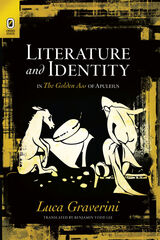 Literature and Identity in The Golden Ass of Apuleius
Luca Graverini
Ohio State University Press, 2012 Literature and Identity in The Golden Ass of Apuleius is the first English translation of a work published in 2007 as Le Metamorfosi di Apuleio: Letteratura e identità, by Luca Graverini. The second-century CE novel The Golden Ass, or Metamorphoses, has proven to be both captivating and highly entertaining to the modern reader, but the text also presents the critic with a vast array of interpretive possibilities. In fact, there is little consensus among scholars on the fundamental significance of Apuleius’ novel: is it simply a form of narrative entertainment, or does it represent some sort of religious or philosophical propaganda? Can it be interpreted as a satire of fatuous belief in otherworldly powers, or is it an utterly aporetic text? Graverini begins by setting The Golden Ass in its ancient literary context. Apuleius’ playful defiance of generic conventions represents a substantial literary innovation, but he is also taking part in a tradition of narrative and satirical literature that typically featured experimentation with genre. The interplay of generic elements found in The Golden Ass reflects the complexity of the author’s cultural identity: Apuleius was a Roman North African who had traveled widely throughout the Mediterranean and enjoyed an extensive education in both Greek and Latin. Graverini concludes with a study of the complex interaction of these three dimensions of Apuleius’ identity (African, Roman, and Greek), and investigates what the narrative can tell us about the culture of its readership. These cultural interactions affirm that The Golden Ass aims to delight its readers as well as to exhort them to religion and philosophy. Ben Lee’s superb new translation will make Graverini's groundbreaking study available to a much wider scholarly readership.
 Literature and Liminality: Festive Readings in the Hispanic Tradition
Gustavo Pérez Firmat
Duke University Press, 1986 Recent literary studies and related disciplines have given much attention to phenomena that seem to occupy more or less permanently eccentric positions in our experience.
Gustavo Perez Firmat examines three of these marginal or liminal phenomena—paying particular attention to the distinction between "center" and "periphery"—as they appear in Hispanic literature. Carnival (the traditional festival in which normal behavior is overturned), choteo (an insulting form of humor), and disease are three liminal entities discussed. Less an attempt to frame a general theory of such "liminalities" than an effort to demonstrate the interpretive power of the liminality concept, this work challenges conventional boundaries of critical sense and offers new insights into a variety of questions, among them the notion of convertability in psychoanalysis and the relation of New World culture to its European forebears.
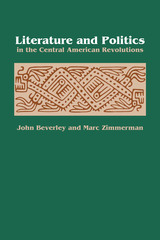 Literature and Politics in the Central American Revolutions
By John Beverley and Marc Zimmerman
University of Texas Press, 1990 “This book began in what seemed like a counterfactual intuition . . . that what had been happening in Nicaraguan poetry was essential to the victory of the Nicaraguan Revolution,” write John Beverley and Marc Zimmerman. “In our own postmodern North American culture, we are long past thinking of literature as mattering much at all in the ‘real’ world, so how could this be?” This study sets out to answer that question by showing how literature has been an agent of the revolutionary process in Nicaragua, El Salvador, and Guatemala. The book begins by discussing theory about the relationship between literature, ideology, and politics, and charts the development of a regional system of political poetry beginning in the late nineteenth century and culminating in late twentieth-century writers. In this context, Ernesto Cardenal of Nicaragua, Roque Dalton of El Salvador, and Otto René Castillo of Guatemala are among the poets who receive detailed attention.
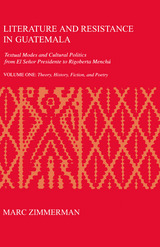 Literature and Resistance in Guatemala: Textual Modes and Cultural Politics from El Señor Presidente to Rigoberta Menchú
Marc Zimmerman
Ohio University Press, 1994 What circumstances lead writers in a poor, multi-ethnic and largely illiterate country to produce a literature that both expresses and affects opposition to the regime? Who are these writers? This study examines these and other questions about the literature of resistance in Guatemala, from the days of Estrada Cabrera up to the events of May and June of 1993. Zimmerman provides the cultural context for the various modes of literary production and analysis, and identifies the currents of opposition in the nation’s fiction, poetry, and testimonial writing. He details the cultural politics involving Guatemalan writers and their organizations during their years of Cerezo and Serrano-Elías, paying particular attention to the role of women and indigenous groups, Rigoberta Menchú among them. These two volumes are companion texts to Guatemala: Voices from the Silence, an “epic-collage” of writings compiled by Zimmerman and Raúl Rojas.
Literature and Revolution
Leon Trotsky
University of Michigan Press, 1960 Literature and Revolution by Leon Trotsky explores the relationship between literature and revolutionary politics. The book critiques various literary trends and schools from a Marxist perspective. Trotsky argues that economic stability and comfort are necessary for the development of socialist art. He emphasizes that new culture must emerge from the peasantry and workers, breaking from old bourgeois traditions. Analyzing figures like Kliuev, Yessenin, and the Serapion Fraternity, Trotsky critiques formalist poetry and advocates for art that reflects the proletariat's struggles. He calls for a new, optimistic, and collectivist art, rooted in the revolutionary process. Overall, Trotsky posits that creating a socialist art is vital for the success of the revolutionary epoch and the development of a culture beyond class distinctions.
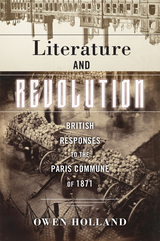 Literature and Revolution: British Responses to the Paris Commune of 1871
Owen Holland
Rutgers University Press, 2022 Between March and May 1871, the Parisian Communards fought for a revolutionary alternative to the status quo grounded in a vision of internationalism, radical democracy and economic justice for the working masses that cut across national borders. The eventual defeat and bloody suppression of the Commune resonated far beyond Paris. In Britain, the Commune provoked widespread and fierce condemnation, while its defenders constituted a small, but vocal, minority. The Commune evoked long-standing fears about the continental ‘spectre’ of revolution, not least because the Communards’ seizure of power represented an embryonic alternative to the bourgeois social order.
This book examines how a heterogeneous group of authors in Britain responded to the Commune. In doing so, it provides the first full-length critical study of the reception and representation of the Commune in Britain during the closing decades of the nineteenth century, showing how discussions of the Commune functioned as a screen to project hope and fear, serving as a warning for some and an example to others. Writers considered in the book include John Ruskin, Edward Bulwer-Lytton, Eliza Lynn Linton, Mary Elizabeth Braddon, Anne Thackeray Ritchie, Margaret Oliphant, George Gissing, Henry James, William Morris, Alfred Austin and H.G. Wells. As the book shows, many, but not all, of these writers responded to the Commune with literary strategies that sought to stabilize bourgeois subjectivity in the wake of the traumatic shock of a revolutionary event. The book extends critical understanding of the Commune’s cultural afterlives and explores the relationship between literature and revolution.
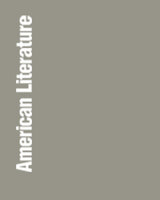 Literature and Science: Cultural Forms, Conceptual Exchanges, Volume 74
Wai Chee Dimock and Priscilla Wald, eds.
Duke University Press The goal of this special issue of American Literature is to encourage scholars in both the sciences and the humanities to estrange themselves from their regular ways of thinking. Committed to understanding what each discipline has to teach the other, the contributors explore the changes in topics, approaches, and methodologies in the sciences, technology and the humanities that surface when scholars take seriously the mandate to consider the basic assumptions of each field from the other point of view. The essays address the mutual impact of literature and science through a range of issues: “geek novels” as a subgenre of literature about science, the relationship of narrative form to risk analysis and ecological disaster, the impact of realism and contemporary developments in neurology and brain biology, and the use of technology in the humanities. The essays also examine how the humanities explore scientific issues such as in vitro fertilization and human existence, cloning and molecular biology, and the concept of time. Contributors. Jay Clayton, Wai Chee Dimock, N. Katherine Hayles, Ursula Heise, Randall Knoper, Martha Nell Smith, Stephanie Turner, Priscilla Wald, Robyn Wiegman
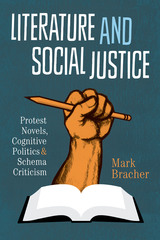 Literature and Social Justice: Protest Novels, Cognitive Politics, and Schema Criticism
By Mark Bracher
University of Texas Press, 2013 Can reading social protest novels actually produce a more just world? Literature and Social Justice offers a scientifically informed, evidence-based affirmative answer to that crucial question, arguing that literature has the potential—albeit largely unrealized—to produce lasting, socially transformative psychological changes in readers. Moving beyond traditional social criticism in its various forms, including feminist, gender, queer, and postcolonialist approaches, Mark Bracher uses new knowledge concerning the cognitive structures and processes that constitute the psychological roots of social injustice to develop a detailed, systematic critical strategy that he calls “schema criticism,” which can be applied to literature and other discourses to maximize and extend their potential for promoting social justice. Bracher draws on studies in social cognition, social neuroscience, evolutionary psychology, political psychology, and psychoanalysis to uncover the root cognitive structures that cause misunderstandings among people and give rise to social injustice. Using the novels The Jungle, The Grapes of Wrath, and Native Son, he then demonstrates how schema criticism can correct these faulty cognitive structures and enable readers to develop more accurate and empathetic views of those they deem “Other,” as well as become more aware of their own cognitive processes. Calling the book “insightful, erudite, and humane,” Cognitive Approaches to Literature and Culture Series coeditor Patrick Colm Hogan says, “This inspiring book should be welcomed by literary critics, political activists, and anyone who cares about social justice.”
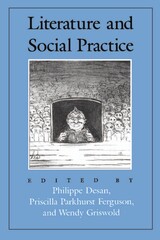 Literature and Social Practice
Edited by Philippe Desan, Priscilla Parkhurst Ferguson, and Wendy Griswold
University of Chicago Press, 1989 "The sociology of literature, in the first of many paradoxes, elicits negations before assertions," write the editors of this volume. "It is not an established field or academic discipline. . . . Yet none of these limitations affect the vitality and rigor of the larger enterprise."
Convinced that literature and society are essentially related to each other, the contributors to this collection attempt to define the various sociological practices of literature and to give expression to this enterprise and the commitments of its partisans. In various ways, the essays assembled here seek to integrate text, institution, and individual (both author and critic) as necessary parts of the analysis of literature. Diverse, sometimes contradictory approaches to literature (Marxism, publishing history, new historicism, and others) are utilized as the contributors explore such topics as text, author-function, and appropriation; the reality of representation; the sociology of exchange; the uses of "serious" fiction; poetry and politics; publishing history; and the literary field.
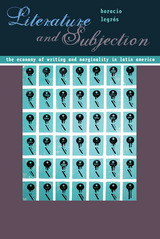 Literature and Subjection: The Economy of Writing and Marginality in Latin America
Horacio Legras
University of Pittsburgh Press, 2008 Through theoretical, philosophical, cultural, political, and historical analysis, Horacio Legras views the myriad factors that have both formed and stifled the integration of peripheral experiences into Latin American literature. Despite these barriers, Legras reveals a handful of contemporary authors who have attempted in earnest to present marginalized voices to the Western world. His deep and insightful analysis of key works by novelists Juan José Saer (The Witness), Nellie Campobello (Cartucho), Roa Bastos (Son of Man), and Jose María Arguedas (The Fox from Up Above and the Fox from Down Below), among others, provides a theoretical basis for understanding the plight of the author, the peripheral voice and the confines of the literary medium. What emerges is an intricate discussion of the clash and subjugation of cultures and the tragedy of a lost worldview.
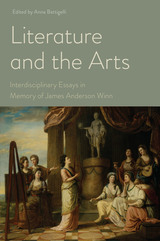 Literature and the Arts: Interdisciplinary Essays in Memory of James Anderson Winn
Anna Battigelli
University of Delaware Press, 2024 The ten essays in Literature and the Arts explore the intermedial plenitude of eighteenth-century English culture, honoring the memory of James Anderson Winn, whose work demonstrated how seeing that interplay of the arts and literature was essential to a full understanding of Restoration and eighteenth-century English culture. Scenery, machinery, music, dance, and texts transformed one another, both enriching and complicating generic distinctions. Artists were alive to the power of the arts to reflect and shape reality, and their audience was quick to turn to the arts as performative pleasures and critical lenses through which to understand a changing world. This collection's eminent authors discuss estate design, musicalized theater, the visual spectacle of musical performance, stage machinery and set designs, the social uses of painting and singing, drama’s reflection of a transformed military infrastructure, and the arts of memory and of laughter.
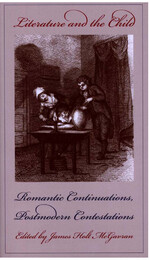 Literature and the Child: Romantic Continuations, Postmodern Contestations
James Holt Mcgavran
University of Iowa Press, 1999 The Romantic myth of childhood as a transhistorical holy time of innocence and spirituality, uncorrupted by the adult world, has been subjected in recent years to increasingly serious interrogation. Was there ever really a time when mythic ideals were simple, pure, and uncomplicated? The contributors to this book contend—although in widely differing ways and not always approvingly—that our culture is indeed still pervaded, in this postmodern moment of the very late twentieth century, by the Romantic conception of childhood which first emerged two hundred years ago. In the wake of the French Revolution and the Industrial Revolution, western Europe experienced another fin de siècle characterized by overwhelming material and institutional change and instability. By historicizing the specific political, social, and economic conflicts at work within the notion of Romantic childhood, the essayists in Literature and the Child show us how little these forces have changed over time and how enriching and empowering they can still be for children and their parents. In the first section, “Romanticism Continued and Contested,” Alan Richardson and Mitzi Myers question the origins and ends of Romantic childhood. In “Romantic Ironies, Postmodern Texts,” Dieter Petzold, Richard Flynn, and James McGavran argue that postmodern texts for both children and adults perpetuate the Romantic complexities of childhood. Next, in “The Commerce of Children's Books,” Anne Lundin and Paula Connolly study the production and marketing of children's classics. Finally, in “Romantic Ideas in Cultural Confrontations,” William Scheick and Teya Rosenberg investigate interactions of Romantic myths with those of other cultural systems.
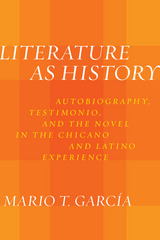 Literature as History: Autobiography, Testimonio, and the Novel in the Chicano and Latino Experience
Mario T. García
University of Arizona Press, 2016 Historical documents—and, for that matter, historical sources—exist in many forms. The traditional archival sources such as official documents, newspapers, correspondence, and diaries can be supplemented by personal archives, oral histories, and even works of fiction in order for historians to illuminate the past.
Literature as History offers a critical new path for Chicano and Latino history. Historian Mario T. García analyzes prominent works of Chicano fiction, nonfiction, and autobiographical literature to explore how they can sometimes reveal even more about ordinary people’s lives. García argues that this approach can yield personal insights into historical events that more formal documents omit, lending insights into such diverse issues as gender identity, multiculturalism, sexuality, and the concerns of the working class.
In a stimulating and imaginative look at the intersection of history and literature, García discusses the meaning and intent of narratives. Literature as History represents a unique way to rethink history. García, a leader in the field of Chicano history and one of the foremost historians of his generation, explores how Chicano historians can use Chicano and Latino literature as important historical sources. Autobiography, testimonio, and fiction are the genres the author researches to obtain new and insightful perspectives on Chicano history at the personal and grassroots levels. Breaking the boundaries between history and literature, García provides a thought-provoking discussion of what constitutes a historical source.
Literature as Intervention: Challenging Normativity in the Writing of Elisabeth Reichert, Charlotte Roche and Elfriede Jelinek
Cornelia Wech
University of London Press, 2020 This study examines how the literary works of Elisabeth Reichart, Charlotte Roche, and Elfriede Jelinek challenge normativity both in their engagement with gender and sexuality and with aesthetic choices. The comparative analysis of texts published over a twenty year-period provides insights into the socio-political and cultural dynamics at the time of publication, and reveals the continuing relevance of feminist authorial voices to the present day, challenging the stable, normative understanding of feminism and feminist writing itself, and showing how literature can function as a form of intervention that provides a reflective space for readers to question norms in their own lives and to take the initiative to change these norms.
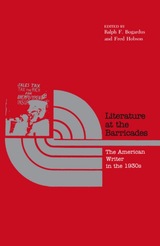 Literature at the Barricades: The American Writer in the 1930s
Edited by Ralph F. Bogardus and Fred Hobson
University of Alabama Press, 1982 This collection captures the sense—at times the ordeal—of the 1930s literary experience in America. Fourteen essayists deal with the experience of being a writer in a time of overwhelming economic depression and political ferment, and thereby illuminate the social, political, intellectual, and aesthetic problems and pressures that characterized the experience of American writers and influenced their works. The essays, as a group, constitute a reevaluation of the American literature of the 1930s. At the same time they support and reinforce certain assumptions about the decade of the Great Depression—that it was grim, desperate, a time when dreams died and poverty became something other than genteel—they challenge other assumptions, chief among them in the notion that 1930s literature was uniform in content, drab in style, anti-formalist, and always political or sociological in nature. They leave us with an impression that there was variety in American writing of the 1930s and a convincing argument that the decade was not a retreat from the modernism of the 1920s. Rather it was a transitional period in which literary modernism was very much an issue and a force that bore imaginative fruit.
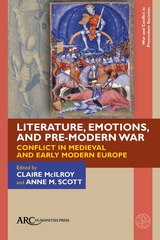 Literature, Emotions, and Pre-Modern War: Conflict in Medieval and Early Modern Europe
Claire McIlroy
Arc Humanities Press, 2021 This collection assembles work by some of the foremost English-speaking scholars of pre-modern thought and culture and is the fruit of the Australian Research Council's ground-breaking Centre of Excellence for the History of Emotion. The impact of war, a human activity that is both public and politically charged, is examined as it affects private human lives caught up in public and political situations. The essays, many of them influenced by the burgeoning field of study in the history of emotions, examine the often unconsidered effects of war—on the individual and on the commune—as revealed in the study of well-known texts such as Beowulf, Piers Plowman, Malory’s Le Morte Darthur, and Chaucer’s Troilus and Criseyde, as well as other lesser-known works that mirror the concerns of the society in which they were conceived. These latter range from the twelfth-century chansons of the Crusades, through the fifteenth-century French and English political works of Alain Chartier, to the twentieth-century anti-war satirical films of Mario Monicelli.
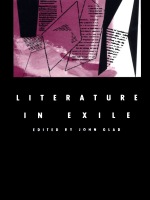 Literature in Exile
John Glad, ed.
Duke University Press, 1990 In December 1987 a group of published novelists, poets, and journalists met in Vienna to participate in the Wheatland Conference on Literature. The writers presented papers addressing their common experience—that of being exiled. Each explored different facets of the condition of exile, providing answers to questions such as: What do exiled writers have in common? What is the exile’s obligation to colleagues and readers in the country of origin? Is the effect of changing languages one of enrichment or impoverishment? How does the new society treat the emigre? Following each essay is a peer discussion of the topic addressed. The volume includes writers whose origins lie in Central Europe, South Africa, Israel, Cuba, Chile, Somalia, and Turkey. Through their testimony of the creative process in exile, we gain insight into the forces which affect the creative process as a whole. Contributors. William Gass, Yury Miloslavsky, Jan Vladislav, Jiri Grusa, Guillermo Cabrera Infante, Horst Bienek, Edward Limonov, Nedim Gursel, Nuruddin Farah, Jaroslav Vejvoda, Anton Shammas, Joseph Brodsky, Wojciech Karpinski, Thomas Venclova, Yuri Druzhnikov
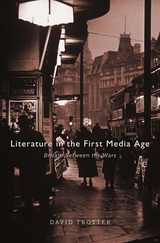 Literature in the First Media Age: Britain between the Wars
David Trotter
Harvard University Press, 2013 The period between the World Wars was one of the richest and most inventive in the long history of British literature. Interwar literature, David Trotter argues, stood apart by virtue of the sheer intelligence of the enquiries it undertook into the technological mediation of experience. After around 1925, literary works began to portray communication by telephone, television, radio, and sound cinema—and to examine the sorts of behavior made possible for the first time by virtual interaction. And they filled up, too, with the look, sound, smell, taste, and feel of the new synthetic and semi-synthetic materials that were reshaping everyday modern life.
New media and new materials gave writers a fresh opportunity to reimagine both how lives might be lived and how literature might be written. Today, Trotter observes, such material and immaterial mediations have become even more decisive. Communications technology is an attitude before it is a machine or a set of codes. It is an idea about the prosthetic enhancement of our capacity to communicate. The writers who first woke up to this fact were not postwar, postmodern, or post-anything else: some of the best of them lived and wrote in the British Isles in the period between the World Wars. In defining what they achieved, this book creates a new literary canon of works distinguished formally and thematically by their alertness to the implications of new media and new materials.
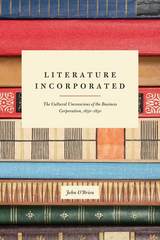 Literature Incorporated: The Cultural Unconscious of the Business Corporation, 1650-1850
John O'Brien
University of Chicago Press, 2015 Long before Citizens United and modern debates over corporations as people, such organizations already stood between the public and private as both vehicles for commerce and imaginative constructs based on groups of individuals. In this book, John O’Brien explores how this relationship played out in economics and literature, two fields that gained prominence in the same era.
Examining British and American essays, poems, novels, and stories from the seventeenth through the nineteenth centuries, O’Brien pursues the idea of incorporation as a trope discernible in a wide range of texts. Key authors include John Locke, Eliza Haywood, Harriet Martineau, and Edgar Allan Poe, and each chapter is oriented around a type of corporation reflected in their works, such as insurance companies or banks. In exploring issues such as whether sentimental interest is the same as economic interest, these works bear witness to capitalism’s effect on history and human labor, desire, and memory. This period’s imaginative writing, O’Brien argues, is where the unconscious of that process left its mark. By revealing the intricate ties between literary models and economic concepts, Literature Incorporated shows us how the business corporation has shaped our understanding of our social world and ourselves.
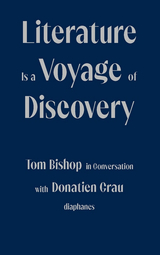 Literature Is a Voyage of Discovery: Tom Bishop in Conversation with Donatien Grau
Tom Bishop and Donatien Grau
Diaphanes, 2021 A blend of theory and stories from an extraordinary life by a leading cultural figure.
Tom Bishop has, for over sixty years, helped shape the literary, philosophical, cultural, artistic, and political conversation between Paris and New York. As professor and director of the Center for French Civilization and Culture at New York University, he made the Washington Square institution one of the great bridges between French innovation and a New York scene in full transformation. Bishop was close to Beckett, championed Robbe-Grillet in the United States, befriended Marguerite Duras and Hélène Cixous, and organized historic public encounters—such as the one between James Baldwin and Toni Morrison. He was also a scholar, a recognized specialist in the avant-garde, notably the Nouveau Roman and the Nouveau Théâtre.
In 2012, Bishop invited Donatien Grau to give a talk at NYU. This invitation led to conversations—many of which are presented in this book—and a friendship. Literature Is a Voyage of Discovery gathers their dialogues, retracing Bishop’s career, his own history, his departure from Vienna, his studies, his meetings, his choices, his conception of literature and life, his relationship to the political and economic world, and the way he helped define the profession of “curator” as it is practiced today, offering a thought-provoking look into one of the leading minds of our time.
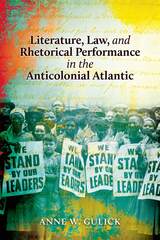 Literature, Law, and Rhetorical Performance in the Anticolonial Atlantic
Anne W. Gulick
Ohio State University Press, 2016 The era of national liberation and decolonization may have come and gone, but postcolonialism remains a largely elusive ideal in the early twenty-first century. In Literature, Law, and Rhetorical Performance in the Anticolonial Atlantic, Anne W. Gulick uncovers a dynamic literary history of African and Caribbean critical engagements with First World law. This transatlantic archive attests to the continuing vitality of anticolonialism as a model for intellectual inquiry and political performance. Gulick argues that experimentation with declarative forms is a vital rhetorical strategy in the anticolonial Atlantic—one through which writers have asked: Who gets to “write” the law, and under what circumstances?
Responses to this question take shape across the black Atlantic from Haiti to South Africa, in texts ranging from Haiti’s Declaration of Independence and work by C. L. R. James to South Africa’s Freedom Charter, Aimé Césaire’s poem Notebook of a Return to the Native Land, and Ngugi wa Thiong’o’s A Grain of Wheat. These texts constitute a robust transatlantic tradition of challenging colonial and imperial authority through rhetorical performance. Drawing on the cosmopolitan aspirations and emancipatory energies of the political declaration, this tradition aims to radically reinvent the possibilities for law and political belonging in the postcolonial future.
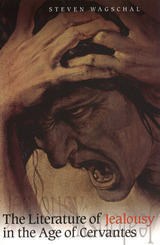 The Literature of Jealousy in the Age of Cervantes
Steven Wagschal
University of Missouri Press, 2007
Frequent and complex representations of jealousy in early modern Spanish literature offer symbolically rich and often contradictory images. Steven Wagschal examines these occurrences by illuminating the theme of jealousy in the plays of Lope de Vega, the prose of Miguel de Cervantes, and the complex poetry of Luis de Góngora. Noting the prevalence of this emotion in their work, he reveals what jealousy offered these writers at a time when Spain was beginning its long decline.
Wagschal examines jealousy not only in canonical texts—The Jealous Old Man from Extremadura, The Commanders of Cordoba—but also in less-studied writings such as Lope de Vega’s Jealous Arminda and In Love but Discreet and Góngora’s “What of the Tall Envious Mountains.” Through close analysis of numerous works, read in relation to one another, he demonstrates how the rhetorical elaboration of jealousy is linked to the ideological makeup of the texts—complicating issues of race, class, gender, morality, epistemology, and aesthetics—and proposes that the theme of jealousy offered a means for working through political and cultural problems involving power.
Grounding his study in the work of thinkers ranging from Vives and Descartes to Freud and DeSousa, Wagschal also draws on classical antiquity to unravel myths that impinge upon the texts he considers. By showing that the greatest hyperbole of each of these writers is a representation of jealousy, he calls for a reconsideration of an era’s literary giants, arguing not only for a reinterpretation of settled views on Cervantes but also for a reconsideration of Góngora’s role in the development of modern European aesthetics.
With its fresh insights into the interrelationships among literature, art, and society, Wagschal’s study offers background theory for analyzing the emotions in literature and is the first book to treat an emotion in any national literature from the perspective of contemporary philosophy of mind. With its cogent insights into the jealous mind, it raises issues relevant both to the early modern period and to our contemporary world.
 A Literature of Questions: Nonfiction for the Critical Child
Joe Sutliff Sanders
University of Minnesota Press, 2018 Nonfiction books for children—from biographies and historical accounts of communities and events to works on science and social justice—have traditionally been most highly valued by educators and parents for their factual accuracy. This approach, however, misses an opportunity for young readers to participate in the generation and testing of information. In A Literature of Questions, Joe Sutliff Sanders offers an innovative theoretical approach to children’s nonfiction that goes beyond an assessment of a work’s veracity to develop a book’s equivocation as a basis for interpretation. Addressing how such works are either vulnerable or resistant to critical engagement, Sanders pays special attention to the attributes that nonfiction shares with other forms of literature, including voice and character, and those that play a special role in the genre, such as peritexts and photography. The first book-length work to theorize children’s nonfiction as nonfiction from a literary perspective, A Literature of Questions carefully explains how the genre speaks in unique ways to its young readers and how it invites them to the project of understanding. At the same time, it clearly lays out a series of techniques for analysis, which it then applies and nuances through extensive close readings and case studies of books published over the past half century, including recent award-winning books such as Tanya Lee Stone’s Almost Astronauts: Thirteen Women Who Dared to Dream and We Are the Ship: The Story of Negro League Baseball by Kadir Nelson. By looking at a text’s willingness or reluctance to let children interrogate its information and ideological context, Sanders reveals how nonfiction can make young readers part of the project of learning rather than passive recipients of information.
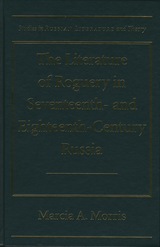 The Literature of Roguery in Seventeenth and Eighteenth Century Russia
Marcia A. Morris
Northwestern University Press, 2000 In the eighteenth century, when the picaresque had been eclipsed by neoclassical and preromantic models in much of Europe, it flourished anew in Russia. Marcia A. Morris's book, a study of this flowering and the antecedents of the picaresque in the seventeenth-century, offers new insight into both the genre and its broad appeal for Russian readers. Morris situates the earlier tales of roguery in the tumultuous social milieu of the waning medieval period and shows how these texts mirror many of the manifestations of subversive behavior in the larger culture. She also shows how eighteenth-century "Europeanized" men of letters, who publicly scorned this earlier literature, actually adapted its popular patterns in their own Western-inspired works. Her book provides fresh readings of several well-known texts and resurrects forgotten eighteenth-century picaresques, revealing their fusion of Western and indigenous aesthetics and their broader cultural underpinnings.
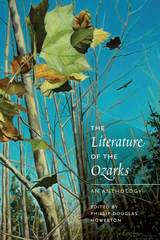 The Literature of the Ozarks: An Anthology
Phillip Douglas Howerton
University of Arkansas Press, 2019 The job of regional literature is twofold: to explore and confront the culture from within, and to help define that culture for outsiders. Taken together, the two centuries of Ozarks literature collected in this ambitious anthology do just that. The fiction, nonfiction, poetry, and drama presented in The Literature of the Ozarks complicate assumptions about backwoods ignorance, debunk the pastoral myth, expand on the meaning of wilderness, and position the Ozarks as a crossroads of human experience with meaningful ties to national literary movements. Among the authors presented here are an Osage priest, an early explorer from New York, a native-born farm wife, African American writers who protested attacks on their communities, a Pulitzer Prize–winning poet, and an art history professor who created a fictional town and a postmodern parody of the region’s stereotypes. The Literature of the Ozarks establishes a canon as nuanced and varied as the region’s writers themselves.
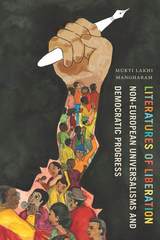 Literatures of Liberation: Non-European Universalisms and Democratic Progress
Mukti Lakhi Mangharam
Ohio State University Press, 2017 The postcolonial spread of democratic ideals such as freedom and equality has taken place all over the world despite the widespread cultural differences that would seem to inhibit such change. In her new book, Literatures of Liberation: Non-European Universalisms and Democratic Progress, Mukti Lakhi Mangharam questions how these “universalisms” came to be and suggests that these elements were not solely the result of Europe-based Enlightenment ideals. Instead, they also arose in context-specific forms throughout the world (particularly in the Global South), relatively independently from Enlightenment concepts. These translatable yet distinct cognitive frameworks, or “contextual universalisms,” as she argues, were central to the spread of modern democratic principles in response to the relentless expansion of capital.
In this way, she posits that these universalisms reconceptualize democratic ideals not as Western imports into precolonial societies but as regional phenomena tied to local relations of power and resistance. In charting these alternative democratic trajectories, Mangharam examines oft-overlooked regional and vernacular literary forms and provides a fresh approach to current theorizations of postcolonial and world literatures.
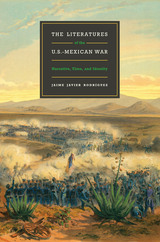 The Literatures of the U.S.-Mexican War: Narrative, Time, and Identity
By Jaime Javier Rodríguez
University of Texas Press, 2010 The literary archive of the U.S.-Mexican War (1846–1848) opens to view the conflicts and relationships across one of the most contested borders in the Americas. Most studies of this literature focus on the war's nineteenth-century moment of national expansion. In The Literatures of the U.S.-Mexican War, Jaime Javier Rodríguez brings the discussion forward to our own moment by charting a new path into the legacies of a military conflict embedded in the cultural cores of both nations. Rodríguez's groundbreaking study moves beyond the terms of Manifest Destiny to ask a fundamental question: How do the war's literary expressions shape contemporary tensions and exchanges among Anglo Americans, Mexicans, and Mexican Americans. By probing the war's traumas, anxieties, and consequences with a fresh attention to narrative, Rodríguez shows us the relevance of the U.S.-Mexican War to our own era of demographic and cultural change. Reading across dime novels, frontline battle accounts, Mexican American writings and a wide range of other popular discourse about the war, Rodríguez reveals how historical awareness itself lies at the center of contemporary cultural fears of a Mexican "invasion," and how the displacements caused by the war set key terms for the ways Mexican Americans in subsequent generations would come to understand their own identities. Further, this is also the first major comparative study that analyzes key Mexican war texts and their impact on Mexico's national identity.
Lithic Analysis and Cultural Inference: A Paleo-Indian Case
Edwin N. Wilmsen
University of Arizona Press, 1970 The Anthropological Papers of the University of Arizona is a peer-reviewed monograph series sponsored by the School of Anthropology. Established in 1959, the series publishes archaeological and ethnographic papers that use contemporary method and theory to investigate problems of anthropological importance in the southwestern United States, Mexico, and related areas
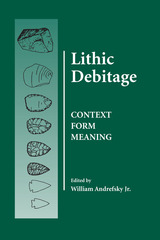 Lithic Debitage
William Andrefsky
University of Utah Press, 2003 Debitage, the by-product flakes and chips from stone tool production, is the most abundant artifact type in prehistoric archaeological sites. For much of the period in which archaeology has employed scientific methodology, debitage has been discarded or ignored as debris. Now archaeologists have begun to recognize its potential to provide information about the kinds of tools produced and the characteristics of the technology being employed. Debitage can even provide clues regarding human organizational systems such as settlement mobility and site functions. This volume brings together some of the most recent research on debitage analysis and interpretation. It presents stone tool production experiments and offers detailed archaeological investigations for interpreting variability at the individual and collective levels. Although there are a number of volumes that focus on general analysis of lithic artifacts, this is the first volume to address debitage and should be of use to a wide range of archaeological researchers.
The Lithic Industries of the Illinois Valley in the Early and Middle Woodland Period
Anta Montet-White
University of Michigan Press, 1968 Anta Montet-White analyzes chipped stone tools from more than 30 Woodland and Hopewell sites in the Illinois Valley, including Steuben, Weaver, Havana, Klunk, and Snyders. Contains more than 65 drawings and photographs of various tools, including preforms, projectile points, celts, and hoes.
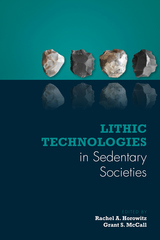 Lithic Technologies in Sedentary Societies
Rachel A. Horowitz
University Press of Colorado, 2019 Lithic Technologies in SedentarySocieties examines lithic technology from ancient societies in Mesoamerica, the Near East, South Asia, and North America, showcasing the important contributions in-depth lithic analysis can make to the study of sedentary societies around the world. Using cutting-edge analytical techniques these case studies address difficult anthropological questions concerning economic, social, and political issues, as well as global trends in lithic production.
Lithic analysis focused on sedentary societies, especially in places like Mesoamerica, has previously been neglected mostly because of the high frequency of informal tools, but such bias limits the ways in which both lithic production and economic organization are investigated. Bringing the importance of studying such technologies to the fore and emphasizing the vital anthropological questions that lithics can answer, Lithic Technologies in Sedentary Societies is a valuable resource for scholars and students of lithic technology and sedentary, complex societies.
Contributors: Fumi Arakawa, Mary A. Davis, James Enloe, Dan Healan, Francesca Manclossi, Theodore Marks, Jayur Madhusudan Mehta, Jason S. R. Paling, Steve Rosen, John Whittaker
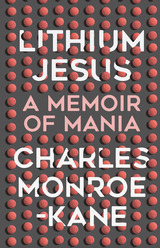 Lithium Jesus: A Memoir of Mania
Charles Monroe-Kane
University of Wisconsin Press, 2020 Charles Monroe-Kane is a natural raconteur, and boy, does he have stories to tell. Born into an eccentric Ohio clan of modern hunter-gatherers, he grew up hearing voices in his head. Over a dizzying two decades, he was many things—teenage faith healer, world traveler, smuggler, liberation theologian, ladder-maker, squatter, halibut hanger, grifter, environmental warrior, and circus manager—all the while wrestling with schizophrenia and self-medication.
From Baby Doc’s Haiti to the Czech Velvet Revolution, and from sex, drugs, and a stabbing to public humiliation by the leader of the free world, Monroe-Kane burns through his twenties and several bridges of youthful idealism before finally saying: enough.
In a memoir that blends engaging charm with unflinching frankness, Monroe-Kane gives his testimony of mental illness, drug abuse, faith, and love. By the end of Lithium Jesus there may be a voice in your head, too, saying “Do more, be more, live more. And fear less.”
Lithium-ion Batteries Enabled by Silicon Anodes
Chunmei Ban
The Institution of Engineering and Technology, 2021 Deploying lithium-ion (Li-ion) batteries depends on cost-effective electrode materials with high energy and power density to facilitate lower weight and volume. Si-based anode materials theoretically offer superior lithium storage capacity. Replacing a graphite anode with high-capacity materials such as silicon will further improve the energy density. Durable, low-cost, and high-energy-density materials are vital to developing plug-in electric vehicles as affordable and convenient as gasoline-powered ones, while reducing carbon emissions.
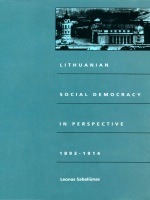 Lithuanian Social Democracy in Perspective, 1893-1914
Leonas Sabaliunas
Duke University Press, 1990 Lithuanian Social Democracy in Perspective is the first book in any Western language on Lithuanian Social Democracy. In this work Leonas Sabaliunas studies the conflict between and convergence of socialism and nationalism in pre-1914 Lithuania. He analyzes the interplay of ideological priorities by observing the operations of Marxist political parties, emphasizing the origins, development, and achievements of the Social Democratic Party of Lithuania.
But Sabaliunas also considers such partners and rivals as the Jewish Bund, the Polish Socialist Party, the Social Democracy of the Kingdom of Poland and Lithuania, and the Russian Social Democratic Labor Party. He focuses on the appearance of socialist parties at the local level, the politics of assertive behavior during the Russian Revolution of 1905–1906, the nature of interparty relations, and efforts to promote party unity. In particular, he investigates the projected relationship between Russia and its subject nationalities—a cardinal concern today as the Baltic peoples attempt to distance themselves from their Russian neighbors.
Sabaliunas clarifies current massive Lithuanian opposition to Moscow and to its version of socialism. He stresses that in Lithuania the socialist movement from the beginning not only sought solutions to social and economic problems but also addressed issues of ethnic and national interest, especially the question of national sovereignty.
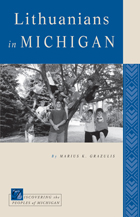 Lithuanians in Michigan
Marius K. Grazulis
Michigan State University Press, 2009 In Lithuanians in Michigan Marius Grazulis recounts the history of an immigrant group that has struggled to maintain its identity. Grazulis estimates that about 20 percent of the 1.6 million Lithuanians who immigrated to the United States arrived on American shores between 1860 and 1918.
While first-wave immigrants stayed mostly on the east coast, by 1920 about one-third of newly immigrated Lithuanians lived in Michigan, working in heavy industry and mining.
With remarkable detail, Grazulis traces the ways these groups have maintained their ethnic identity in Michigan in the face of changing demographics in their neighborhoods and changing interests among their children, along with the challenges posed by newly arriving "modern" Lithuanian immigrants, who did not read the same books, sing the same songs, celebrate the same holidays, or even speak the same language that previous waves of Lithuanian immigrants had preserved in America. Anyone interested in immigrant history will find Lithuanians in Michigan simultaneously familiar, fascinating, and moving.
Litigating Health Rights: Can Courts Bring More Justice to Health?
Alicia Ely Yamin
Harvard University Press, 2011 The last fifteen years have seen a tremendous growth in the number of health rights cases focusing on issues such as access to health services and essential medications. This volume examines the potential of litigation as a strategy to advance the right to health by holding governments accountable for these obligations. It includes case studies from Costa Rica, South Africa, India, Brazil, Argentina and Colombia, as well as chapters that address cross-cutting themes.
The authors analyze what types of services and interventions have been the subject of successful litigation and what remedies have been ordered by courts. Different chapters address the systemic impact of health litigation efforts, taking into account who benefits both directly and indirectly—and what the overall impacts on health equity are.
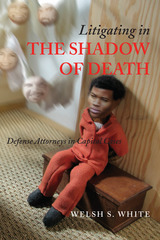 Litigating in the Shadow of Death: Defense Attorneys in Capital Cases
Welsh S. White
University of Michigan Press, 2005
"Anyone who cares about capital punishment should read this compelling, lucid account of the obstacles defense attorneys face and the strategies they adopt."
--John Parry, University of Pittsburgh School of Law
"With its compelling narratives of cases, strategies, and ethical dilemmas, Litigating in the Shadow of Death is difficult to put down. . . . This pathbreaking book encapsulates the experience of the most respected capital defenders in America and shows how they save even the worst of the worst from execution. It also shows how sleeping and otherwise incompetent lawyers bring death sentences to their clients. Litigating in the Shadow of Death explores the lawyers' tasks at every stage of the criminal process--investigation, client interviewing, conferring with victims' families, plea bargaining, trial, appeal, and post-conviction proceedings."
--Albert W. Alschuler, Julius Kreeger Professor of Law and Criminology, University of Chicago
"A unique and profoundly important contribution to the literature on the death penalty. White allows the leading capital defense attorneys to speak in their own voices. His work reveals a new source of arbitrariness in the death system--whether the penalty is imposed turns more on who is your lawyer than on how evil was your deed or your character. Litigating in the Shadow of Death offers concrete guidelines for better lawyering, protection of the innocent, and understanding the artistry of the best capital attorneys. This is vivid, gripping stuff."
--Andrew Taslitz, Professor of Law, Howard University
"A most illuminating book by a splendid writer and an eminent critic of the capital punishment system."
--Yale Kamisar, Professor of Law, University of San Diego
"Welsh White has written another excellent book on the death penalty--this one on how defense attorneys in capital cases successfully prevent the state from executing their clients. Based on original research, Litigating in the Shadow of Death is informative and insightful. This is a book that all serious students of American capital punishment must read."
--Richard Leo, University of California, Irvine
Welsh S. White was Bessie McKee Walthour Endowed Chair and Professor of Law at the University of Pittsburgh.
LITIGATION AS LOBBYING: REPRODUCTIVE HAZARDS & INTEREST AGGREGATION
JULIANNA S. GONEN
Ohio State University Press, 2003 This book is a case study that shows how interest groups use the litigation process to further their policy agendas. The case detailed here revolves around issues of reproductive health. It is a good illustration of the commonly held view among judicial scholars that the judicial process is essentially the same as the political process, that in both cases there is room for influence from a variety of sources.
Little America: Australia, the 51st State
Erik Paul
Pluto Press, 2006 "Australia is one of the US's most staunch supporters: Australia has sent troops to Iraq, and is an ally in the 'war on terror'. Australian domestic policy also follows the US economic model, as state industries and services have been privatised.
Erik Paul dissects the relationship between Australia and the US. He explores how Australia has become a key player in maintaining American dominance in South East Asia, and looks critically at the contrast between the Australian wealth and the comparative poverty of surrounding nations.
Examining the influence of neoconservative imperialism on Australia's economic and military strategies, he draws some startling conclusions about future Australian relationships in East Asia, in particular, its relationship with China."
Little Armageddon: Poems
Gregory Fraser
Northwestern University Press, 2021 It is our everyday explorations—the small explosions within life, family, and “ordinary” survival—that make up Gregory Fraser’s fourth collection of poetry, Little Armageddon. Fraser writes at eye level, detailing the experiences of fatherhood, love, and the quiet of daily life, poised at the brink of abrupt upheaval. These poems are an exercise in precision and reflection. Free verse and prose show readers the life within the landscape. In “My Daughter and the Lizard,” the speaker reflects on grace, meditating on the reptile his child is inspecting: “I scissor-jab three holes through the lid / of a Mason jar and tell her to be gentle, / ‘It’s a living thing,’ I say, ‘not a toy.’”
We are how we live. These poems balance imagination and truth telling with rich verse that brings the reader’s ear closer to the quiet—and how intense it truly is.
The Little Baby Snoogle-Fleejer
Jimmy Carter
University of Arkansas Press, 2014 “Once upon a time there was a little boy named Jeremy who lived with his mother in a small house near the sea. His mother earned a bare living for the two of them by washing clothes for some of the wealthy families in their town. Jeremy loved her very much.” So begins the enchanting fairy tale president Jimmy Carter first spun for his daughter Amy as a child. Originally published in 1995, this favorite family story has been joined with Amy Carter’s vibrant illustrations to bring to life a secret friendship that produces unexpected rewards when tragedy looms in a young boy’s life.
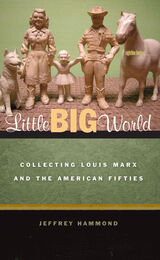 Little Big World: Collecting Louis Marx and the American Fifties
Jeffrey Hammond
University of Iowa Press, 2010 Jeffrey Hammond’s Little Big World: Collecting Louis Marx and the American Fifties is the story of a middle-aged man’s sudden compulsion to collect the toys of his childhood: specifically themed playsets produced by the Louis Marx Toy Company. Hammond never made a conscious decision to become a collector of any kind, so he was surprised when his occasional visits to web sites turned into hours spent gazing at, and then impulsively purchasing, the tiny plastic people and animals in the Civil War set, the Fort Apache set, Roy Rogers Ranch, and Happi-Time Farm—just a few of the dozens of playsets the Marx Company produced. Hammond interweaves childhood memories with reflections on what they reveal about the culture and values of cold war America, offering an extended meditation on toys as powerful catalysts for the imagination of both children and adults. Never sentimentalizing his childhood in an effort to get his old toys back, Hammond exposes the dangers of nostalgia by casting an unsettling light on the culture of the fifties and the era’s lasting impact on those who grew up in it. Writing in a lovably quirky voice, Hammond not only attempts to understand his personal connection to the Marx toys but also examines the psychology of his fellow eBay denizens. In this warm, funny, and contemplative work, the reader encounters an online community of serious adult collectors who, as the author suspects, are driven to obsession by middle-aged nostalgia. When Hammond questions this preoccupation with the past, he comes to realize that his own collecting has prevented him from moving forward. With this insight, he offers an insider’s take on the culture and psychology of collecting.
Little Bit Know Something: Stories in a Language of Anthropology
Robin Ridington
University of Iowa Press, 1990 The Dunne-za, the Beaver Indians of British Columbia, say that people who speak from the authority of their experience "little bit know something." This knowledge, which comes through direct experience, dreaming, and the searing transformation of the vision quest, empowers a person to live in this world with intelligence and understanding. In this sensitive, insightful volume, drawn from over twenty-five years' experience with the Dunne-za Indians, Ridington advocates his unique language of anthology—and in so doing he communicates the themes of cultural and individual knowledge, visionary empowerment, shamanic transformation, and the dialogic basis of ethnographic authority within the evolving context of a humanistic cultural anthropology.
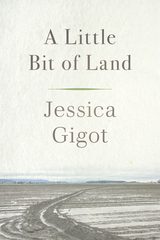 A Little Bit of Land
Jessica Gigot
Oregon State University Press, 2022 From midwifing new lambs to harvesting basil, Jessica Gigot invites the reader into her life on a small farm and the uncommon road that led her there. Fascinated by farming and the burgeoning local food movement, she spent her twenties wandering the Pacific Northwest, interning at small farms and doing graduate work in horticulture, always with an eye towards learning as much as she could about how and why people farm. Despite numerous setbacks and the many challenges of farming, she created a family and farm life defined by resilience and a genuine love of the land. In A Little Bit of Land, Gigot explores the intricacies of small-scale agriculture in the Pacific Northwest and the changing role of women in this male-dominated industry. Gigot alternates between chapters describing joys, routines, and challenges of farm life and chapters reflecting on her formative experiences in agriculture, on farms and in classrooms from Ashland to the Skagit Valley. Throughout, she explores questions of sustainability, economics, health, and food systems.
 A Little Book about the Big Bang
Tony Rothman
Harvard University Press, 2022 A concise introduction to the greatest questions of modern cosmology.
What came before the big bang? How will the universe evolve into the future? Will there be a big crunch? Questions like these have no definitive answers, but there are many contending theories. In A Little Book about the Big Bang, physicist and writer Tony Rothman guides expert and uninitiated readers alike through the most compelling mysteries surrounding the nature and origin of the universe.
Cosmologists are busy these days, actively researching dark energy, dark matter, and quantum gravity, all at the foundation of our understanding of space, time, and the laws governing the universe. Enlisting thoughtful analogies and a step-by-step approach, Rothman breaks down what is known and what isn’t and details the pioneering experimental techniques scientists are bringing to bear on riddles of nature at once utterly basic and stunningly complex. In Rothman’s telling, modern cosmology proves to be an intricate web of theoretical predictions confirmed by exquisitely precise observations, all of which make the theory of the big bang one of the most solid edifices ever constructed in the history of science. At the same time, Rothman is careful to distinguish established physics from speculation, and in doing so highlights current controversies and avenues of future exploration.
The idea of the big bang is now almost a century old, yet with each new year comes a fresh enigma. That is scientific progress in a nutshell: every groundbreaking discovery, every creative explanation, provokes new and more fundamental questions. Rothman takes stock of what we have learned and encourages readers to ponder the mysteries to come.
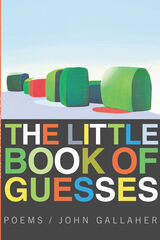 The Little Book of Guesses
John Gallaher
Four Way Books, 2007 The Little Book of Guesses takes place in a 21st-century world where we’ve “accustomed ourselves to our customized dogs” and “honed the idea of ideas there in the obstacle race / that’ll never catch up.” But while it’s a world we’re not unfamiliar with—“in the New Age tourism is the answer”—Gallaher’s turn of speech is at once unique and exact, making the familiar strange and the strange familiar. Serving as our escort through scenes including “The War President’s Afternoon Tea” and “A Moment in the Market of Moments,” Gallaher offers us several guidebooks: “to the Afterlife,” “to When Things Were Better,” and a “Pocket Guide to Some Foreign Country.” Even as these poems guess, they are confident in the form and lyricism. Abundant with comedy, they contain more than a dose of irony and cynicism, and still find room for the quiet anger of frustration, of knowing that what seems most surreal about this world often turns out to be reality itself.
The Little Bulbs: A Tale of Two Gardens
Elizabeth A. Lawrence
Duke University Press, 1986 “A beautifully written book.”— The Garden Journal“A few garden writers offer prose that goes beyond how to spade and spray to convey the experience and pleasures of gardening. The late Elizabeth Lawrence was such a writer.”—Southern Living “First published in 1957 and out-of-print for many years, this is a delightfully written and enormously informative introduction to the fascinating variety of little bulbs available to the gardener. The author discusses a wide variety of plants, both familiar and little-known, including crocuses, species daffodils, hardy cyclamen and lily-family members such as Brodiaea, Bessera, and Calochortus.”—American Horticulturist
Little Caesar
Edited, with an introduction by Gerald Peary; Tino T. Balio, Series Editor
University of Wisconsin Press, 1981 Little Caesar, a 1931 Hollywood gangster classic, is viewed in revivals today with nearly as much audience enthusiasm as it enjoyed a half-century ago, in the depths of the Great Depression.
In general, the Hollywood film industry responded to the dark economic conditions of the 1930s with escapist and non-topical films. The fascinating exception was the gangster film, through which the studios joined in the debate over the spiritual and economic health of the nation. Little Caesar, considered by many to be an architype of the genre, is one of the most memorable dramatizations of the discontent and alienation, the deep anxiety and hostility shared by millions of Americans during those dark years.
The Little Carthaginian. Pseudolus. The Rope
Plautus
Harvard University Press, 2012 Funny happenings.
The rollicking comedies of Plautus, who brilliantly adapted Greek plays for Roman audiences ca. 205–184 BC, are the earliest Latin works to survive complete and are cornerstones of the European theatrical tradition from Shakespeare and Molière to modern times. This fourth volume of a new Loeb edition of all twenty-one of Plautus’ extant comedies presents The Little Carthaginian, Pseudolus, and The Rope with freshly edited texts, lively modern translations, introductions, and ample explanatory notes.
Little Common Ground: Arab Agriculture and Jewish Settlement in Palestine, 1920-1948
Charles S. Kamen
University of Pittsburgh Press, 1991 Arabs and Jews have disputed the ancient lands of Palestine since the late nineteenth century, when Jews began emigrating there, buying land, and establishing farms, settlements, and businesses. In this book, Kamen examines the structure of Arab Palestine between the two world wars. He contrasts British and Israeli analyses against real world social and economic conditions of rural Arab society.
The Little Community and Peasant Society and Culture
Robert Redfield
University of Chicago Press, 1989 This volume combines two classic works of anthropology. The Little Community draws on the author's own notable studies of the villages of Tepoztlan and Chan Kom to explore the means by which scientists try to understand human communities. It contains, wrote Margaret Mead, "the essence of Robert Redfield's multifaceted contributions to the place of community studies in social science." Peasant Society and Culture outlines a speculative foundation for the emergence of anthropology from the study of isolated primitive tribes.
little dark
Karen Brennan
Four Way Books, 2014 little dark is a hybrid collection of poems and prose threaded together by an act of memoir. Here Brennan ruminates about “being” in the world, about her particular “self” through the tiny, distorted and often occluded aperture of memory. These poems have as their obsession “seeing” and “looking” and the failure of these acts to reveal anything definitive about our lives; instead little dark affirms mystery, the dissolution of boundaries between the seen and unseen (or forgotten) world.
 The Little Database: A Poetics of Media Formats
Daniel Scott Snelson
University of Minnesota Press, 2025 A poetics for reading the everyday objects that populate a hard drive
Bespoke online archives like PennSound and Eclipse host an astounding array of “old media” artifacts, posing a handcrafted counterpoint to the immense databases aggregated by digital titans like Google and Facebook. In The Little Database, Daniel Scott Snelson argues for the significance of these comparatively “small” collections, exploring how digital archives dramatically transform the artifacts they host and how they might help us better understand our own private collections in turn. Examining curated collections such as Textz, UbuWeb, and the Electronic Poetry Center, Snelson explores media-specific works by poets and artists, including William Carlos Williams, Tracie Morris, bill bissett, Nam June Paik, and Vicki Bennett. He develops creative tools and contingent methods for reading cultural data, whether found on the internet or in our own collections of TXT, JPG, MP3, and MOV artifacts, presenting case studies to show how these objects have come to find revised meaning in their digital contexts. Along the way, experimental poetic interludes give readers practical entry points into the creative practice of producing new meanings in any given little database. Inventive and interdisciplinary, The Little Database grapples with the digitized afterlives of cultural objects, showing how the past is continually reconfigured to shape the present. It invites readers to find playful and personal means for unpacking their own data collections, in the process discovering idiosyncratic ways to explore and connect with digital archives. Retail e-book files for this title are screen-reader friendly with images accompanied by short alt text and/or extended descriptions.
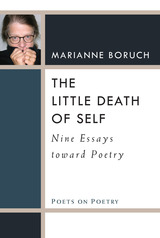 The Little Death of Self: Nine Essays toward Poetry
Marianne Boruch
University of Michigan Press, 2017 A volume in the Poets on Poetry series, which collects critical works by contemporary poets, gathering together the articles, interviews, and book reviews by which they have articulated the poetics of a new generation.
The line between poetry (the delicate, surprising not-quite) and the essay (the emphatic so-there!) is thin, easily crossed. Both welcome a deep mulling-over, endlessly mixing image and idea and running with scissors; certainly each distrusts the notion of premise or formulaic progression. Marianne Boruch’s essays in The Little Death of Self emerged by way of odd details or bothersome questions that would not quit—Why does the self grow smaller as the poem grows enormous? Why does closure in a poem so often mean keep going? Must we stalk the poem or does the poem stalk us until the world clicks open?
Boruch’s intrepid curiosity led her to explore fields of expertise about which she knew little: aviation, music, anatomy, history, medicine, photography, fiction, neuroscience, physics, anthropology, painting, and drawing. There’s an addiction to metaphor here, an affection for image, sudden turns of thinking, and the great subjects of poetry: love, death, time, knowledge. There’s amazement at the dumb luck of staying long enough in an inkling to make it a poem at all. Poets such as Keats, Stevens, Frost, Plath, Auden, and Bishop, along with painters, inventors, doctors, scientists, composers, musicians, neighbors, friends, and family—all traffic blatantly or under the surface—and one gets a glimpse of such fellow travelers now and then.
The Little Field of Self
Doreen Gildroy
University of Chicago Press, 2002 Set in a castle and on its grounds in Brittany, The Little Field of Self is one long poem comprised of individual poems that articulate the essence of devotion and the conflict within the devoted. With surprising inventiveness and technical skill, and without ornamentation, self-consciousness, or self-display, Doreen Gildroy has forged an original poetic style that renders inner being authentically and convincingly.
Little Girls In Church
Kathleen Norris
University of Pittsburgh Press, 1995 Although Kathleen Norris’s best-selling Dakota: A Spiritual Geography has brought her to the attention of many thousands of readers, she is first and last a poet. Like Robert Frost, another poet identified with a particular landscape, she can reveal the miraculous in the ordinary, and she writes with clarity, humor, and deep sympathy for her subjects.
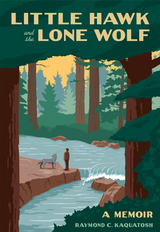 Little Hawk and the Lone Wolf: A Memoir
Raymond Kaquatosh
Wisconsin Historical Society Press, 2014 “Little Hawk” was born Raymond Kaquatosh in 1924 on Wisconsin’s Menominee Reservation. The son of a medicine woman, Ray spent his Depression-era boyhood immersed in the beauty of the natural world and the traditions of his tribe and his family.
After his father’s death, eight-year-old Ray was sent to an Indian boarding school in Keshena. There he experienced isolation and despair, but also comfort and kindness. Upon his return home, Ray remained a lonely boy in a full house until he met and befriended a lone timber wolf. The unusual bond they formed would last through both their lifetimes. As Ray grew into a young man, he left the reservation more frequently. Yet whenever he returned—from school and work, from service in the Marines, and finally from postwar Wausau with his future wife—the wolf waited.
In this rare first-person narrative of a Menominee Indian’s coming of age, Raymond Kaquatosh shares a story that is wise and irreverent, often funny, and in the end, deeply moving.
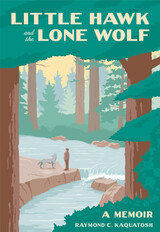 Little Hawk and the Lone Wolf: A Memoir
Raymond Kaquatosh
Wisconsin Historical Society Press, 2022 “Little Hawk” was born Raymond Kaquatosh in 1924 on Wisconsin’s Menominee Reservation. The son of a medicine woman, Ray spent his Depression-era boyhood immersed in the beauty of the natural world and the traditions of his tribe and his family.
After his father’s death, eight-year-old Ray was sent to an Indian boarding school in Keshena. There he experienced isolation and despair, but also comfort and kindness. Upon his return home, Ray remained a lonely boy in a full house until he met and befriended a lone timber wolf. The unusual bond they formed would last through both their lifetimes. As Ray grew into a young man, he left the reservation more frequently. Yet whenever he returned—from school and work, from service in the Marines, and finally from postwar Wausau with his future wife—the wolf waited.
In this rare first-person narrative of a Menominee Indian’s coming of age, Raymond Kaquatosh shares a story that is wise and irreverent, often funny, and in the end, deeply moving.
 Little Helpers: Harry Vaughan, His Cronies, and Corruption in the Truman Administration
John Robert Greene
University of Missouri Press, 2024 In Little Helpers, historian John Robert Greene encourages us to rethink the scandals of Harry Truman’s presidency by providing the first political biography of the man who precipitated them—Gen. Harry H. Vaughan. As the former president’s close friend and military aide, Vaughan brought a number of disreputable figures into the White House, in addition to committing plenty of misconduct on his own. Although aware of Vaughan’s misdeeds, Truman remained unwilling to rid his administration of him and his hangers on. Vaughan’s scandals have largely gone overlooked by historians—a tendency that Little Helpers corrects.
Greene begins with the story of how Truman and Vaughan met during World War I, then examines Vaughan’s support for Truman for the Senate and later as President. The majority of the book, however, considers the various cronies that surrounded Vaughan and illustrates the significance of his relationship with Truman—and the president’s inability to rein him in.
Drawing from primary and archival sources, many never before published, Little Helpers is further distinguished by its use of the correspondence between Vaughan and Truman. Greene also provides a dramatic narrative account of the inner workings of the Truman administration, making the book accessible to the general reader as well as the specialist.
A Little History of Photography Criticism; or, Why Do Photography Critics Hate Photography?
Susie Linfield
University of Chicago Press, 2010 In A Short History of Photography Criticism; or, Why Do Photography Critics Hate Photography?, Susie Linfield contends that by looking at images of political violence and learning to see the people in them, we engage in an ethically and politically necessary act that connects us to our modern history of violence. For many years, Linfield’s acute analysis of photographs—from events as wide-ranging as the Holocaust, the Chinese Cultural Revolution, and recent acts of terrorism—has explored a complex connection between the practices of photojournalism and the rise of human rights ideals. By asking how photography should respond to the darker shadows of modern life, Linfield insists on the continuing moral relevance of photojournalism, while urging us not to avert our eyes from what James Agee once labeled “the cruel radiance of what is.”
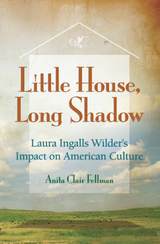 Little House, Long Shadow: Laura Ingalls Wilder's Impact on American Culture
Anita Clair Fellman
University of Missouri Press, 2008 Beyond their status as classic children’s stories, Laura Ingalls Wilder’s Little House books play a significant role in American culture that most people cannot begin to appreciate. Millions of children have sampled the books in school; played out the roles of Laura and Mary; or visited Wilder homesites with their parents, who may be fans themselves. Yet, as Anita Clair Fellman shows, there is even more to this magical series with its clear emotional appeal: a covert political message that made many readers comfortable with the resurgence of conservatism in the Reagan years and beyond. In Little House, Long Shadow, a leading Wilder scholar offers a fresh interpretation of the Little House books that examines how this beloved body of children’s literature found its way into many facets of our culture and consciousness—even influencing the responsiveness of Americans to particular political views. Because both Wilder and her daughter, Rose Wilder Lane, opposed the New Deal programs being implemented during the period in which they wrote, their books reflect their use of family history as an argument against the state’s protection of individuals from economic uncertainty. Their writing emphasized the isolation of the Ingalls family and the family’s resilience in the face of crises and consistently equated self-sufficiency with family acceptance, security, and warmth. Fellman argues that the popularity of these books—abetted by Lane’s overtly libertarian views—helped lay the groundwork for a negative response to big government and a positive view of political individualism, contributing to the acceptance of contemporary conservatism while perpetuating a mythic West. Beyond tracing the emergence of this influence in the relationship between Wilder and her daughter, Fellman explores the continuing presence of the books—and their message—in modern cultural institutions from classrooms to tourism, newspaper editorials to Internet message boards. Little House, Long Shadow shows how ostensibly apolitical artifacts of popular culture can help explain shifts in political assumptions. It is a pioneering look at the dissemination of books in our culture that expands the discussion of recent political transformations—and suggests that sources other than political rhetoric have contributed to Americans’ renewed appreciation of individualist ideals.
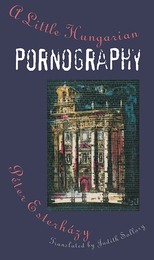 A Little Hungarian Pornography
Peter Esterhazy
Northwestern University Press, 1997 An extraordinary montage of sex and politics, Péter Esterházy's innovative novel can be seen to prefigure the liberation of Eastern Europe. Written under what the author calls "small, Hungarian, pornographic circumstances," A Little Hungarian Pornography exists in a context of official falsehood and misinformation, of lies of the body, the soul, and the state, perpetuated in the duality of language.
In a state where the lack of democracy was called socialist democracy, economic chaos a socialist economy, and revolution an anti-revolution, the notion of speech and obscenity becomes equally distorted and skewed. Under these circumstances, the author considers the shackles inherent in the vocabulary of oppression and contrasts this with the freedom of the body in sex. A kaleidoscopic digression on perversion and politics, A Little Hungarian Pornography is both satire and critique, trifle and tract, and further support for Esterházy's status as one of the best writers in Europe today.
|
|
